Welcome to the best explanation of Perfect Blue available on the internet. This article will analyze, calculate, disentangle and decode all of the essential details required to understand the deeply nuanced and convoluted story of Perfect Blue. What happened? Why did it happen? What did any of it mean? This article contains all of the answers.
If you loved this movie and you’re wondering what to watch next, then check out our list of movies like Perfect Blue.
The cast of characters
Before we get into the nitty-gritty of Perfect Blue, let’s get a refresher on the main characters of the movie that we’ll be talking about throughout this piece.
Mima
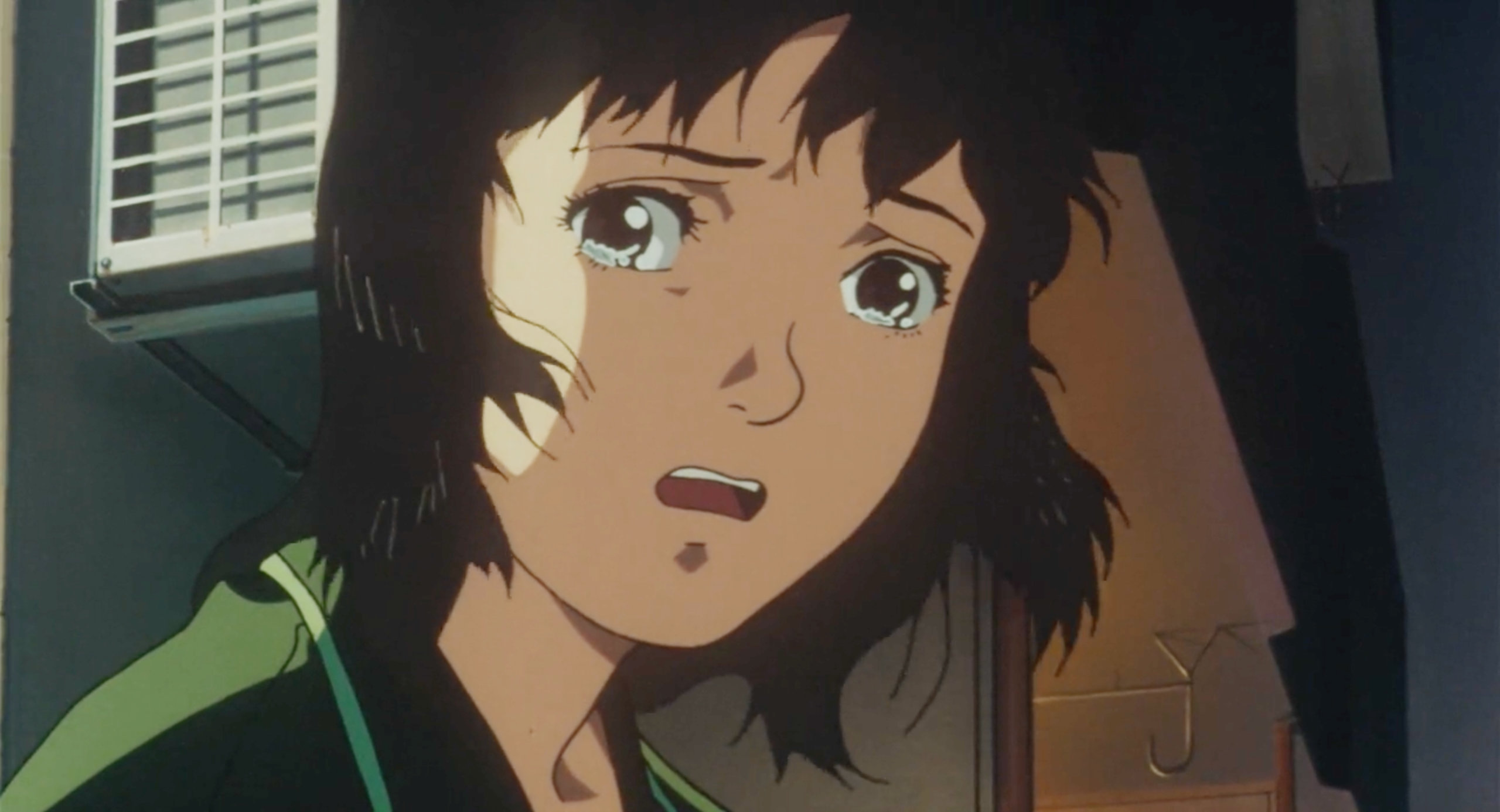
Our main character. Mima was one of the original three members of Japanese idol group CHAM! But she decides to depart from the trio and pursue an acting career. She’s excited to make the job change, but is also very timid and scared of failure. This causes her to doubt herself and her abilities. She constantly wonders if she’s made the wrong decision, and contemplates settling back into her “idol” persona. This leads to an Idol Mima persona that haunts her—both spiritually and physically. (More on that in a second.)
Me-Mania
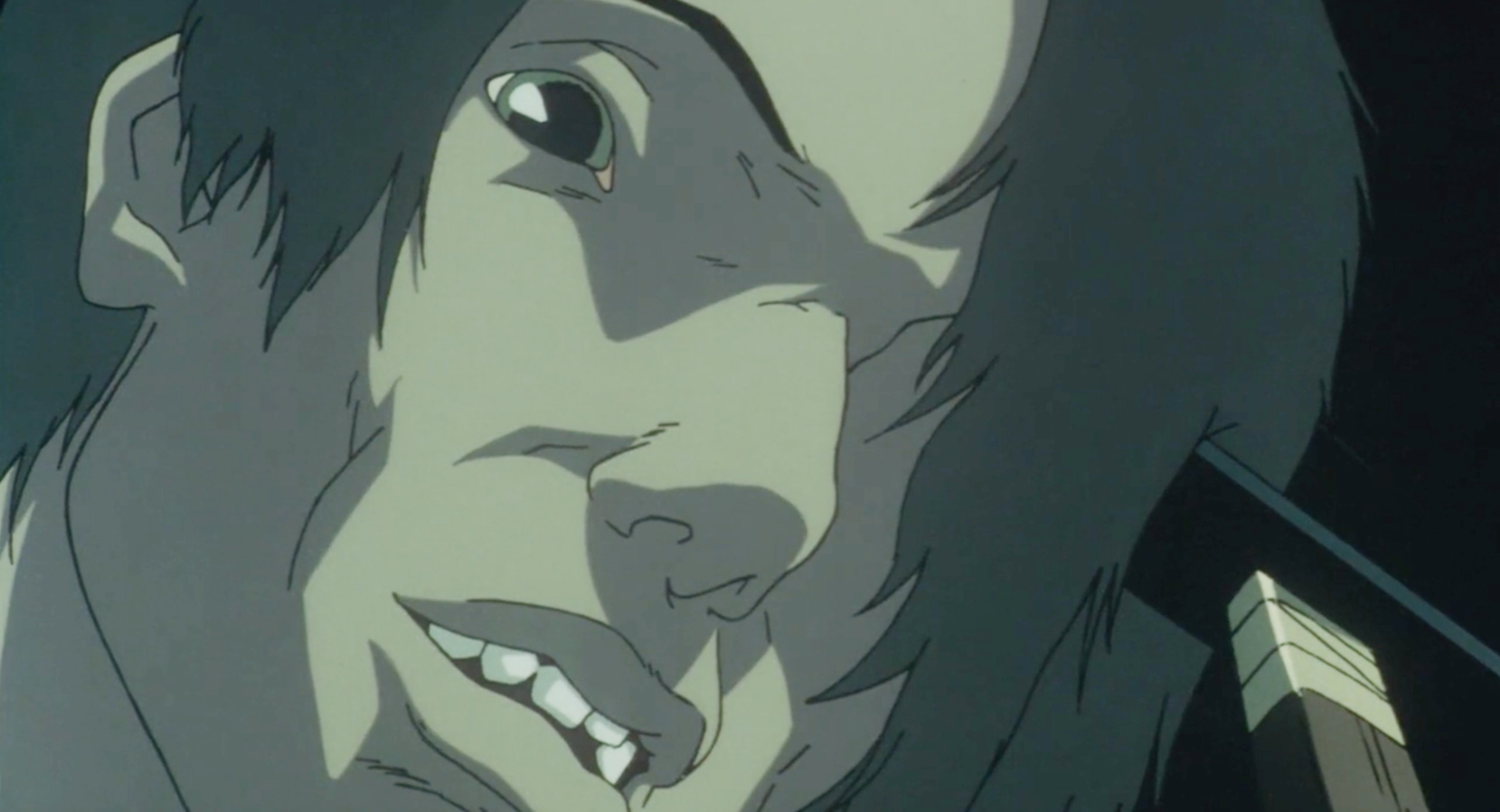
Me-Mania is a seemingly harmless fan of CHAM! Specifically, he seems drawn to Mima. What may seem innocent at first becomes very deranged and maniacal before long. He follows Mima from gig to gig and spends all of his free time in Mima’s Room, a website dedicated to tracking Mima’s every movement. He has pictures of Mima all over his room. As Mima pursues her acting career, Me-Mania grows more and more irritated that Mima has drifted away from her former idol self. This pushes him to become violent with Mima—especially when enticed by Mima’s manager, Rumi.
Rumi
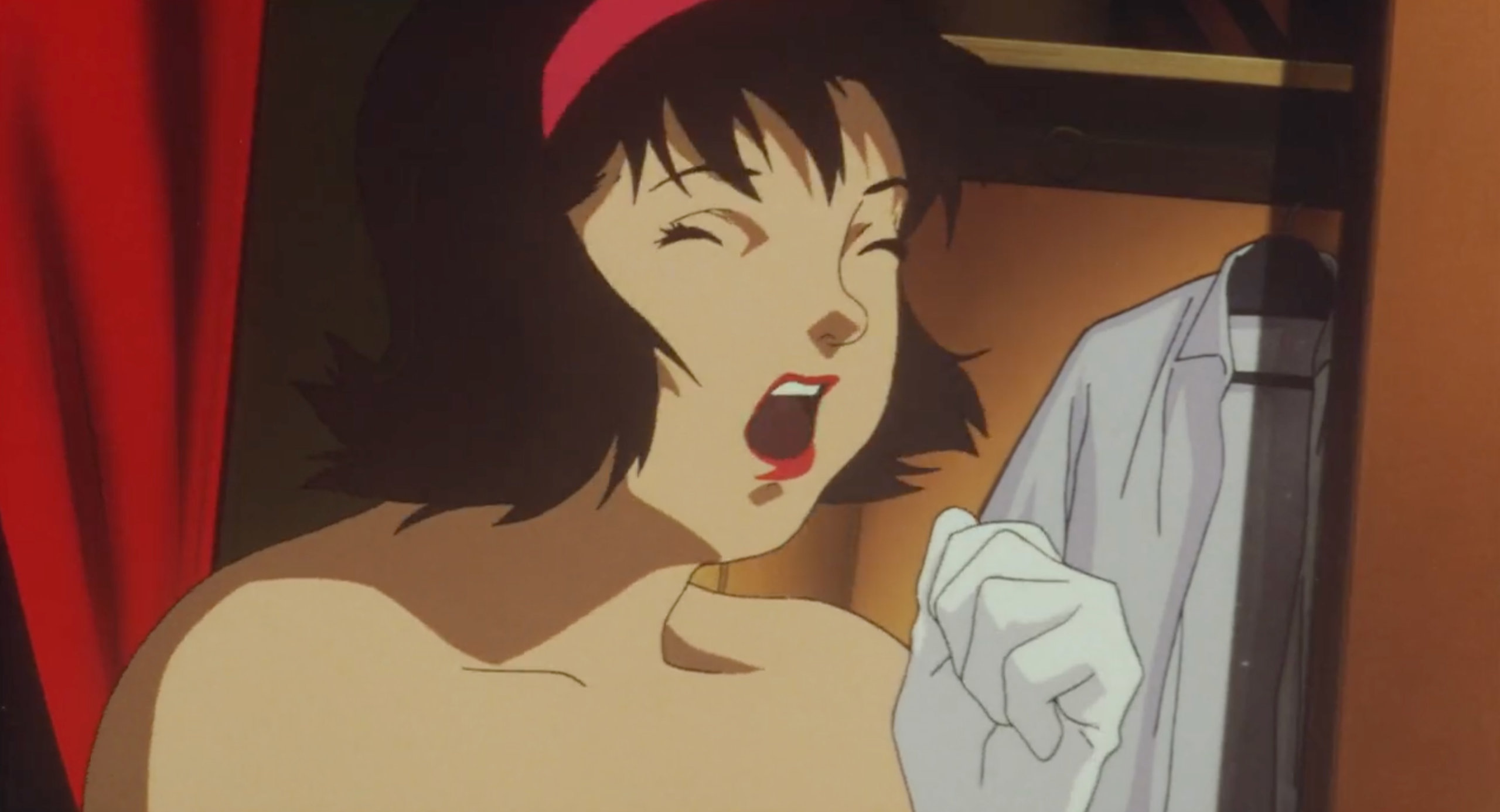
Rumi is the major curveball of Perfect Blue. In the beginning, she appears dedicated to protecting Mima as her protege goes down a new career path. But really, Rumi is very upset that Mima is abandoning a persona that Rumi desperately wants for herself. Rumi is a former pop idol who grew out of the celebrity lifestyle and eventually transitioned to managing entertainers. Rumi relived her glory days by turning Mima into a pop idol. But as soon as Mima abandons that life, Rumi starts to lose her grip on reality. To cope, she starts the Mima’s Room blog and secretly communicates with Me-Mania to stop Mima from going down this new path. Eventually, Rumi becomes so removed from reality that she begins to dress up as Mima. Which brings us to…
Idol Mima
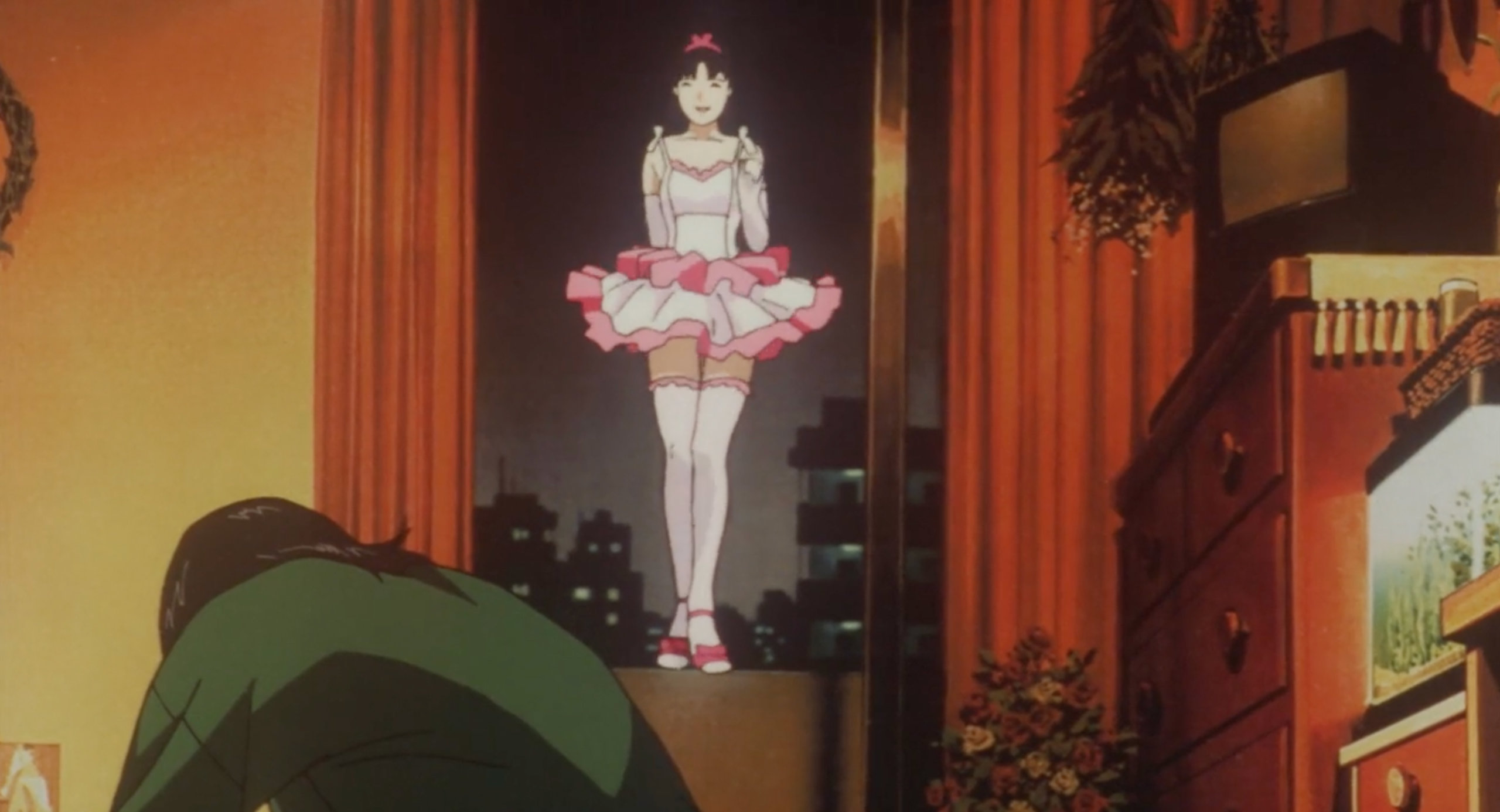
Idol Mima exists in two different forms. First, there is the virtual version of Mima that appears to the real Mima on various occasions. At first, Mima puts on a strong face as she struggles through her new acting career. But after a r*pe scene cripples her psychologically, Idol Mima begins to haunt the real Mima’s surroundings. Idol Mima progressively becomes more and more prevalent in Mima’s life, driving her to near insanity.
There’s also a physical version of Idol Mima on the loose—but really, it’s just Rumi. Rumi dresses up like Mima and poses as Mima on the blog. In a last-ditch effort to relive her idol days, Rumi literally becomes the version of Mima she wanted Mima to become.
Why is the movie called Perfect Blue?
The story of Mima Kirigoe was originally a novel, written in 1991 by Yoshikazu Takeuchi, called Perfect Blue: Kanzen Hentai. The subtitle can mean either “complete metamorphosis” or “total pervert” and refers to the novel’s dual exploration of Mima’s transformation and Me-Mania’s stalking. It’s a mostly straightforward tale that has the escalating terror and violence of an American slasher film.
When it came time to adapt the book into a movie, Takeuchi wrote a script for a live-action production. But the budget fell through, so the studio audibled to making an animated film instead. Satoshi Kon, who became the director of Perfect Blue, was only 34 years old at the time but a rising artist in the anime world. He got the nod to take over the project.
Kon read Takeuchi’s screenplay, hated it, and decided to re-write it. There were very few rules Kon had to follow: Mima had to stay an idol, there had to be a stalker and violence—and that’s it. With those things in mind, Kon and screenwriter Sadayuki Murai made sweeping changes. They used some names from the novel, but re-imagined almost everything about the characters themselves. Because of how different Kon’s version was, he considered a new title.
But in an interview with Andrew Osmond, Kon explained: “To be honest, I used [Perfect Blue] because it was the title of the original novel. I presume the words had some significance, but as I changed the story and probably the subject as well—I guess the meaning was lost. I can only guess because I didn’t read the novel. I simply read through the rough plot, which was described as ‘close to the original story’ in the project plan delivered to me. We discussed changing the title, but I liked it, it sounds significant and mysterious.”
So there you have it.
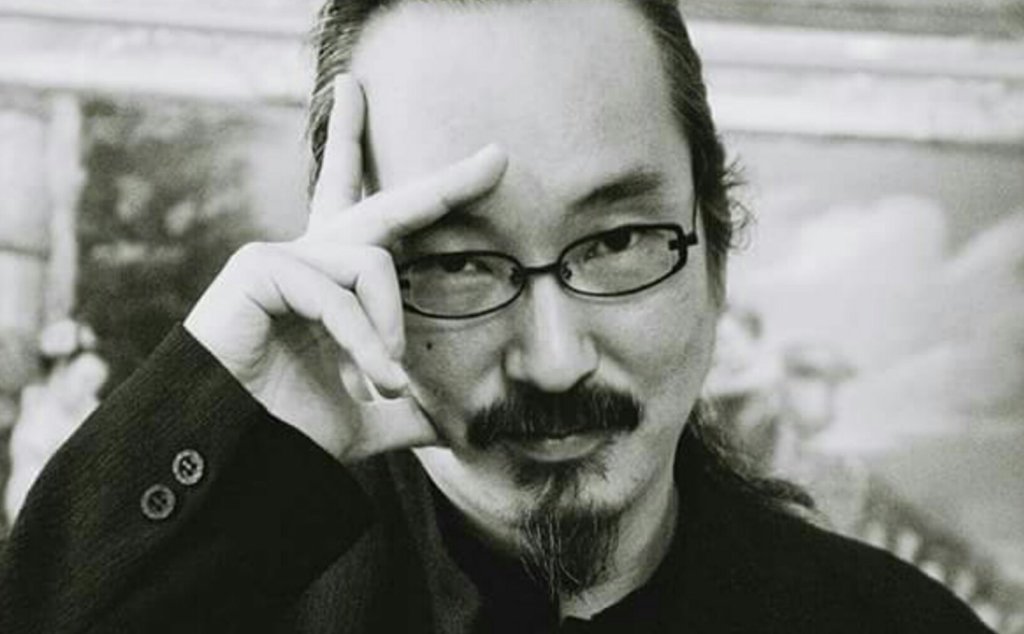
Kon had no specific reason for the title other than he liked the emotions it conveyed. The title does not play a significant role in our understanding of the film. Of course, individuals can create and discover their own interpretations of and applications for the title. It’s not devoid of meaning. But it’s not intentional in a way that’s relevant to our explanation and analysis of the plot and themes.
The word “perfect” does appear once. Near the end. When Rumi reveals herself as “Idol Mima.” She comes out of the kitchen singing the CHAM! song “Angel of Love.” When she finishes, she asks Mima, “What do you think? Perfect, huh?” Given how climactic a moment Rumi’s reveal is, having one of the two title words in the dialogue does feel intentional and relevant.
With that context in mind, you could try and argue that the phrase “Perfect Blue” has something to do with performance and the idea of perfection in performance. And the mental anxiety that comes with the pressure of perfection. The first words we hear Mima say in the entire movie are, “Don’t pressure me.” She then goes on to face a ton of pressure and have a pretty significant mental break.
The ending of Perfect Blue explained
The final scene of Perfect Blue finds Mima visiting a psychiatric hospital, bringing flowers to Rumi, and hearing an update from a doctor. Rumi still suffers from her personality disorder, continuing to believe she’s an Idol Mima, rarely “waking up.” We watch Rumi walk through the hospital, carrying the flowers. She ends up standing in front of a window, and we see Rumi see “Idol Mima” as her reflection. Mima tells the doctor that, despite everything, “Thanks to her, I am who I am today.”
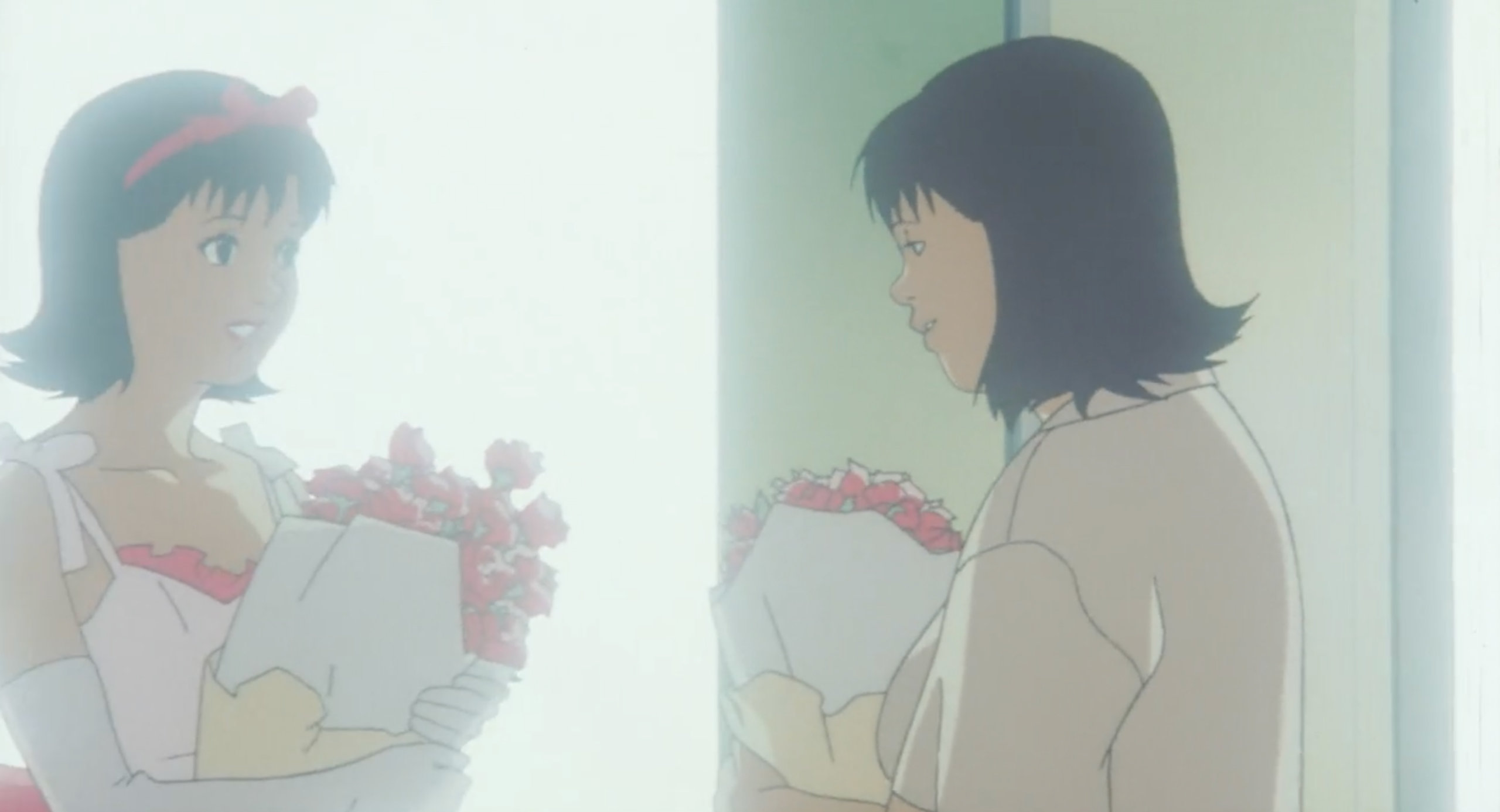
We cut to Mima leaving the hospital, passing two nurses who whisper about her. “There’s no way Mima Kirigoe would be here of all places.” “I guess she was just a look-alike.” From this we should take away that Mima’s fame has grown. She even looks more confident than ever before.
Mima gets into her car, looks in the rearview mirror, and proudly exclaims to herself, “No, I’m real!” The end. Roll credits.
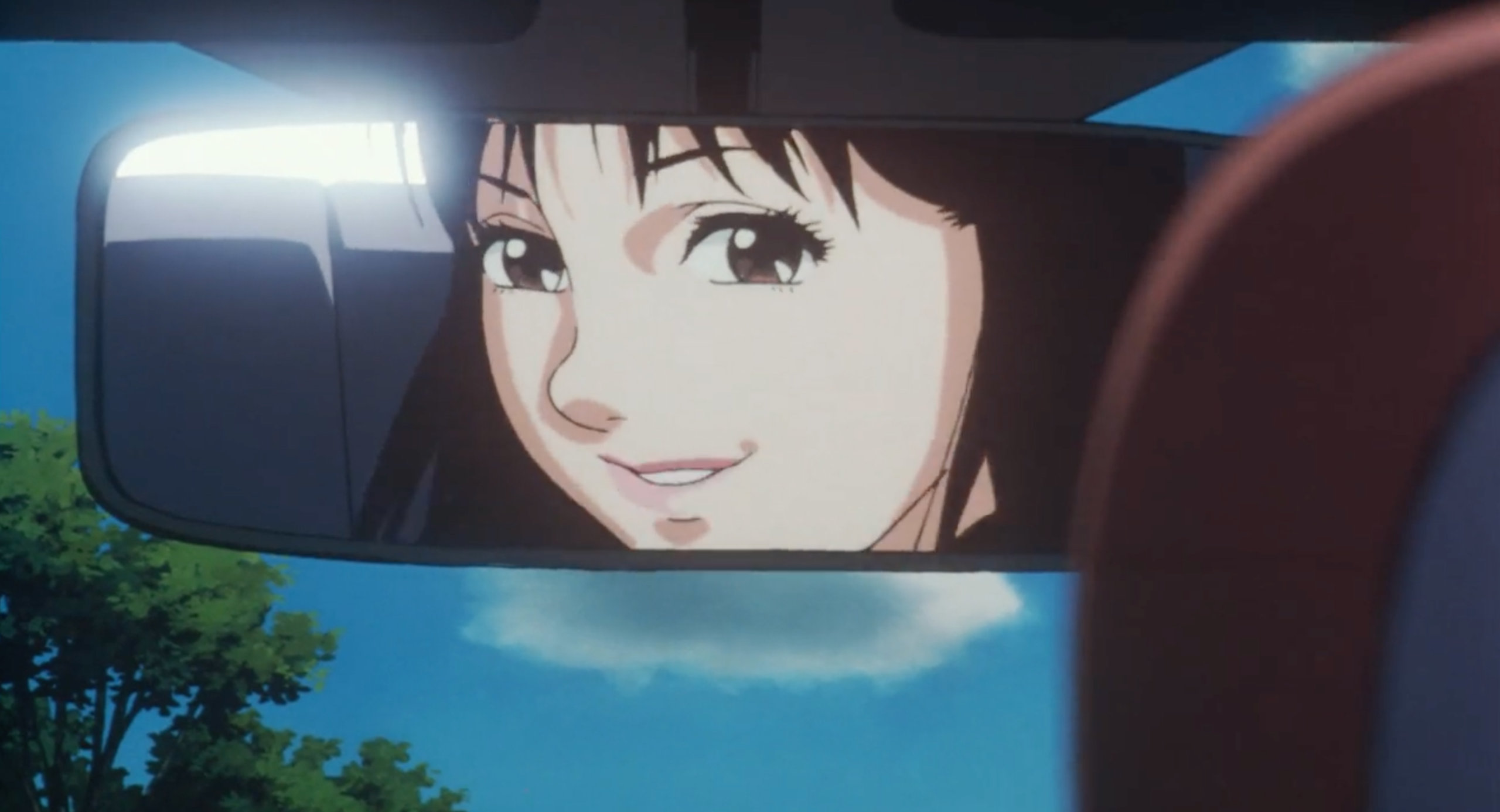
What can we take away from this?
The first thing to notice is the emphasis on identity. Mima is, at this point, confident in her identity. From telling the doctor she appreciates Rumi making her “who I am today” to smiling at herself in the rearview mirror and saying “No, I’m real!” Both Mima and Rumi end up looking in the mirror, but only one of them is in reality. Rumi is still lost in a dream, unable to be herself.
Perfect Blue reinforces the difference between the two through the “white light” visual (we write more about this motif in this part of the article). As Rumi walks, the windows behind her burn white. When she sees the Idol Mima reflection, the reflection is in that white void while Rumi is in front of a green wall. It’s a visual juxtaposition that symbolizes what we know about the character’s mental state.
In contrast, when Mima smiles in the rearview mirror, her face takes up most of the space. Over her shoulder, in the midground, the backseat of her car. Then in the background, there’s a sliver of that white light. That light has, throughout so much of the movie, represented stage lights and performance and poor mental health. It’s literally behind Mima, in the rearview mirror. While ahead of her, out the windshield, we see a mostly blue sky. It’s a similar use of symbolism as we saw with Rumi. Except reversed. Where Rumi had the fantasy ahead of her, reality behind her; Mima has reality ahead of her, fantasy behind her.
Another point of interest is that the scene, overall, resembles something we saw during the filming of Double Bind (that’s the TV show Mima stars in). There’s the scene where star actress Eri Ochiai, portraying psychiatrist Dr. Asamiya, explains Mima’s character has dissociative identity disorder. That “all those crimes took place when she was some other persona.” This dialogue happens as Eri and two other actors watch Mima’s character through a window. The Double Bind scene ends with Mima looking into the glass, seeing her reflection, and saying “That’s right. I’m an actress/model.”

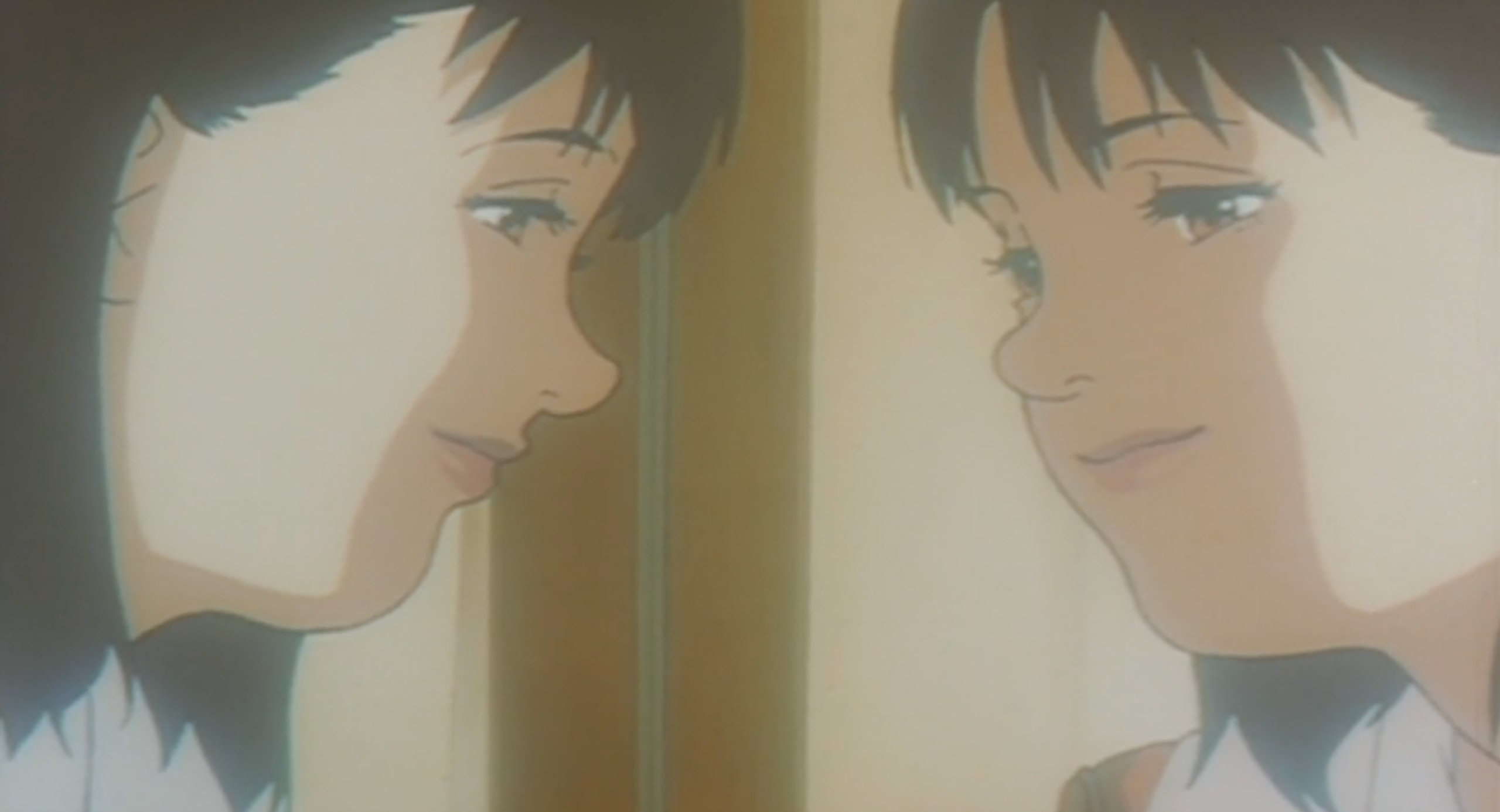
This scene is nothing more than a fantasy. It’s fiction. But it foreshadows the reality we get in the final scene, with Mima, now a famous actress like Eri, visiting the hospital, looking at Rumi through the window, while Rumi, suffering from dissociative identity disorder, gazes at her own reflection, convinced she’s someone she’s not.
So much of Perfect Blue actively tries to blend fantasy and reality, a function of Mima’s own struggle with telling the two apart. Her troubles literally warp the form of the movie. So it’s cool that Kon has his final scene first appear as part of Double Bind, because that means the final scene of Perfect Blue becomes closure to the dance between fiction and nonfiction. With Mima’s declaration of “I’m real!” serving as the exclamation point.
The timeline and synopsis of events in Perfect Blue
Before the movie begins
- Rumi is a pop idol, but eventually ages out, so becomes a manager to the next wave of idols.
- Rumi manages Mima and the rest of CHAM! to some success but not great success.
- Me-Mania idolizes Mima. He begins working as a security guard for CHAM!
- Mima’s agent, Tadakoro, sees more opportunity for Mima as an actress. Mima agrees, despite Rumi’s hesitation.
- Rumi, starting to suffer from her dissociative disorder, creates the “Mima’s Room” blog.
- Mima will have a final performance with CHAM!, then pursue her new career. Her first job as an actress is on a TV show called Double Bind.
After the movie begins
- Mima has her final CHAM! performance. Hecklers interrupt the show and Me-Mania tries to fight them.
- Mima receives threats from Me-Mania. First a call. Then a fax that labels her a traitor. Then, at the Double Bind set, Tadakoro opens a letter bomb with a note that says this was a warning. Her paranoia begins.
- Rumi introduces Mima to the “Mima’s Room” blog. It’s too specific, clearly the work of someone who is following her. Her paranoia escalates.
- Me-Mania hurts the main heckler from the final CHAM! performance.
- Mima goes to the agency. There she sees a newspaper clipping about a heckler from her last CHAM! concert being in critical condition after a hit-and-run. Immediately after reading the notice, Mima makes eye contact with Me-Mania. She begins to associate Me-Mania with violence.
- Mima agrees to a r*pe scene for Double Bind.
- On the train ride home, Mima sees Idol Mima for the first time, in a window reflection.
- The r*pe scene happens. Rumi leaves, crying in disgust. Mima also gets overwhelmed then fixes her attention on the overhead stage lights. She flashes to being on stage, as an idol.
- Off-screen: Rumi steals Mima’s fish and takes them to her version of Mima’s room.
- Transition via the burning white light.
- Mima comes home and thinks she sees her fish as dead. She breaks down, still emotionally distraught from filming the scene. Idol Mima appears in a reflection. Before the scene ends, we see the fish tank again. There aren’t any dead fish. Two live fish still swim around.
- Me-Mania becomes more and more unhappy with Mima’s loss of innocence.
- Another confrontation between Mima and Idol Mima (still in a reflection). Idol Mima speaks to the tarnished reputation of idols. All of the sudden, Idol Mima appears “in person” rather than just in reflection, declaring she’ll be in the light and Mima in the shadow.
- Rumi kills the Double Bind writer while a CHAM! song plays.
- Mima goes to the photographer who convinces her to take nude photos.
- The remaining two members of CHAM! perform. Mima joins them? Except maybe it’s Rumi as Mima?
- Mima is very unhappy after the photoshoot. Her mental health declines further.
- The magazine with the photos comes out. Me-Mania freaks out, obsessing about Mima’s tarnished reputation.
- It turns out Me-Mania and Rumi, pretending to be the real Mima, have been emailing every day. He promises Rumi that he’ll get rid of the fake Mima.
- Mima has hallucinations of Me-Mania following her, a sign of her deteriorated mental health and paranoia.
- Mima has a dream of chasing Idol Mima then getting hit by a truck driven by Me-Mania.
- Mima begins to lose track of time and reality. Falling into deja vu.
- Rumi kills the photographer who convinced Mima to take nude photos.
- Mima finds bloody clothes in her apartment.
- A further decline in Mima’s mental health. Viewers are, briefly, led to believe Mima is just crazy and Double Bind isn’t a TV show but the true reality of Perfect Blue.
- Double Bind finishes filming.
- Me-Mania attacks Mima. Mima manages to knock him out and escape. She briefly flashes back to an earlier Double Bind scene where her character killed someone in the exact spot she fights Me-Mania.
- Rumi kills Tadakoro. Then kills Me-Mania.
- Rumi finds Mima and drives her back to “Mima’s Room.”
- Rumi reveals herself as Idol Mima. She’s in a full-blown episode from her dissociative identity disorder and tries to kill Mima. A chase ensues, coming to an end when both women end up hit by a truck.
- Later, Mima visits Rumi at a psych hospital. Rumi still suffers from her delusions, but Mima has banished her own, finding closure and confidence.
Why does Rumi impersonate Mima?
The simple answer is Rumi suffered from undiagnosed dissociative identity disorder. It manifested in a belief she was the true Mima, leading to her attempt to eradicate the real Mima.
The more nuanced answer has to do with Perfect Blue’s commentary on identity. In his interview with Satoshi Kon, Andrew Osmond asked about Perfect Blue in relation to people “in the public domain: actors, politicians, even famous manga writers?” In other words: was Perfect Blue exploring the pressures faced by people with some degree of fame? To which Kon responded, “I think it is a problem everybody has, male or female, famous or anonymous. I mean, there’s a gap between the image people see of me and what I see myself. Perfect Blue is about the tragedy caused by that gap becoming too large.”
So the right answer isn’t as simple as “Perfect Blue is about the idol industry.” Or “Perfect Blue is about the pressures of fame.”
Both Rumi and Mima suffer from complicated perceptions of self. For Mima, it’s because she had only ever dreamed of being a singer and an idol, so the switch to acting was unforeseen and not intrinsically driven. A logical decision made out of business interests rather than an act of passion or genuine interest. She’s letting go of her childhood concepts of who she wanted to be and embracing a more adult perspective on her future and career. And that’s hard. Not everyone is ready for that change. And what we see her go through is a dramatization of coming to terms with the loss of self, in this case her childhood dream. This is why so much of her becoming an actress involves very challenging, mature moments. Kon used those trials that Mima faces as part of her journey into the complicated emotional world of being an adult. They’re extreme representations of growing pains most of us go through, challenges we don’t want to face but have to.
This coming of age story is similar to another beloved anime film, Spirited Away. In this Hayao Miyazaki classic, a little girl named Chihiro is in the car with her parents, moving to a new town. She’s unhappy and scared about everything unknown that awaits her. When the family gets lost, Chihiro and her parents look for help but accidentally stumble through the gates of a spirit realm. The parents transform into pigs, leaving Chihiro on her own in a strange world. At first, it’s hard for her, but then she stops acting like a child and takes control of her destiny, collecting information, getting a job, making friends and connections, and ultimately solving a number of challenging situations and saving her parents. The movie ends with everyone back in the car. Chihiro isn’t the same 10-year-old as before, completely confident about what awaits her, knowing she can handle anything.
The main difference between the two films is age. As Spirited Away ends up more of a children’s film and Perfect Blue is a long way from that. It’s not just the sexual content and violence that makes Perfect Blue more for adults. It’s Rumi.
Mima is a 21-year-old with her whole life ahead of her. But Rumi is older. The potential she believed in is gone. Her days of being an idol are long over. She didn’t get to pivot to another industry that would still bring her fame and attention. Instead, she settled into a labor-intensive behind the scenes role, one that meant helping women younger than her achieve their dreams. That’s not an easy transition to make. But it’s one all of us have to go through, at some point.
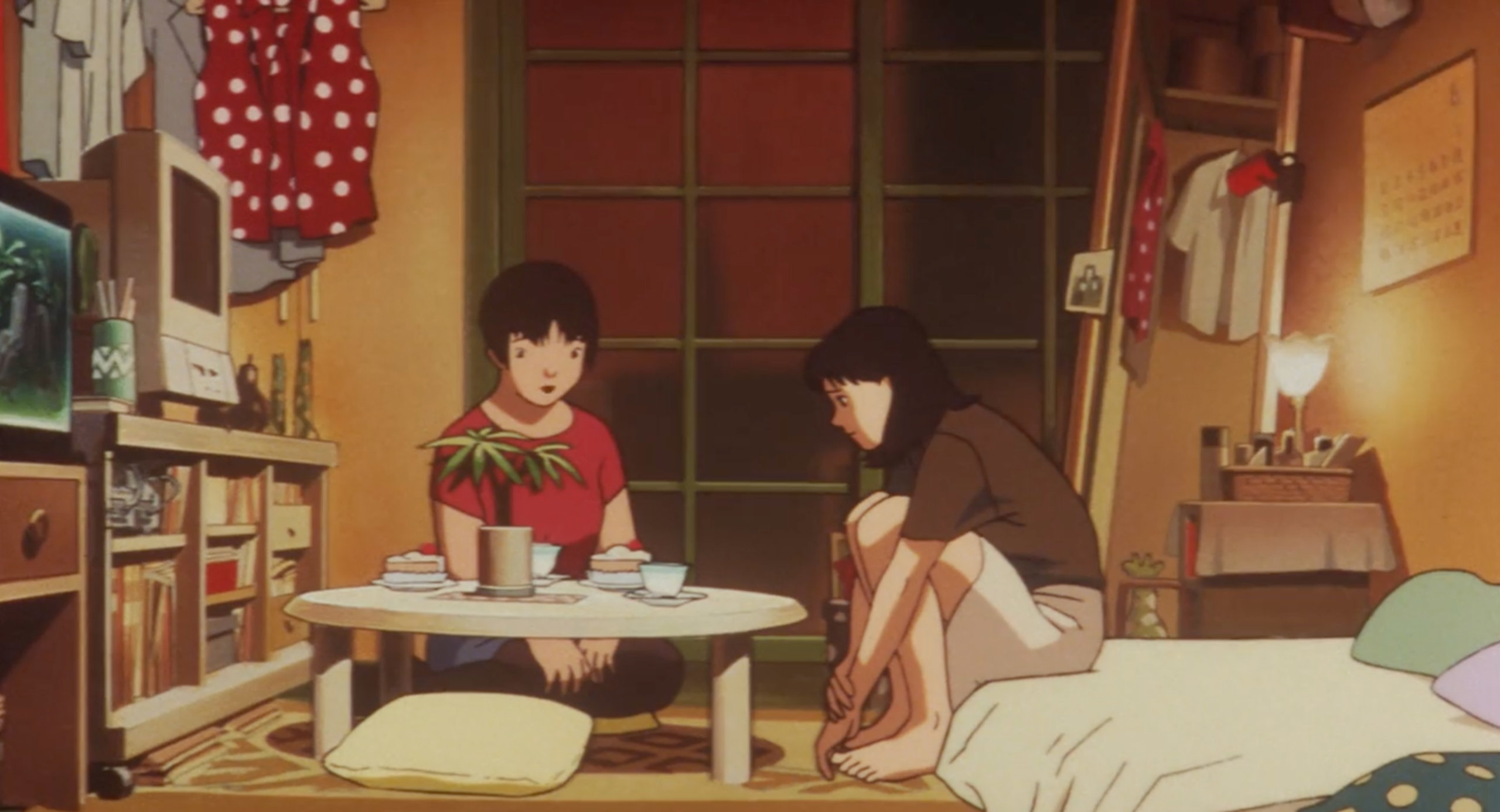
For most of us, our first taste of this is high school. You’re in this world for 4 years, then it ends. And you can never go back to it. But maybe you head into college. And you have another 4 years living in a microcosm. Then that blows up. Now you’re in your twenties, with so much opportunity and potential. But year by year, the opportunities reduce. The potential shrinks. Maybe you miss being on the high school basketball team. Maybe you miss being part of a campus choir. You miss seeing a group of friends every day. Maybe you dreamed of being a teacher but instead you’re in sales. Gaps start to form between the life you’re living now and the life you lived and the life you wanted to live. And that gets complicated.
Rumi can’t accept where she’s at in life. She sees herself as still being the cute, young idol. Not a manager. Not this older person who doesn’t have the same body or looks as before. It’s who she is but not who she wanted to be. That’s the gap Kon was talking about in that interview. And it’s something almost everyone has to deal with every single day—whether you are, as Satoshi Kon said, famous or anonymous. I’m sure all of us can think of celebrities who enjoy successful careers but struggle in their personal lives. Or friends and family who are happy in their personal lives but have careers they can’t stand. There’s almost always a gap. Most of us deal with it and find ways to stabilize the distance. Even if our life isn’t exactly what we imagined, we’re satisfied. But some can’t stabilize. The rift grows and gives birth to crisis.
Mima was on a similar trajectory as Rumi, which is why she also has “Idol Mima” visions that have nothing to do with Rumi. Ultimately, she’s able to recover and close the gap. But Rumi had no such luck. She fell into the void.
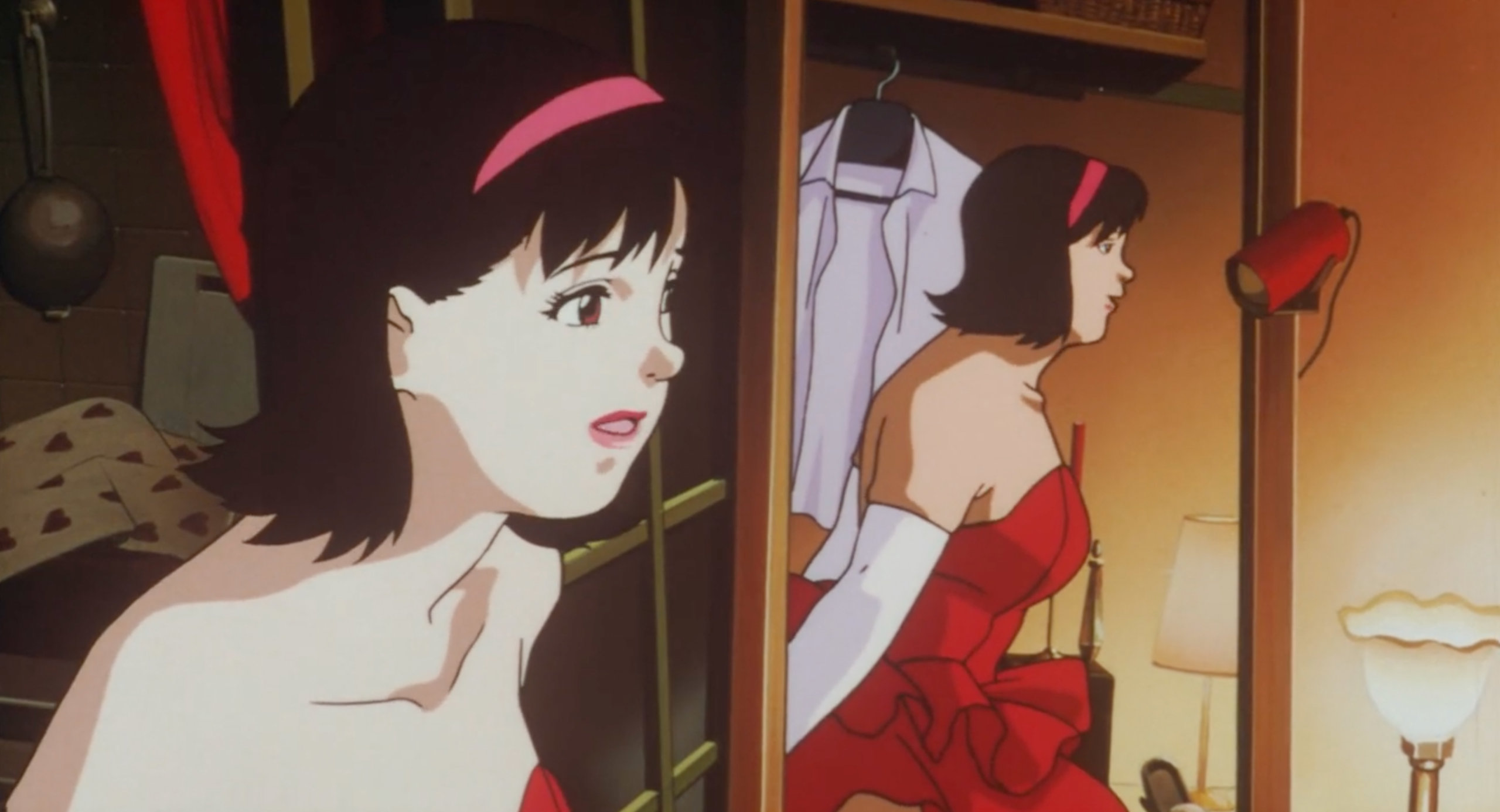
It’s an extreme example of what happens to people. But that’s what narrative art is for: to dramatize reality. That’s what makes it thrilling but also terrifying. Because it’s far enough from the truth to enjoy but close enough to trigger powerful reactions within us.
But why then does Rumi think she is Mima, specifically?
Why does Rumi think she’s Mima?
It seems that Rumi identified with Mima and shared a kind of motherly, or sisterly, relationship with her. They spent years together, working towards Mima’s goal of being a successful idol. It makes sense that Rumi would vicariously live through Mima. This is part of the symbiotic relationship between managers and artists. Mima’s success was Rumi’s success. Mima’s failure was Rumi’s failure. Since Rumi had already been an idol, it’s easy for her to imagine what Mima’s going through. To put herself in Mima’s shoes. To relive her own career through Mima.
When Mima decides to quit being an idol, it cuts Rumi off from her source of nostalgia. She can no longer live through Mima. In the regular world, Rumi would just manage another young idol. But that doesn’t make for a good or dramatic story. The dramatic version of events is that Rumi once again feels her dream of being an idol is slipping away. But she knows that she is too old to ever be an idol again. Rumi can’t do it. But Mima can. And Rumi had already invested so much of herself into Mima’s career—it felt like her own career. In so many ways, she saw herself in Mima. So that’s what her unhealthy brain latches onto: she’s Mima.
It starts off “harmlessly” with Rumi writing the Mima’s Room blog. But then it grows more and more serious as she becomes increasingly protective of Mima’s reputation. The less idol-like Mima acts, the more ownership Rumi feels of the “Idol Mima” identity. This leads to bouts of violence against those who affect Mima’s reputation: the screenplay writer, the photographer, Tadokoro. But it culminates with the final attack on Mima. The attempted eradication of “the other” in order to assume control once and for all.
Perfect Blue actually tries to explain this around the 55-minute mark. In a Double Bind scene, two characters have this conversation:
- Detective Yamashiro (Sakuragi): You mean the murderer is an illusion she created?
- Dr. Asamiya (Eri Ochiai): Yes. She fears an imaginary security guard and then doubles that figure with the serial murderer of top models.
- Detective Yamashiro: But illusions don’t kill.
- Dr. Asamiya: But…what if that illusion found someone to possess?
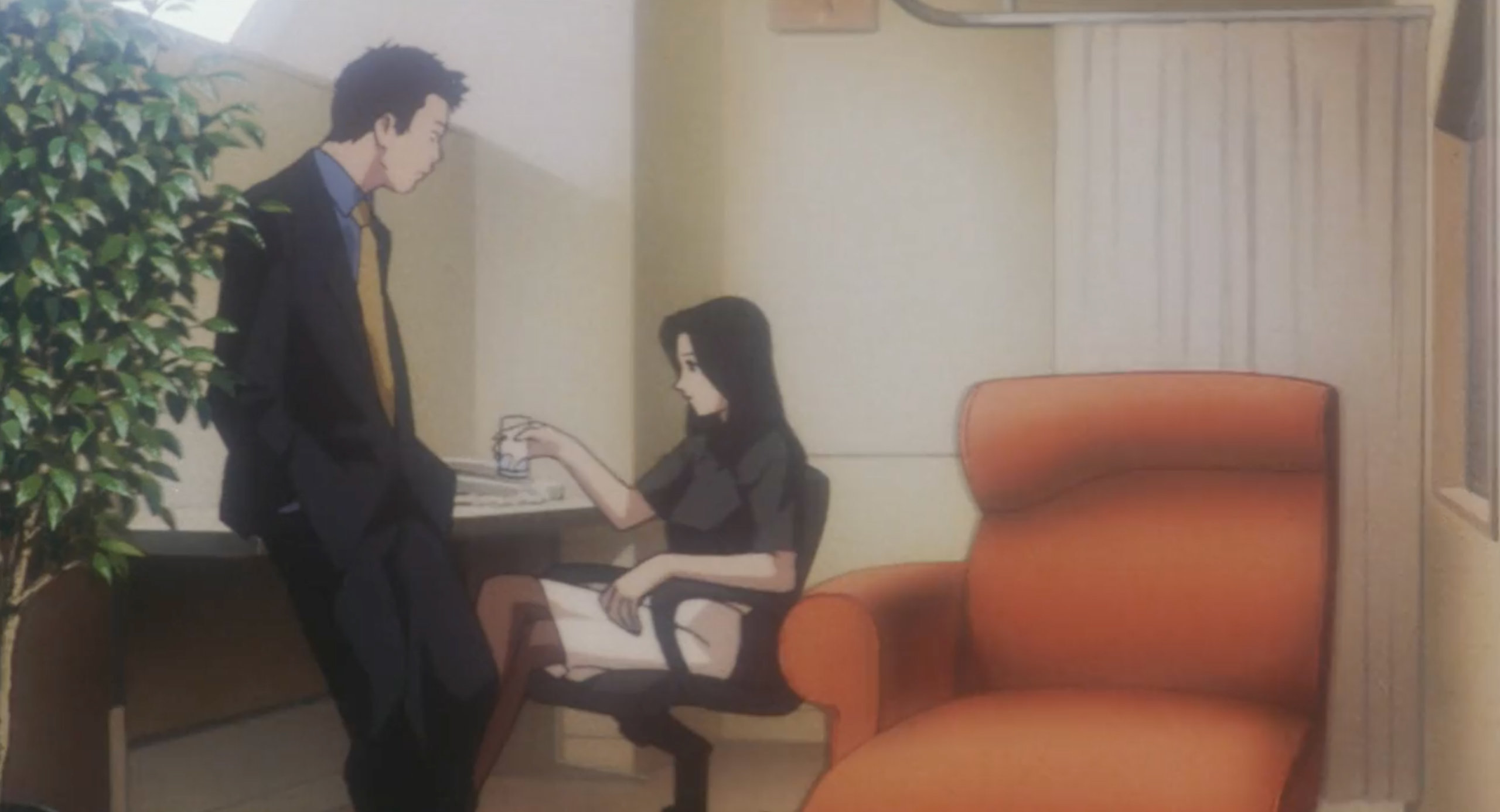
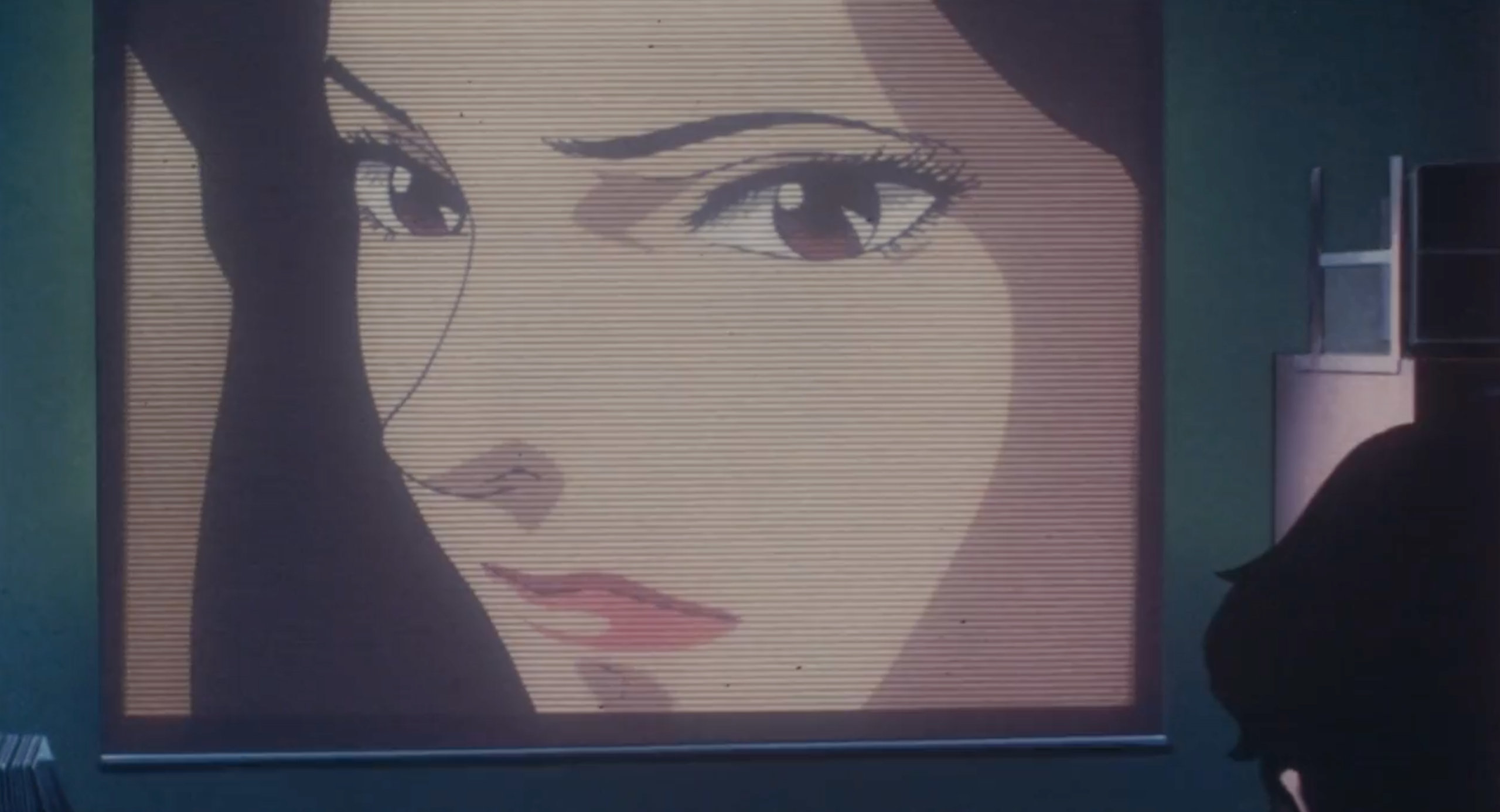
We then IMMEDIATELY cut to the sleazy photographer watching Double Bind, hearing this dialogue. What happens next? “Mima” appears and kills him. Except now we know it’s Rumi. Rumi “possessed” by the illusion of Idol Mima. Which means we can connect the dialogue from the Double Bind scenes with what’s happening to Rumi throughout the movie.
We’ll come back to the scene where the photographer is killed in a second. But first: do you remember the initial dialogue we hear in Double Bind? We hear this conversation between Yamashiro and Eri at the 14:49 mark:
- Dr. Asamiya: Do you know why the culprit peels off the skin of his victims?
- Detective Yamashiro: I assume he gets sexual stimulation from such activities…
- Dr. Asamiya: He wants to become one.
- Detective Yamashiro: Become… what?
- Dr. Asamiya: A woman… or…
So you have this combination of Rumi wanting to become something she’s not (an idol) and essentially getting possessed by the illusion of Idol Mima.
The cherry on top happens with the photographer. So let’s get back to that. We have the speech about possession. Then “Mima” shows up at the photographer’s place and kills him. As she stabs him repeatedly, we get a clear shot of Mima’s face. It’s her. Who else could it be?

Except at 57:24 there’s a shot of a mask hanging on a wall. But it’s not just any mask. It’s a traditional Japanese Noh. These masks have, for centuries, been used in Japanese theater productions. They’re characterized by fixed expressions that convey a single emotion and character. A sad woman. A happy child. An angry man. A single actor can wear multiple masks during a show, allowing them to play a range of characters, regardless of age and gender.
Combine that with what we know about the story. That Rumi is trying to become Mima. Wearing not just Mima’s idol clothes but even a Mima wig. Possessed by the illusion of Idol Mima, Rumi spends the film attempting to “peel off the skin” and become Mima. And that’s why we see Mima as the one killing the photographer. Because Rumi is, symbolically, wearing a mask of Mima’s face. Satoshi Kon tells us this through the image of the Noh mask.
Fittingly, Double Bind plays on the screen behind Rumi as she stabs the photographer. It’s not a TV, rather a projector casting the image onto the screen. Which means the image is also being projected onto Rumi. The shot is a close up of Mima. Meaning that Mima is literally getting projected onto Rumi. This visually reinforces everything we’ve been talking about regarding “peeling off the skin” and illusions possessing, and the Noh mask.
It’s an amazing moment and perhaps my favorite thing in the entirety of Perfect Blue.
And of course the scene ends with the flare of that intense white light that transitions us to Mima waking up in a shock.

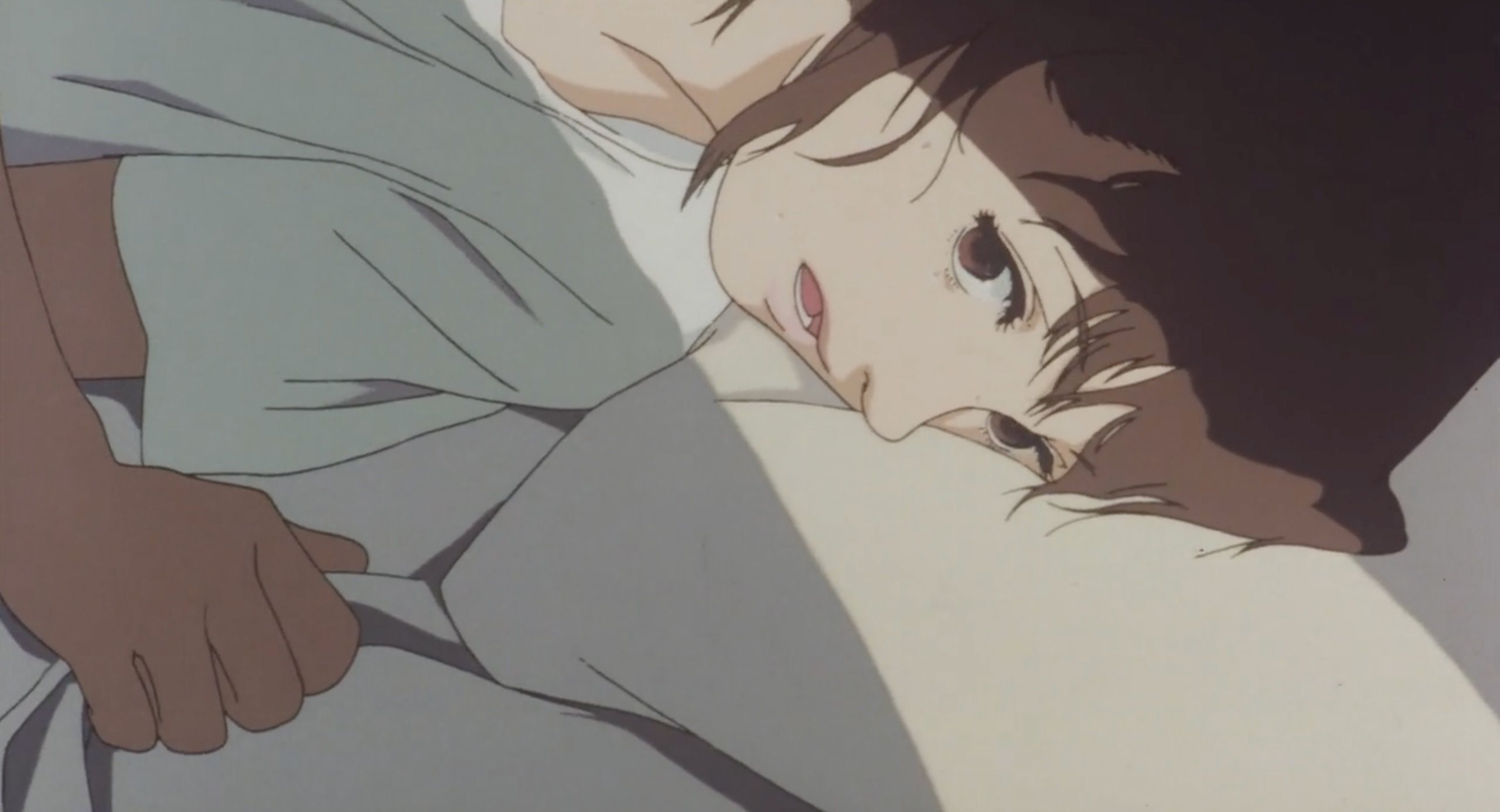
How Satoshi Kon tricks us
After the photographer attack, Mima wakes up, looking scared, and stares at her hands. On first watch, the prevailing reaction most viewers will have is that Mima is thinking about the death of the photographer. Maybe she thinks she dreamed the whole thing, except that it felt so real. Like she could still feel the knife in her hands.
But remember that Mima had hurt her hands just a few minutes earlier. During lunch with Rumi, Mima squeezes her tea cup so hard it shatters and cuts her hands up. They’re covered in blood. And we see her staring at them, perplexed, asking if the blood is real. She looks at her hands the same way she had after crushing the tea cup. That’s what she’s thinking about. “Was that real? Did I really hurt my hands yesterday?”
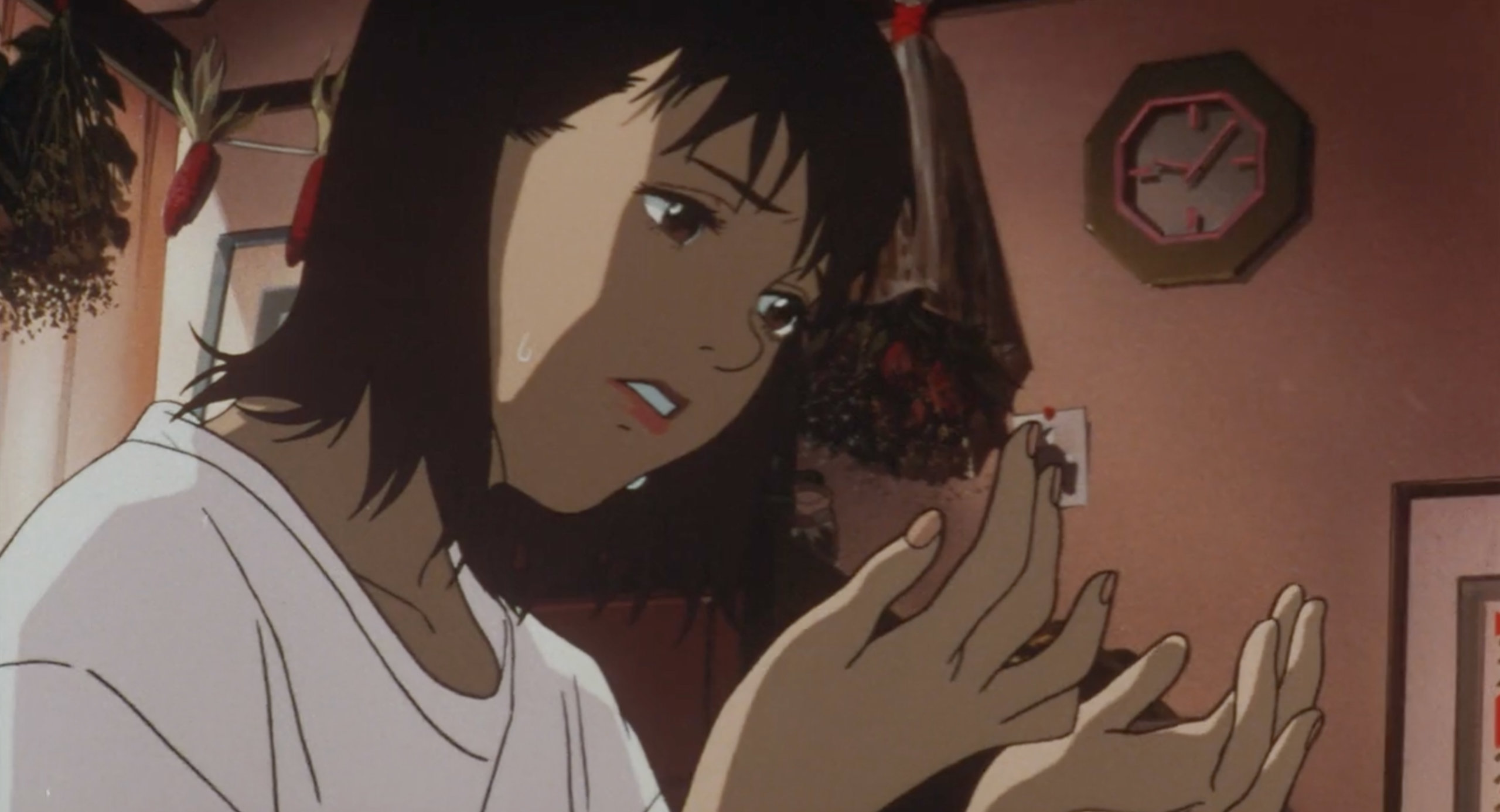
That’s the genius of Perfect Blue’s structure. Satoshi Kon took great pains to toy with the viewer so that we don’t know what’s what. We think she’s reacting to the photographer, but really it’s just a call back to something far less dramatic. That’s how Kon tricks us into the reveal that Mima’s not a killer. The things we thought of as clues weren’t clues at all. The beauty is that the tricks aren’t shallow. But are nuanced and meaningful in terms of bringing us to a similar state of paranoia and questioning our perception as Mima.
This isn’t the only time Kon refers back to an earlier scene. After finding out about the photographer, Mima arrives at the Double Bind set to film a scene where her character, go figure, has just slain someone. The victim lies on the circular stage where the earlier assault scene had taken place, a bit of a change in power dynamic. She’s to stand over the person, breathing heavily.
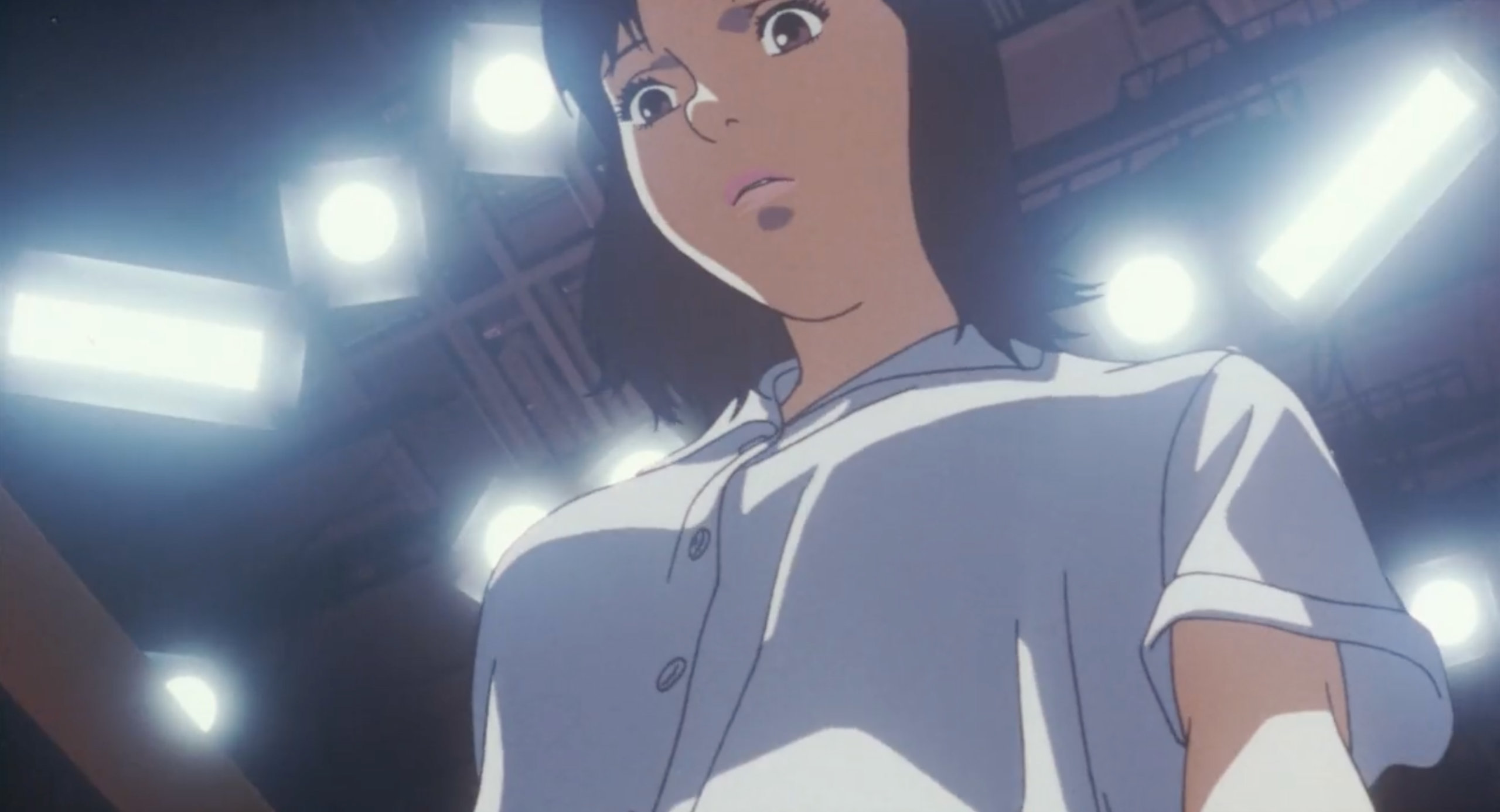
That scene ends with Mima enveloped by the stage lights and passing out. But later, she’s back in that exact spot after Me-Mania attacks her. When she hits him in the head with a hammer, he falls onto almost the exact spot as the victim from the scene we just talked about. As Mima stares at Me-Mania, we cut back to the Double Bind set, with the rest of the cast and crew applauding Mima’s performance. That moment seems out of the blue. But it’s actually a continuation of the scene in Double Bind where she’s just murdered someone.
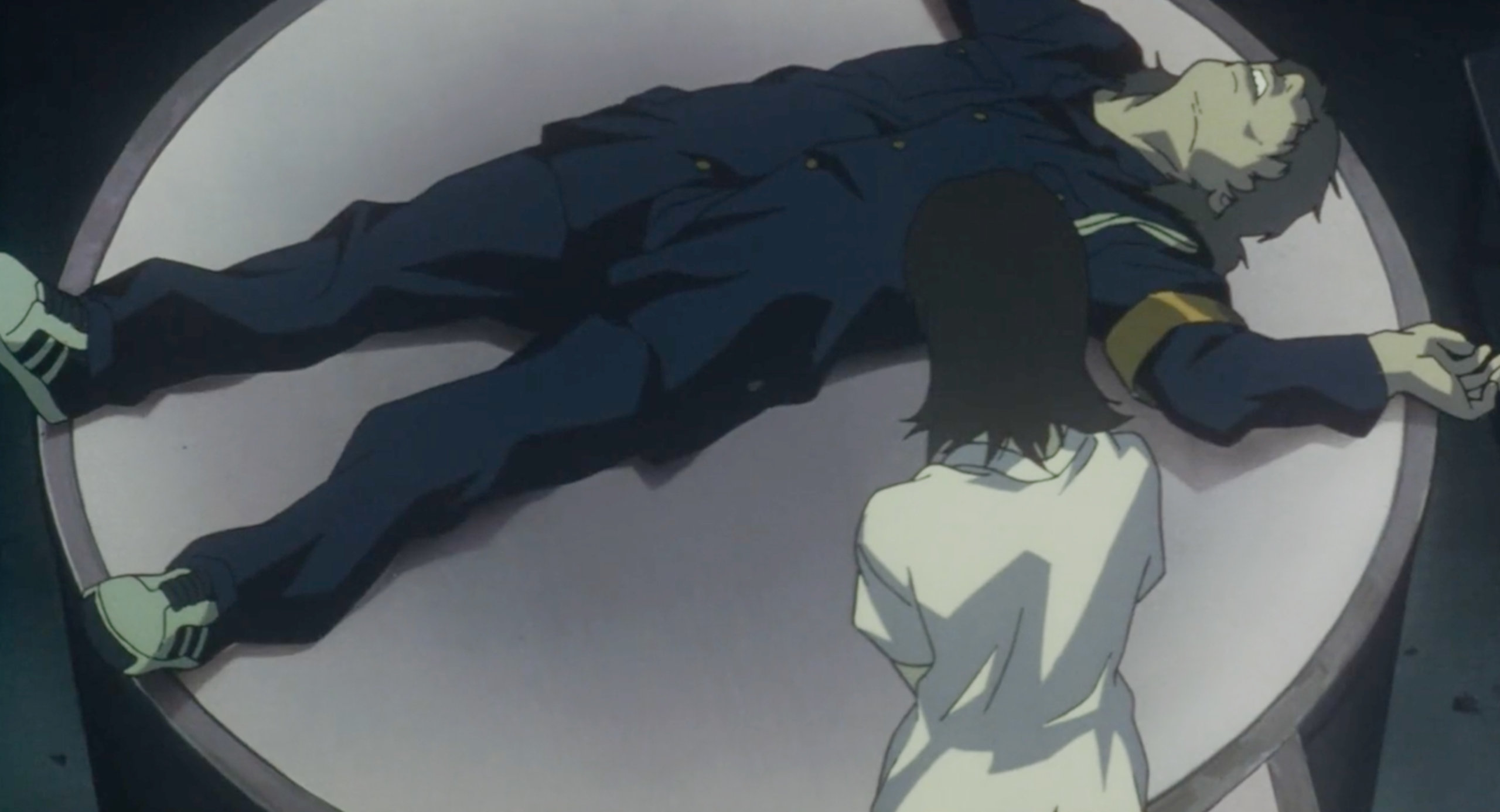
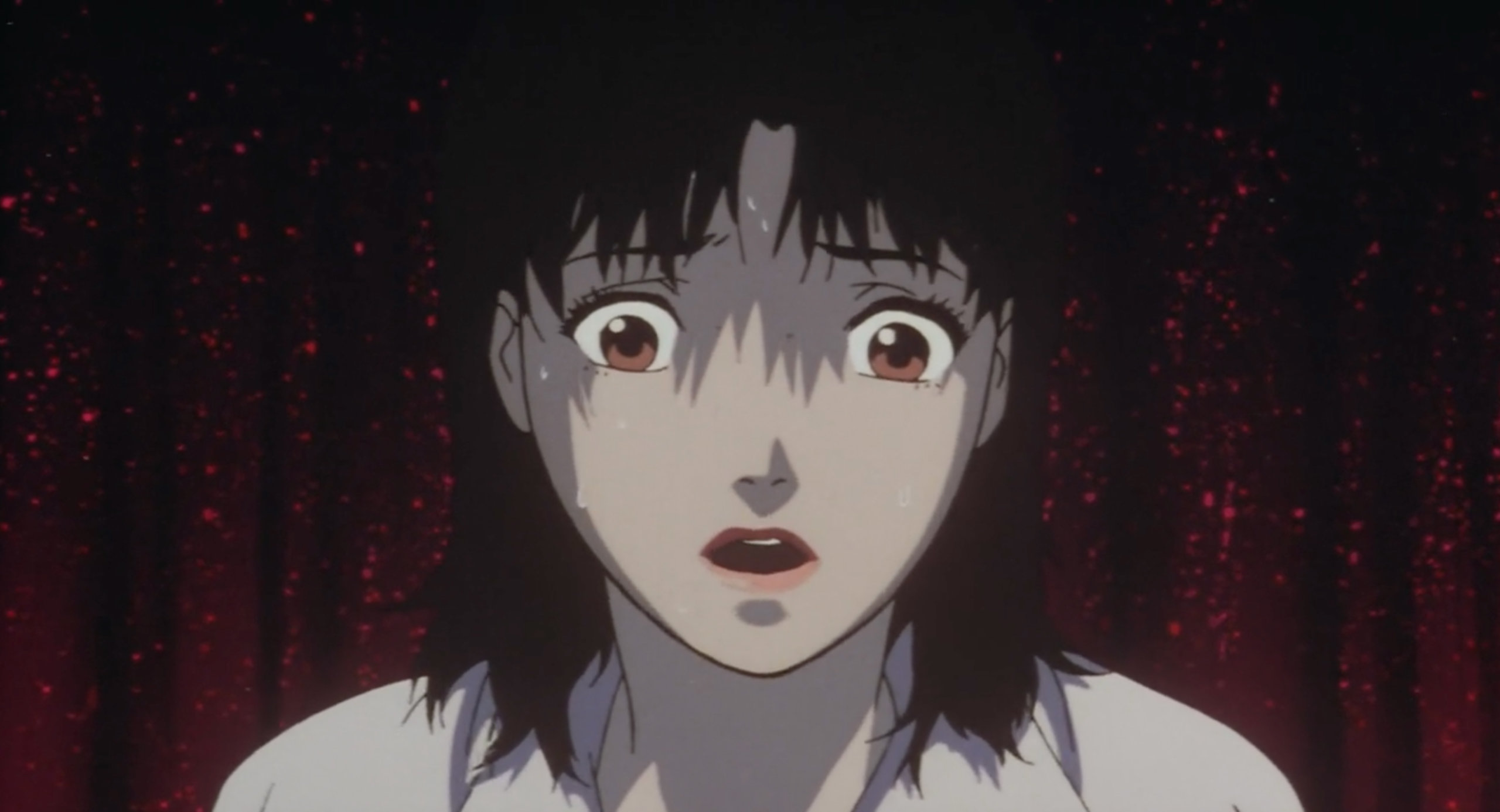
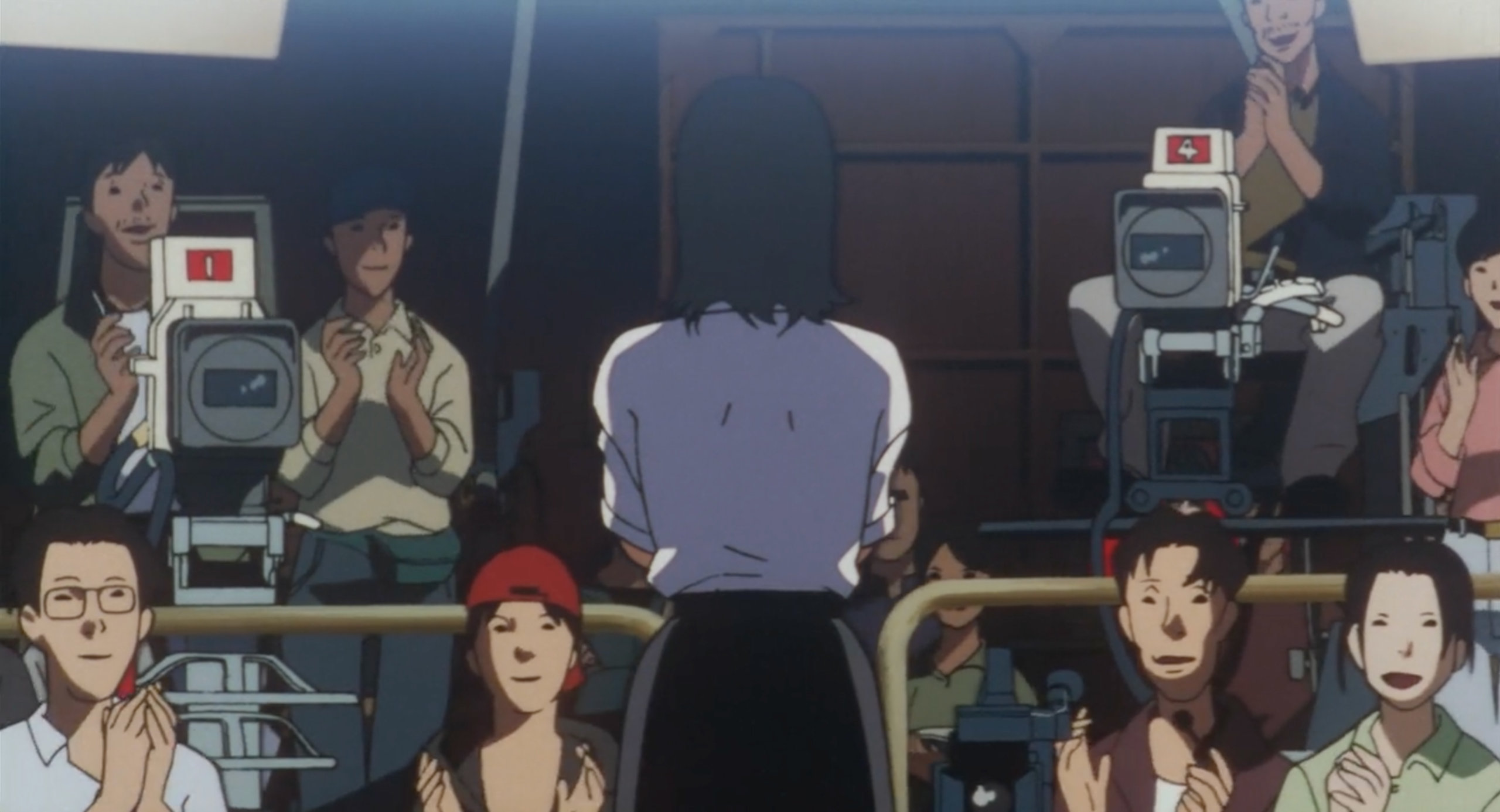
What connects the two is that the director of Double Bind had told Mima: “Breathe harder than during rehearsal. You’ve just killed someone.” In that initial moment, we see her start to breathe quickly but as the director yells cut she passes out. But after cracking Me-Mania in the head and standing in the exact same spot she was standing in the murder scene, she reacts by nearly hyperventilating. It’s the heavy breathing the director wanted. Which is why we cut back to the murder scene. It’s almost like Mima had channeled her encounter with Me-Mania, even though it hadn’t happened yet. But what’s more likely is that she just recalled filming the scene and we see her having that memory and how real it felt in that moment.
Regardless, it’s something that Perfect Blue does a number of times: show us something, then refer back to it a few minutes later but in a way that challenges our perception of what Mima’s responding to and what events happened and didn’t happen. It scrambles our sense of what’s objective and what’s subjective.
In an interview, Satoshi Kon said, “…there’s a natural explanation for me as a creator since I distinguished between subjective and objective while making the storyboards. However, some scenes lead from sequences of reality to illusion, so I guess it is hard for the audience to tell which is which. However, as I said, it is not the object of the film to distinguish them.” That last line refers back to an earlier comment he made, saying, “So long as you accept that [objective reality and the character’s subjective experiences are] meant to be inexplicable, that’s fine.”
How often was “Idol Mima” actually Rumi?
As far as I can tell, the only definitive time we see Rumi as “Idol Mima” is at the end. Prior to that, Mima’s encounters with the Idol are merely figments of her own strained psyche.

It just so happens both Mima and Rumi are struggling to cope with Mima’s change in careers. So both of them interact with the “ghost” of Idol Mima in different ways. For Mima, it’s vision. For Rumi, it’s a whole new identity.
But, there’s a possible second moment.
Did Mima perform with CHAM! another time? Or was that Rumi?
43 minutes into the movie, a trio of fans interact outside a CHAM! concert.
- Fan 1: Did you see ‘Mima’s Room’?
- Fan 2: Yeah, but is that really her?
- Fan 1: No clue. According to that page, Mimarin’s gonna be on stage today.
Here, an interesting sequence of shots occurs. Me-Mania is standing near these three fans as they talk. Then Me-Mania points his camera at a photo of the two remaining members of CHAM! and slowly zooms in. Then Perfect Blue cuts to a shot of Mima positioned between the CHAM! pop stars.
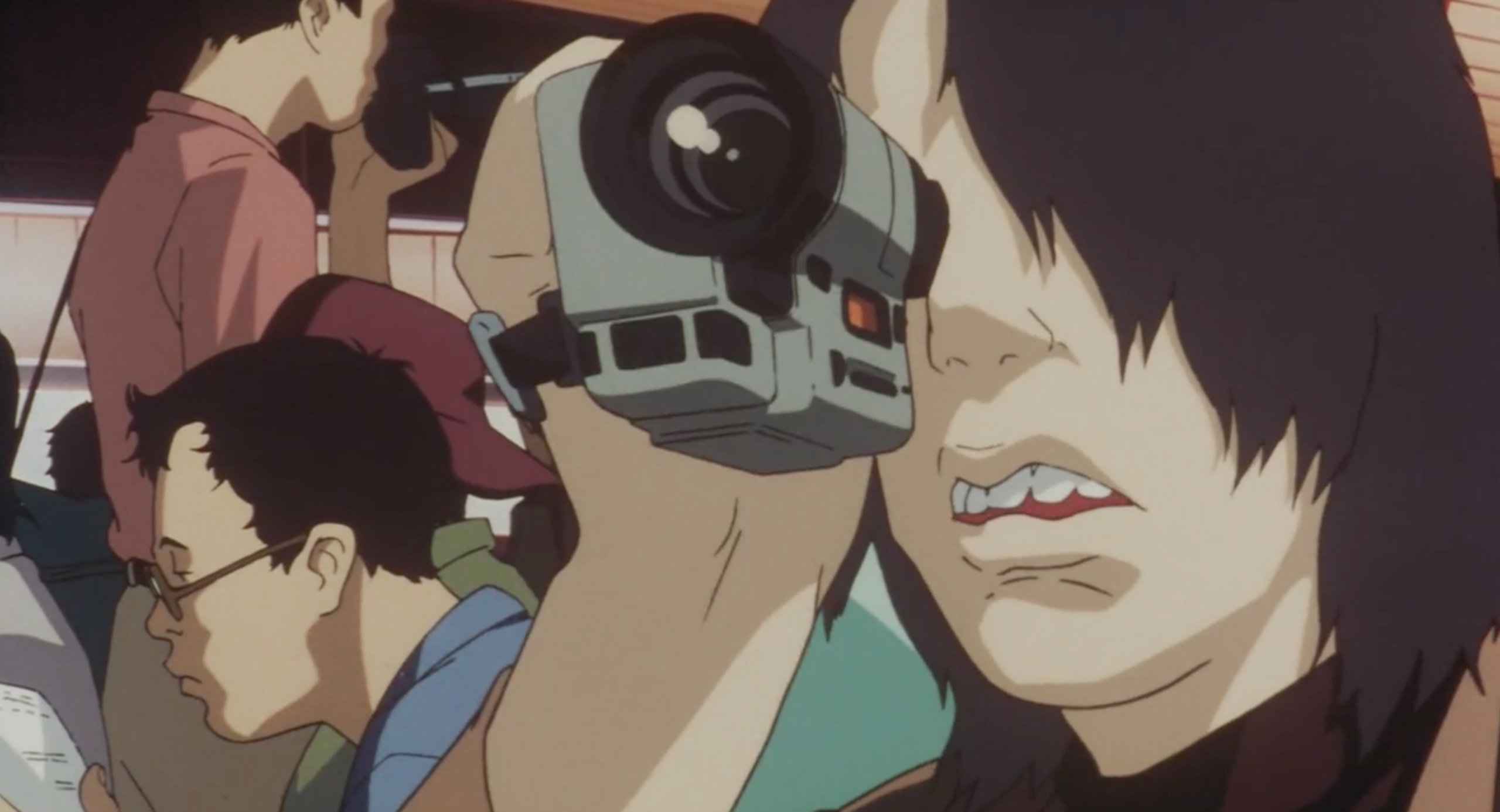
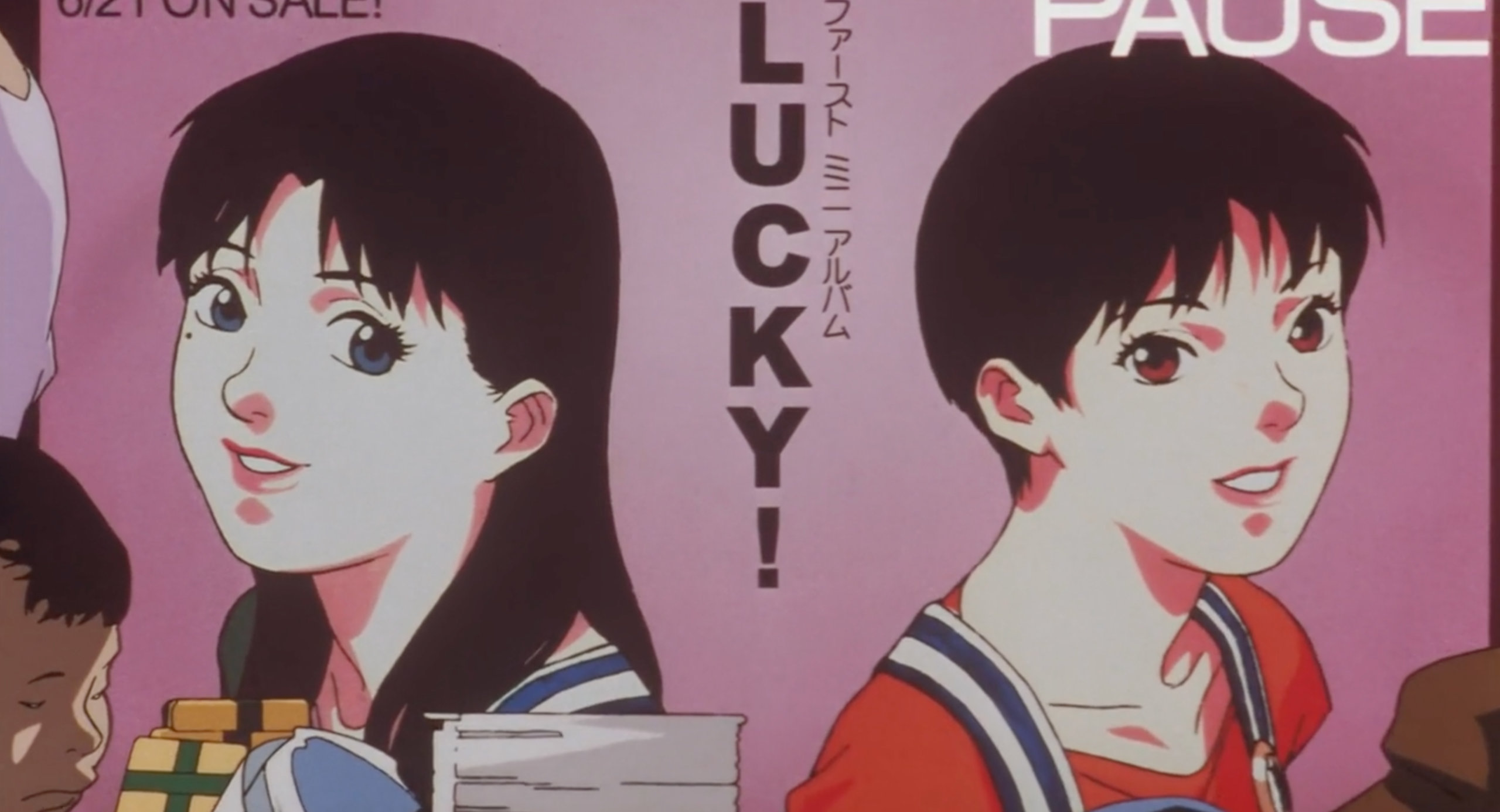
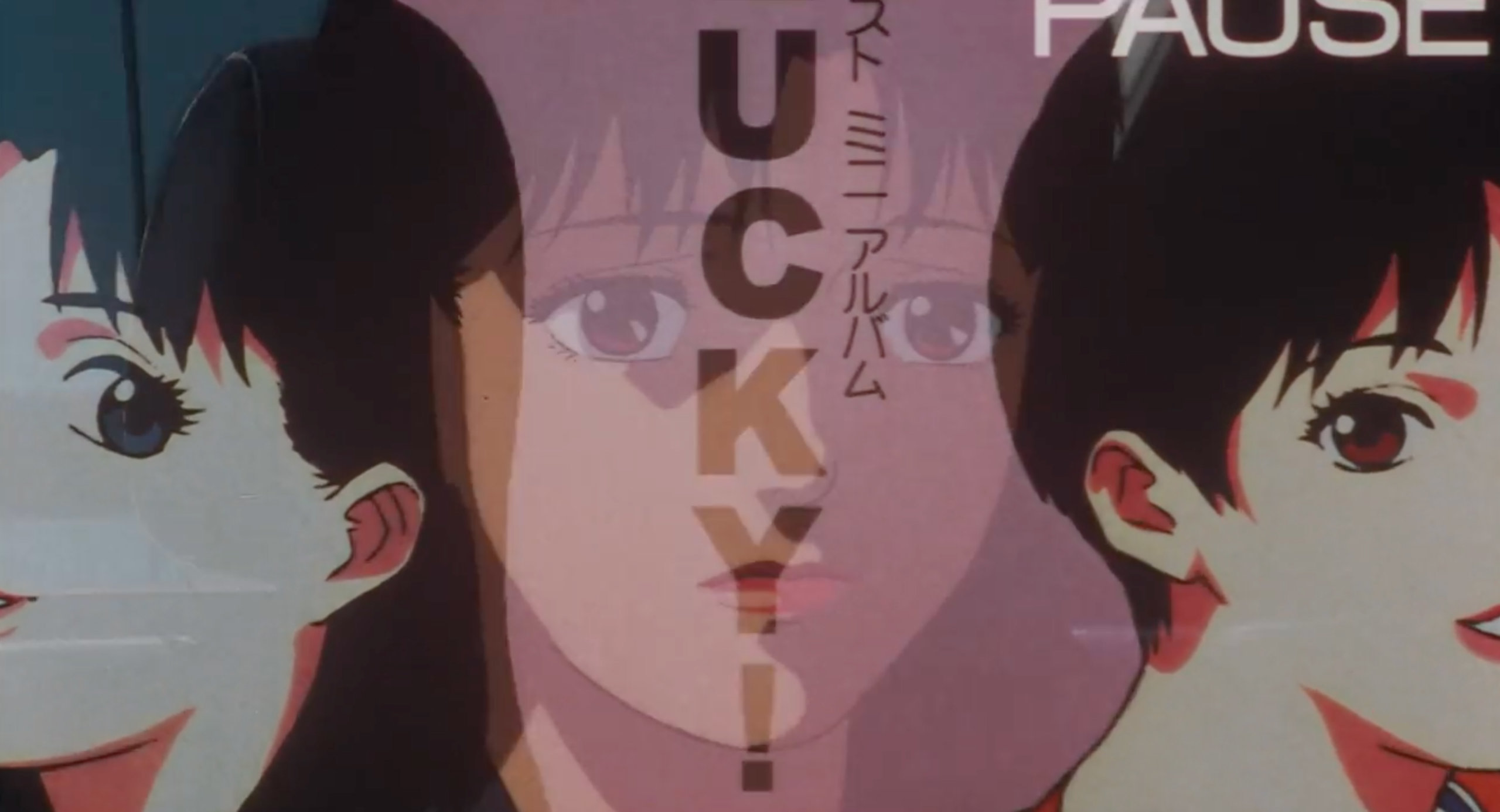

After that, we cut to Mima in the car with Tadokoro. She’s on the way to the shoot with the sleazy photographer. Prior to the CHAM! concert, the remaining two members discuss Mima’s shoot and potential nudity. But Rumi interrupts the conversation. So we know that Mima isn’t there but Rumi is.
This is interesting. We know Mima isn’t there, but we also know that Me-Mania is envisioning that she’ll be there. He’s read the latest post on Mima’s Room, in which Rumi said that Mima would be at the CHAM! show. This is important context for the scene that follows.
At the 46-minute mark, Mima, following the photoshoot, talks with her Idol self. With the Idol self saying she’s going to perform. We then cut to the crowd at the CHAM! concert, and Me-Mania, once again, has his camera out. It’s similar to the shot where he’s videotaping the CHAM! poster, but now in reverse.
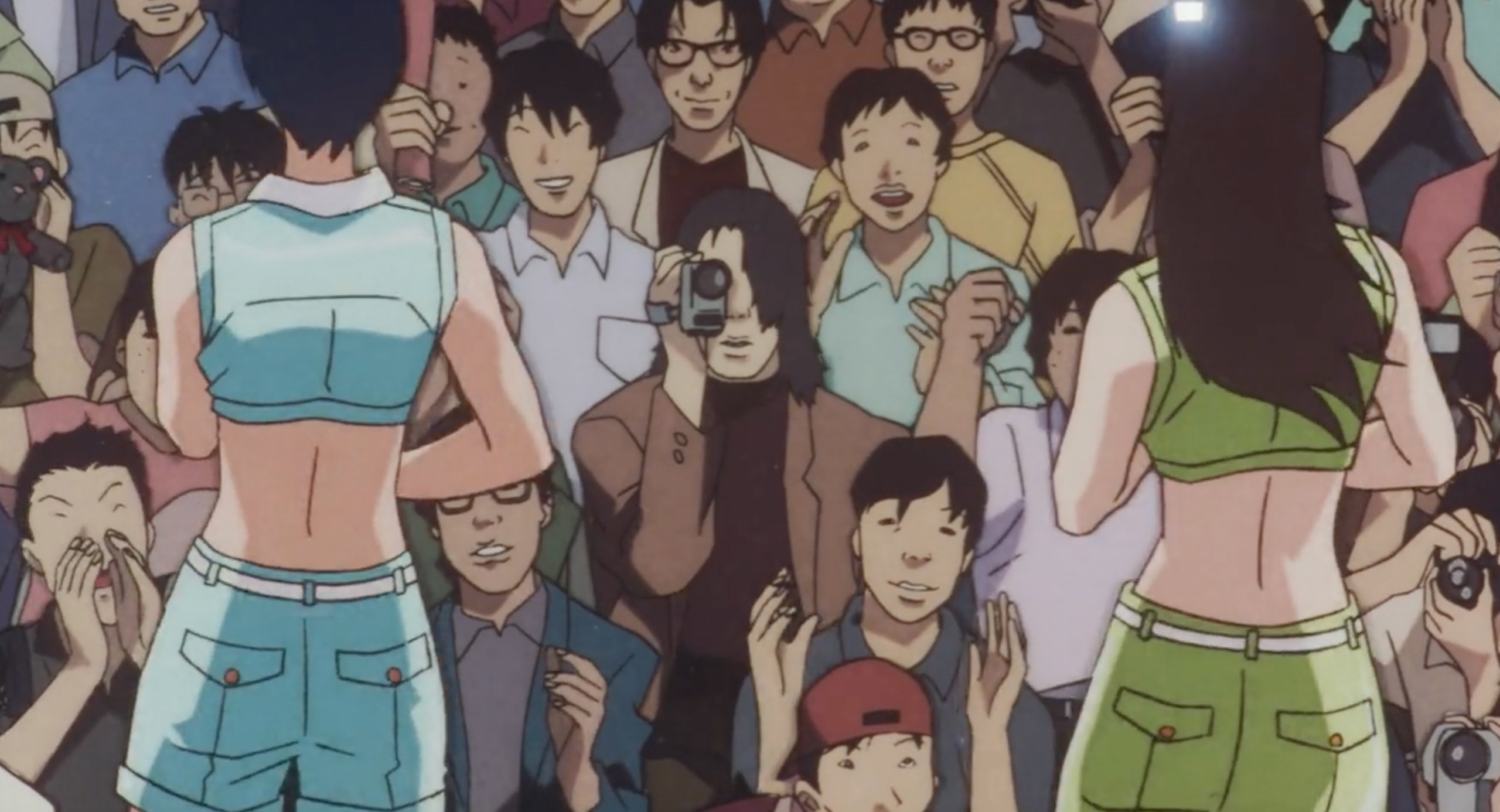
Suddenly, everyone in the crowd looks shocked. Then they cheer. Me-Mania is happier than anyone. There’s a close-up of Rei, still performing, but looking concerned. Then a close-up of Yukiko, still performing, but also looking concerned.
The camera zooms out to reveal Mima in between them. Microphone in hand. Except something is off. There’s an eerie white glow around Mima. She looks more spectral and ghostly, especially compared to Rei and Yukiko who flank Mima’s either side. While the crowd goes crazy and Mima looks happy, the two CHAM! girls seem freaked out. And Me-Mania is absolutely delighted to see his favorite pop idol back with the CHAM! team.
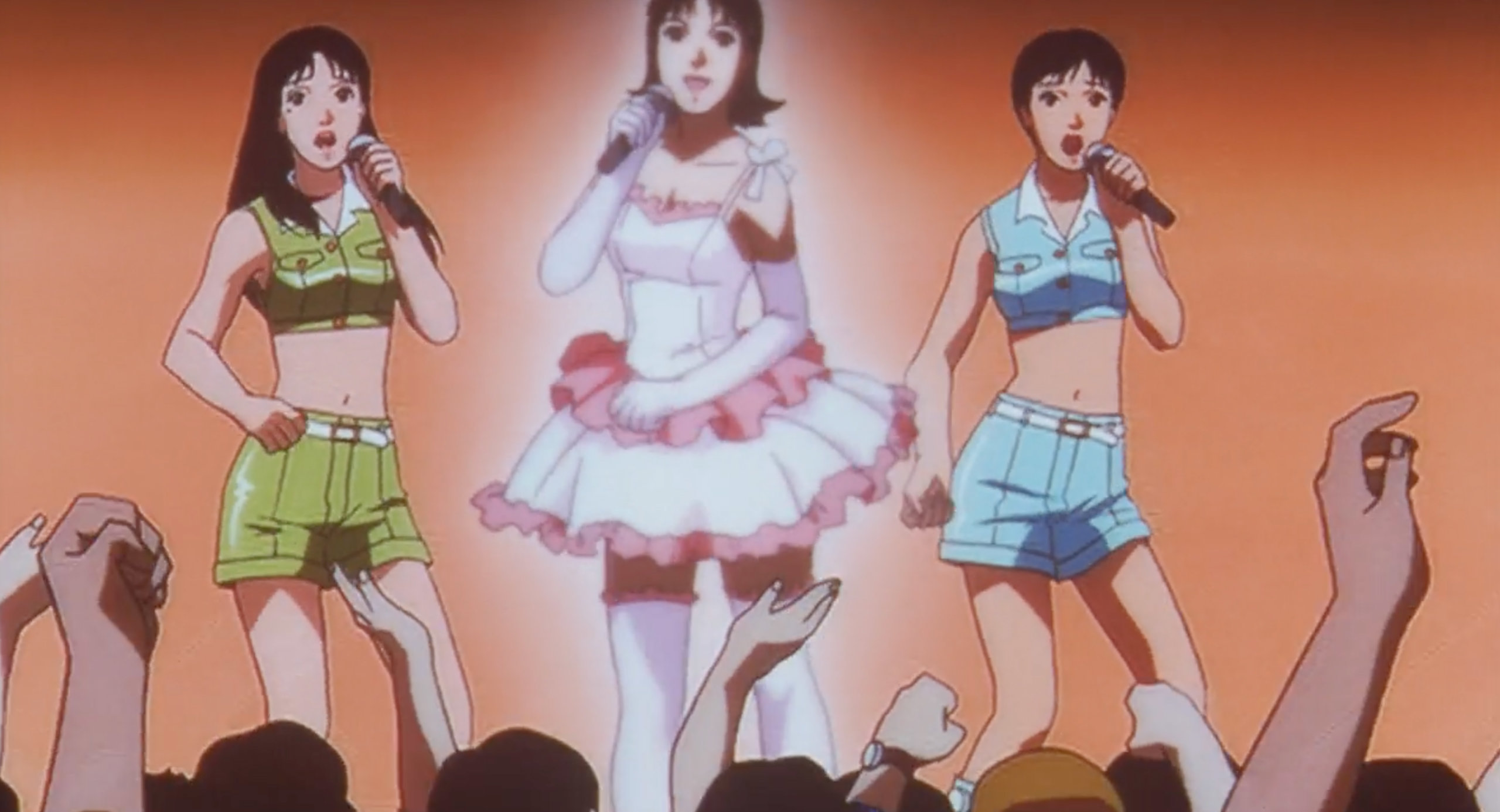
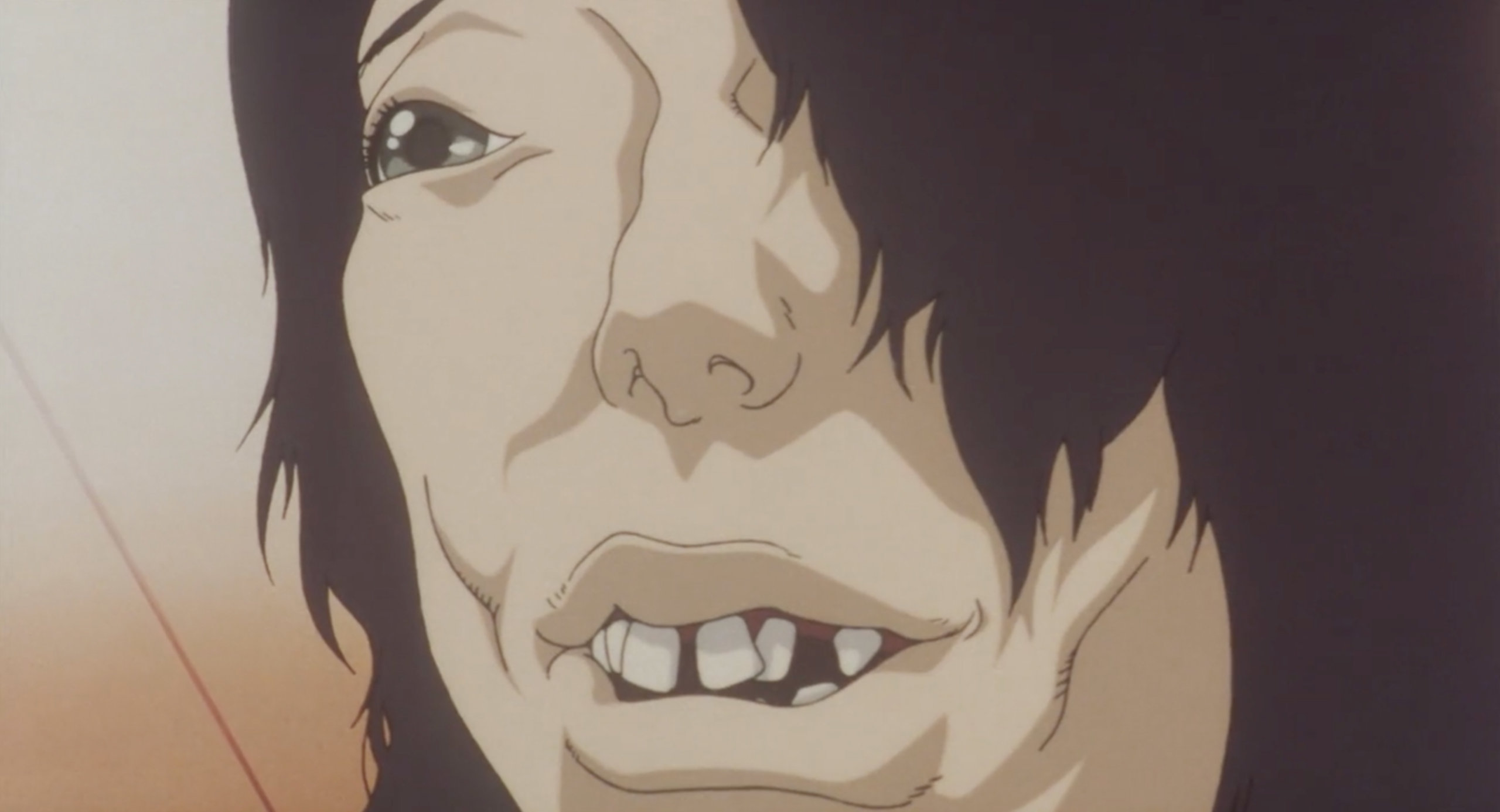
We then cut to a post on “Mima’s Room” where “Mima” says that it was great to sing for everyone. But…we know that Mima isn’t the one writing the posts Mima’s Room.
This could all mean a number of things. Maybe this scene was be a complete fabrication, a hallucination by Mima, imagining what could have happened had she not gone to the photoshoot but instead re-joined CHAM! It could also have been nothing more than a vision of what Me-Mania hoped to see at the concert, as evidenced by the two shots where he’s taping the two CHAM! members and Mima appears between them. Is that real? Or is that just in Me-Mania’s head because he read about it on Mima’s Room?
But if none of it was real, then why would “Mima’s Room” post a notice about performing then thank everyone after? That leads us to believe that someone—whether it was Mima or someone who looked like Mima—was at that show.
Given that we know Rumi was at the show, that she runs “Mima’s Room,” that she knows all the words to the CHAM! songs, and that she believes she’s Mima…it’s possible that the Mima who performed was actually Rumi. Which would explain why the CHAM! girls were so freaked out.
The problem with this theory is that no one ever questions Rumi about it. Tadokoro never brings it up. The CHAM! girls don’t bring it up. And wouldn’t someone notice that the older, portly Rumi didn’t look anything like the young, slender Mima? It’s all kinda confusing. And there’s no real right answer for it. But any way you spin it, each of these theories is interesting to think about.
How many people died in Perfect Blue?
The confirmed death count is four. All murdered by Rumi.
- The screenwriter (Shibuya)
- The photographer (Murano)
- Tadokoro
- Me-Mania (Mamoru Uchida)
One other character (the heckler ring-leader, Tadashi Doi) was in critical condition after being hit by a car possibly driven by Me-Mania. We’re never told if he dies or not.
So the safe answer is 4. The likely answer is 5.
What role does Me-Mania serve?
We see three types of idol fans in Perfect Blue. There are the hecklers who go to shows and have some knowledge but don’t respect the performers. There are the knowledgeable and dedicated fans who seem well-adjusted. Then there’s Me-Mania, the obsessive. It would be nice to say he’s an extreme case, but this kind of “superfan” feels far too common in today’s world (like was the case with Selena and an extreme fan who murdered her—which we write more about in this part of the article). Me-Mania doesn’t just like Mima—he wants to possess her.
Think about the opening scene. He’s in front of the audience, working security for CHAM! As he watches the show, he holds his hand up in such a way that it looks like Mima is dancing in the palm of his hand, as if she was a doll or toy he owned. It’s gross but does a great job of showing us how he views her. Later, we see his apartment and how full it is of Mima posters and memorabilia. Another symptom of his desire.
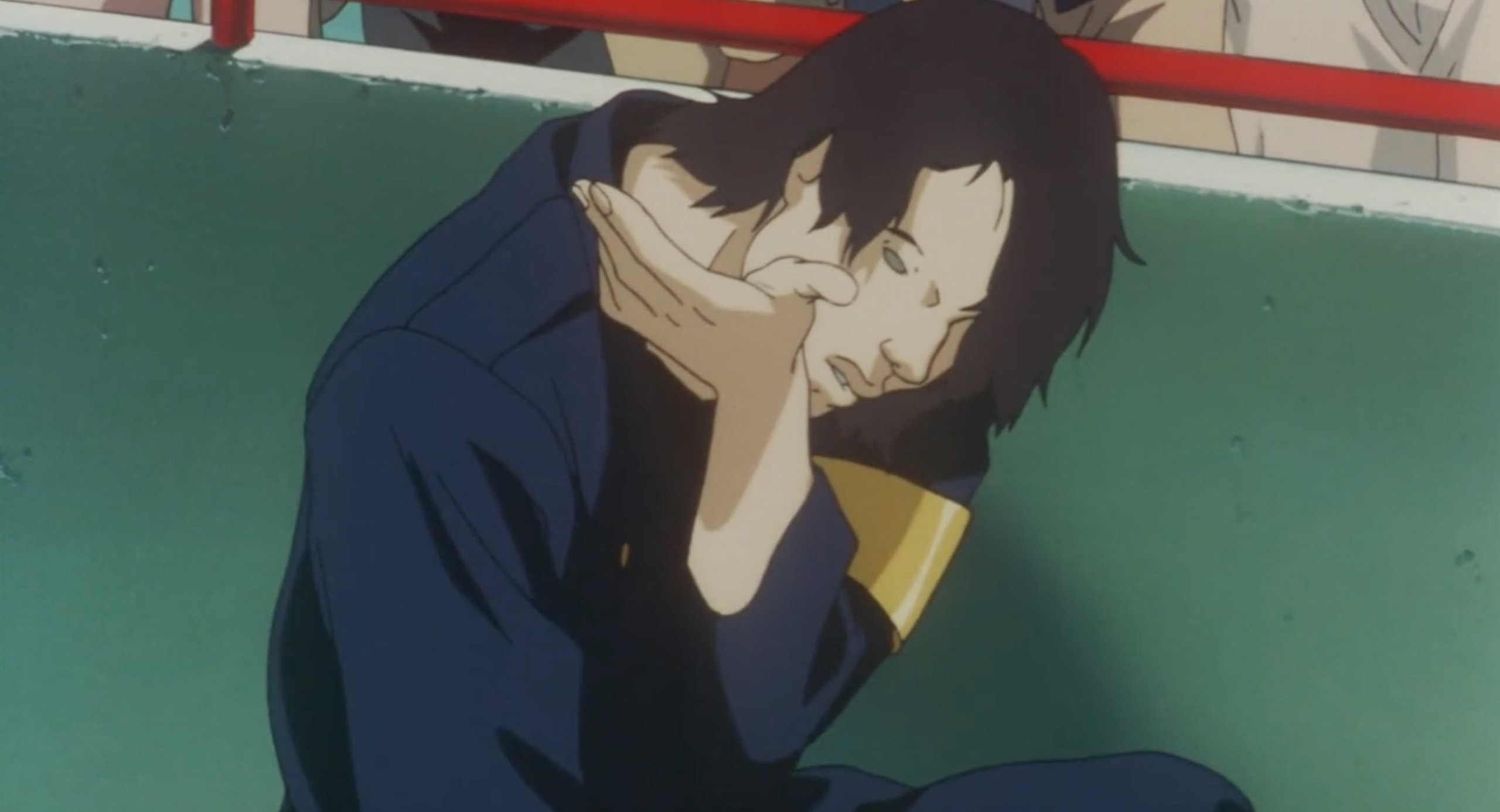
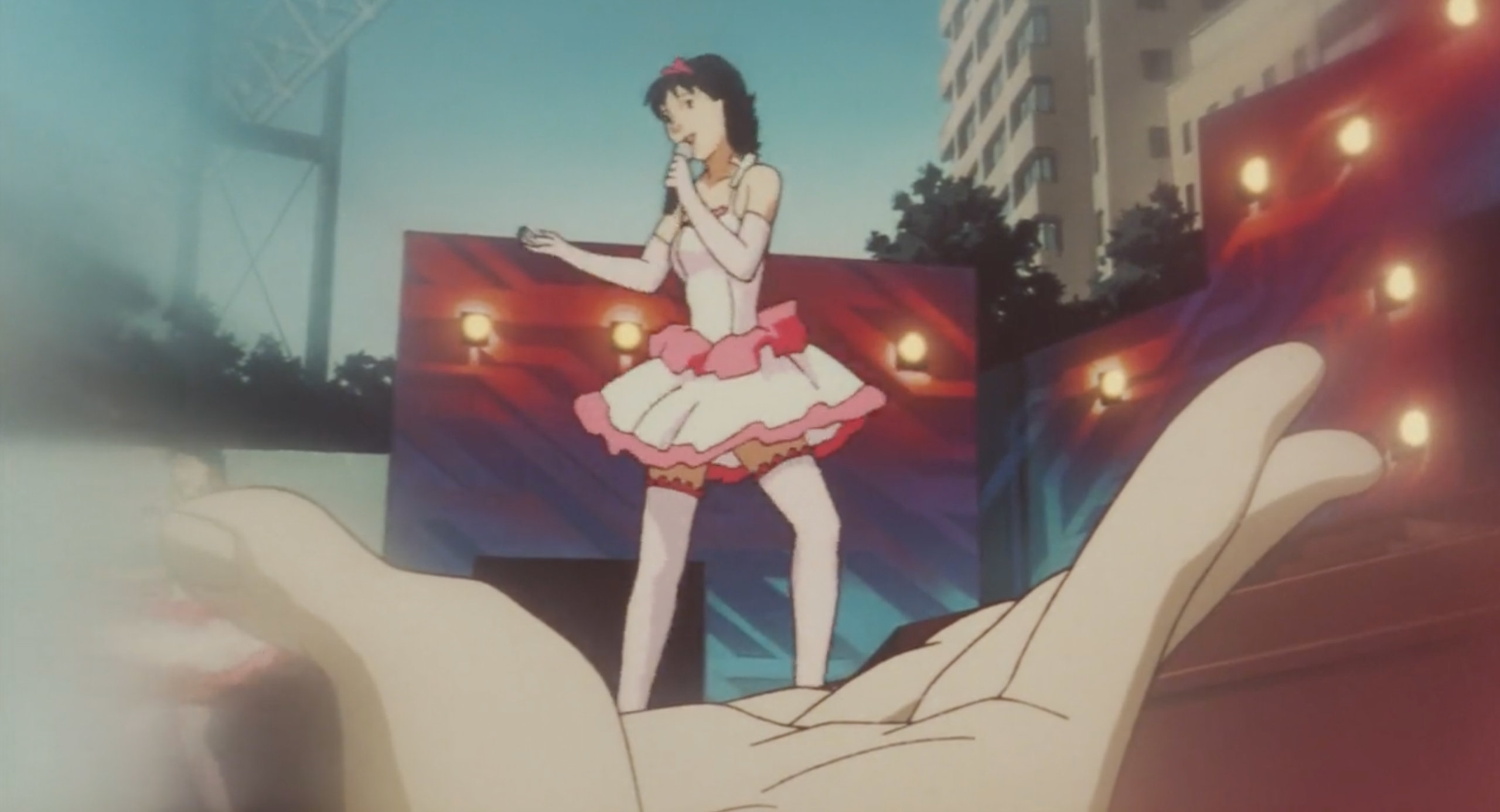
So it’s easy to chalk him up to being the embodiment of these crazy fans that can cause a lot of mental strain for, and even physically harm, the performers they say they love.
But to Mima, Me-Mania is less a fan who has gone crazy and more the manifestation of danger and paranoia. He represents all the stress and pressure Mima is feeling. This sense that she’s not good enough to be an actor, that everyone hates her, that something bad is going to happen to her. He’s an easy way for Perfect Blue to visualize Mima’s paranoia.
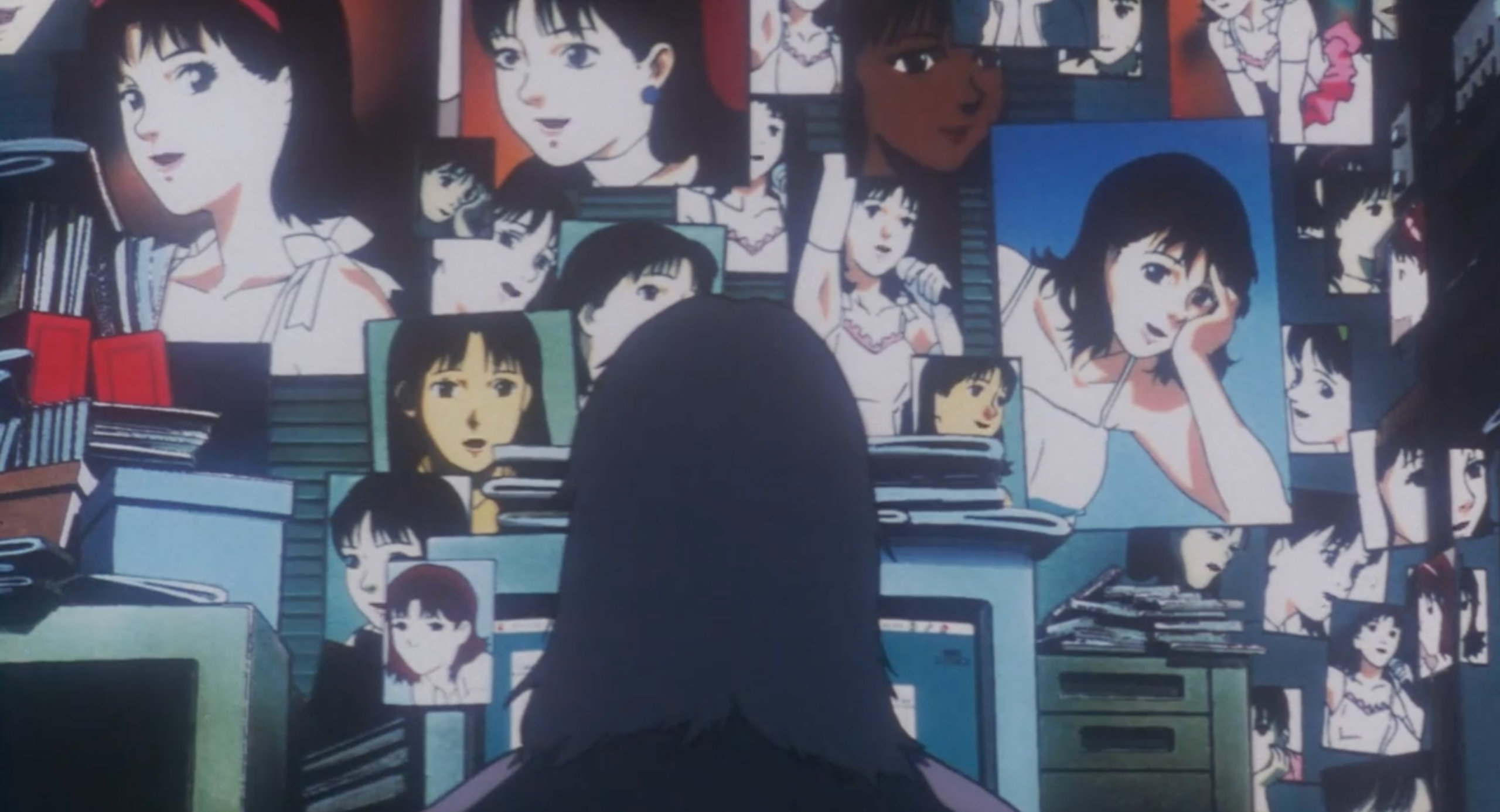
And then he also serves as a distraction. A lot of people probably think he’s the one following Mima and writing “Mima’s Room.” And maybe he is the one who sent the “Traitor” fax and the letter bomb. And all of us probably thought, at some point, that he was the murderer. So we think he’s going to be the main antagonist. Then we think Mima’s just crazy and the reveal will be Double Bind isn’t a show but Mima’s delusion. Then Me-Mania does turn into an antagonist, as he tries to kill Mima. When she defeats him, it feels like she beat the final boss. Which sets up the big Rumi reveal.
Without Me-Mania, you don’t have that initial sense of danger or a red herring to distract us from Rumi’s reveal. You also don’t have an easy way to visualize Mima’s paranoia.
And because he’s the embodiment of Mima’s paranoia, it’s cool when he does attack. Because it transitions us from the subjective reality that Satoshi Kon talked about, Mima’s perception that Me-Mania represented danger, to the objective reality that Me-Mania is dangerous. When Mima defends herself and knocks Me-Mania out, it’s not just her surviving a physical attack but defeating one of her major psychological roadblocks. It’s that combination of overcoming Me-Mania and Rumi that allows Mima to transform from a distraught girl to a confident and successful young woman. That’s why in the final scene she tells the doctor that Rumi made her who she is today.
Important symbolism in Perfect Blue
I think the two most important uses of symbolism in Perfect Blue are reflections and lights.
Reflections
The reflection motif brings us back to this Satoshi Kon quote “…there’s a gap between the image people see of me and what I see myself. Perfect Blue is about the tragedy caused by that gap becoming too large.”
Mima’s whole character arc is dealing with the fallout from becoming an actress after being an idol. Remember the phone call Mima has with her mom in the film’s second scene:
- Mima: Today was the last one. No more singing for me.
- Mom: I remember when you kept saying you wanted to be a singer.
- Mima: This is my big chance! I told you that already!
- Mom: Lately, we’ve all been looking forward to each new single! Your uncle over in Yamaguchi buys 20 copies every time!
- Mima: You just don’t understand this industry, Mom.
- Mom: Wasn’t singing what you were best at?
- Mima: The pop idol image is suffocating me!

Mima’s mom sees Mima as a singer, as an idol. And Mima had, for a long time, only wanted to be a singer. Now she’s giving that up to pursue acting. Can she do it? Will she be good? Will others accept her as an actor? Can she accept herself as an actor? That’s the gap she’s dealing with. Who she was vs. who she is vs. who she will be. That’s the gap we all deal with.
That’s why when Mima first sees Idol Mima, it’s in her reflection. Instead of seeing herself as who she is now, she’s seeing who she used to be. As she steps further and further away from that idol image and life, the self doubt increases. The fear increases. All of that is symbolized through Mima’s continued battle with her “reflection.”
It’s also why the last shot of her is Mima smiling at her own reflection in the rearview mirror.
Rumi is in a similar situation. Except she didn’t get to make a conscious choice to change careers. Instead, she aged out of being an idol. Now that she’s getting older, she’s struggling with that gap between who she used to be and who she currently is. Especially since it was out of her control. The result is a similar mania to Mima. Except instead of fighting back against the reflection of her past, she embraces it. She lets it consume her. Putting on the wig and the clothes to become something and someone she’s not. She sheds her present self for some horrible perversion of her old life.
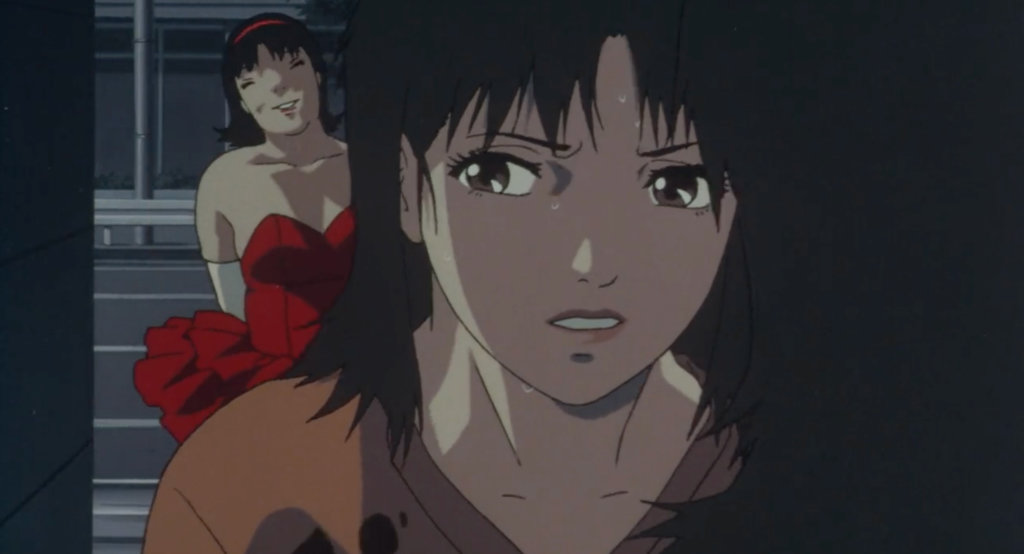
It’s telling what Rumi says to Mima during their final fight.
- Rumi: Let’s end all of this. We don’t need two Mimas!
- Mima: I AM MIMA!
- Rumi: That’s funny! Mima is a pop idol! You’re just a dirty old imposter!
- Mima: Like I care! I am who I am!
What’s particularly noteworthy is that right before this exchange, Mima stands in front of a store’s big glass window, looking at herself. Then Rumi, dressed as Idol Mima, appears. Rumi smiles then bursts forward, aiming the point of an umbrella like a sword in an attempt to stab Mima. A wild thrust of the umbrella misses our hero and completely destroys the window.
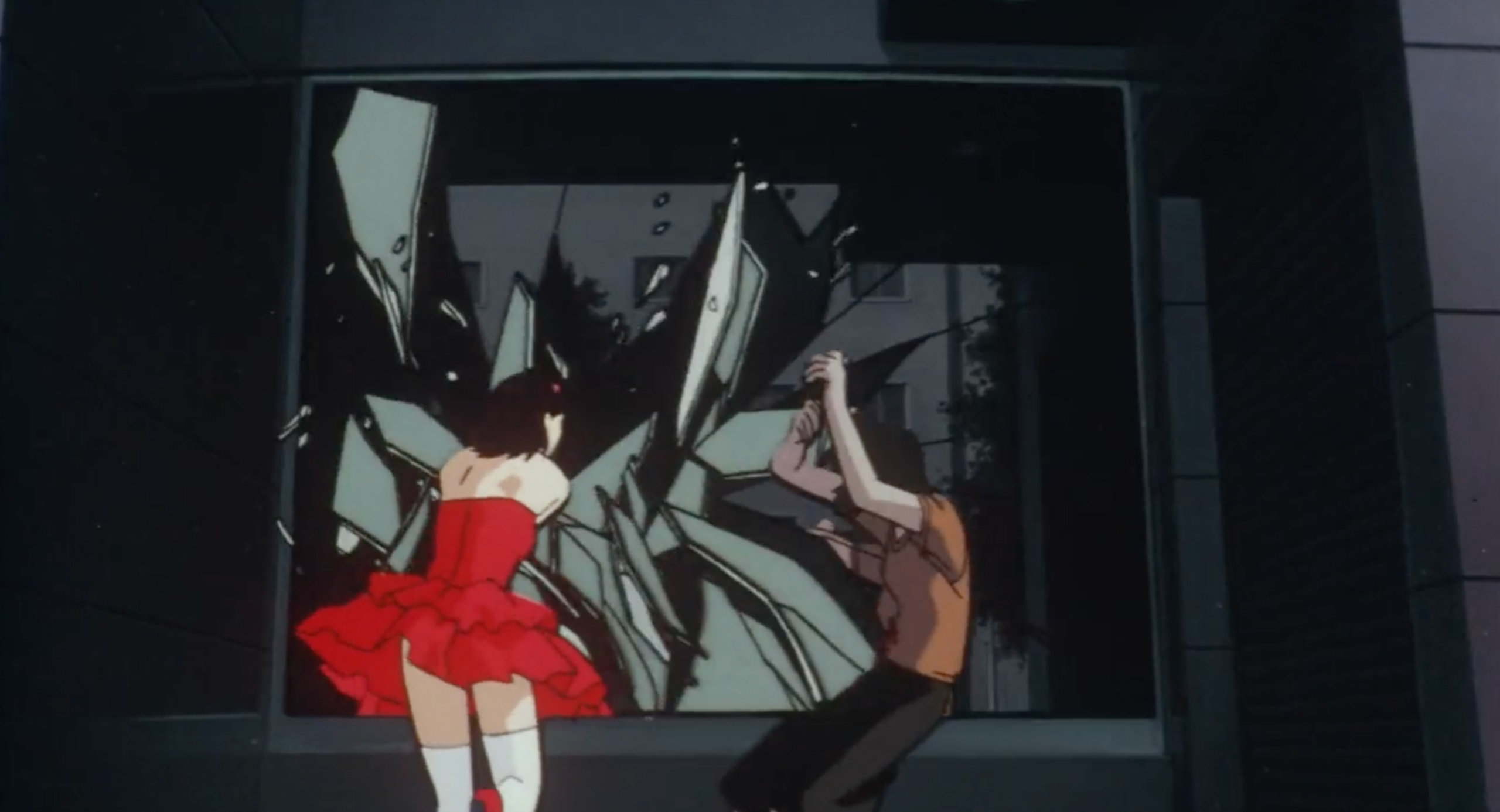
The symbolism of that is everything. The window had just contained both Mima and Rumi as a twisted version of Mima. That’s the gap. And that gap gets destroyed. Then leads, immediately, into the conversation where Mima declares I AM MIMA and rejects that Mima has to be an idol. Such a statement is the climax of the identity crisis that had plagued her. Mima isn’t defined as an idol or an actress or anything else. She’s just herself. And with that clarity, she gains the upper hand on Rumi.
Rumi, on the other hand, makes the outrageous statement that Mima is a “dirty old imposter.” Talk about projection. That’s how she truly feels about herself. Dirty. Old. An imposter. That’s why she disassociates. She wants to be beautiful, young, and beloved.
Following Mima’s “I am who I am” quote, she tears the wig off Rumi’s head. And. Rumi. Flips. Out. This brings us to probably the most chilling moment of reflection.
The wig flies through the broken store window, landing inside. Rumi, distraught at not feeling like Mima, rushes after it. Oblivious to anything but the wig, she leans forward and impales herself on a shard of glass. We cut to an almost-POV shot. We see the wig. Rumi’s hand on the wig. And several large pieces of broken glass. In each piece of glass: Rumi’s reflection. Then blood explodes from her wound and covers the glass.
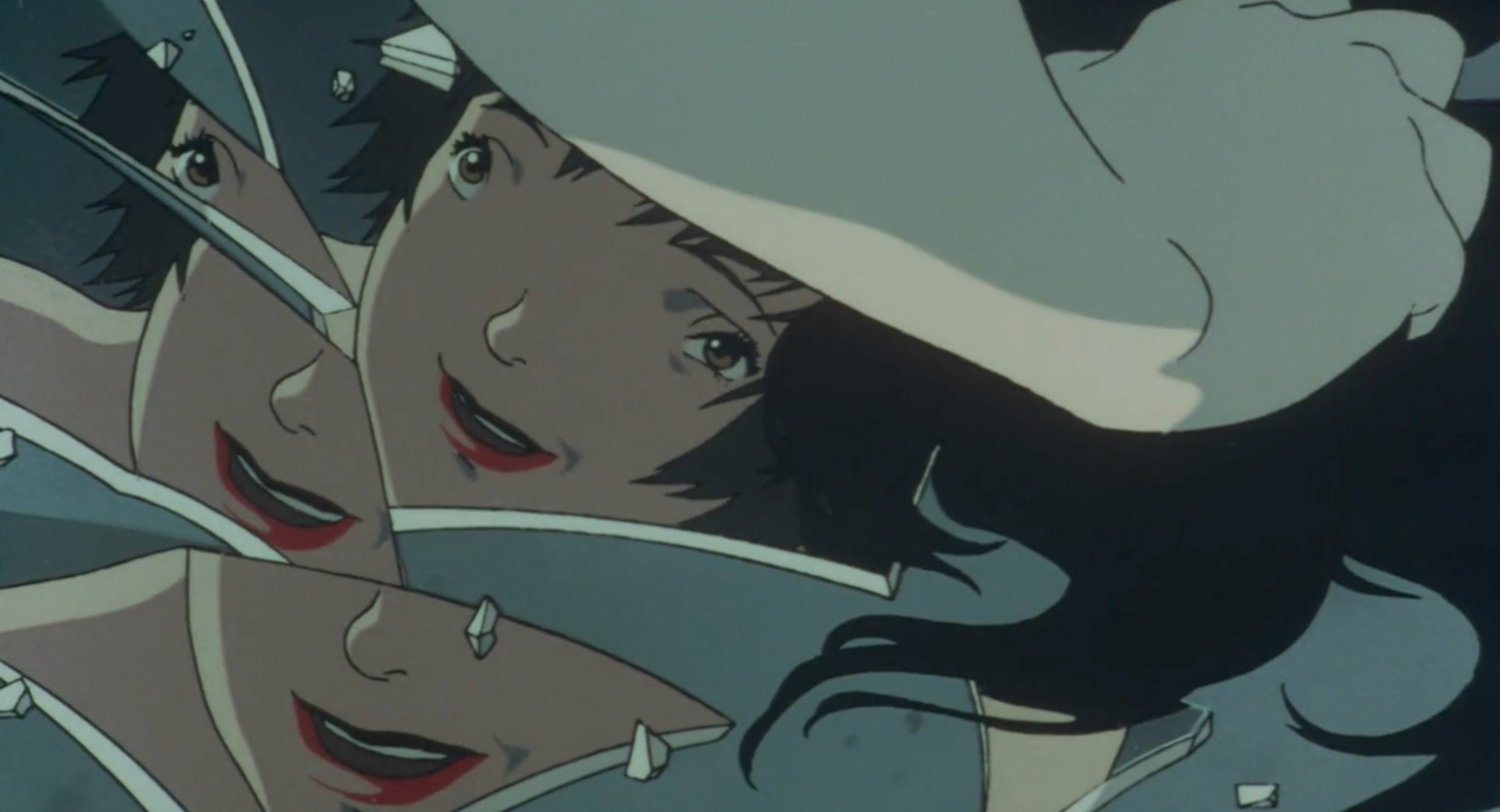
While Mima comes to terms with who she is, Rumi doesn’t. That’s why we get the shot of her face in the various pieces of glass. It’s the ultimate visualization of her broken psyche.
Lights
Perfect Blue’s first emphasis on lights happens right before the 16-minute mark. During Mima’s first scene for Double Bind, she has one line and one line only: “Who are you?” Given all that we’ve talked about in this article, that question has a lot of weight. A character who struggles with her identity is asking “Who are you?” It’s one of those small moments that really sets up the themes and journey. As Mima rehearses the line, waiting for the director to start the camera, she looks up at the set lightning. These bright, overbearing ceiling lights that almost completely wash out the visual.

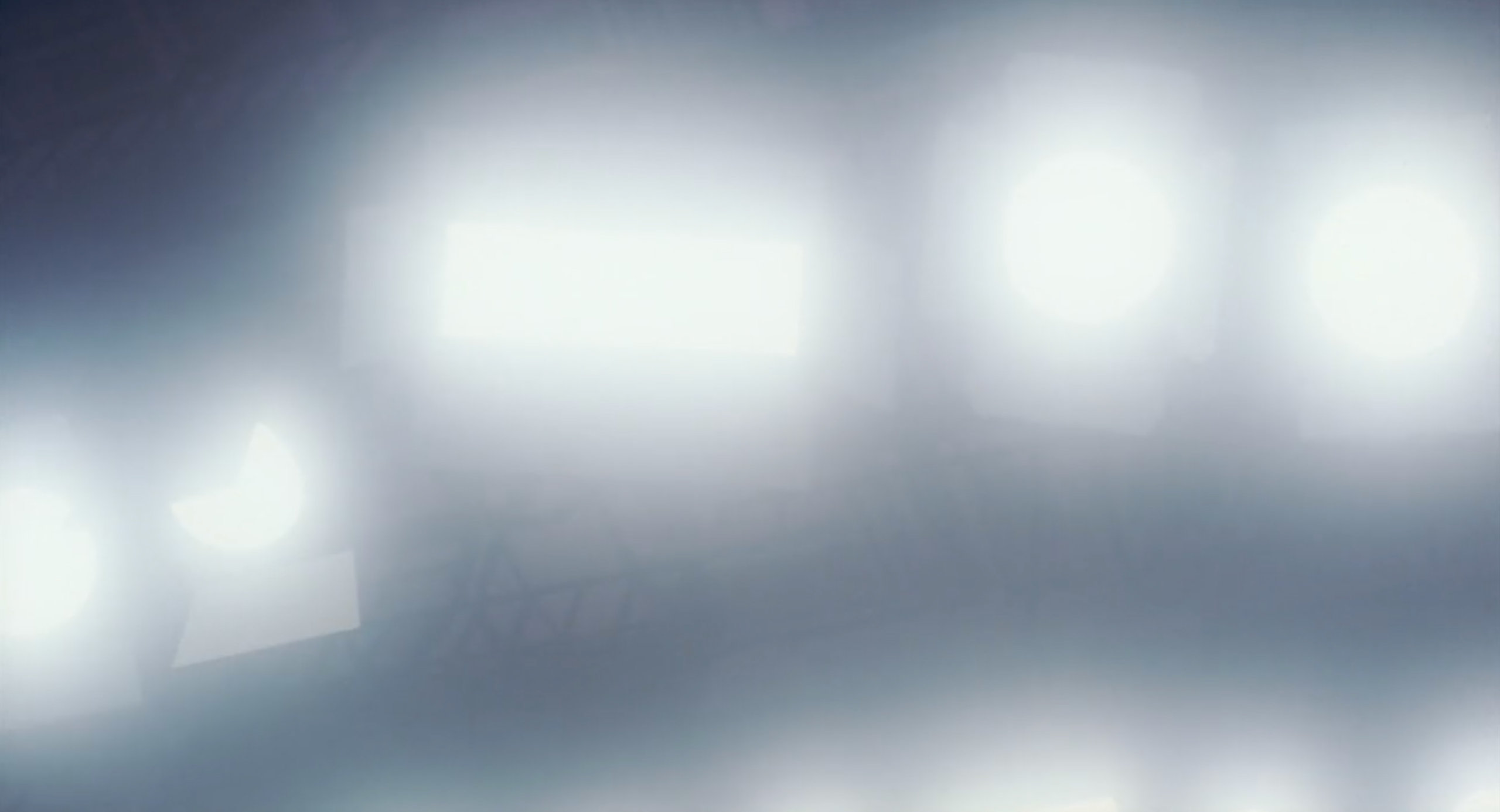
Right after this, Mima looks out at the crew and sees people laughing, staring, whispering. Are they talking about her? Are they judging her? Do they think she’s an imposter, the idol who foolishly tries to be an actor? The pace of the cuts increases to demonstrate Mima’s increasing anxiety, until it focuses on the shadowy figure of Me-Mania.
Our takeaway here is how the scene starts to connect the bright lights with identity crisis and the warped perception that can cause. Are the people looking at Mima? Laughing at her? Whispering about her? Probably not. But being the center of attention can put enough pressure on someone to make them think so.
A few minutes later, we have another Double Bind scene. Someone has been murdered at a fashion show. First we see the models on the runway, some cameras flashing around them. Then we get this fantastic shot where the model is in the foreground, crowd and photographers in the background. The model then walks out of the frame, leaving us to see the rest of the crowd. The shot lingers on the crowd. We see camera flash after camera flash. But in the middle of everyone, there’s this person with a chilling smile. We cut to another photographer, a close up of their camera, and the flash flaring. Instead of press at a fashion show, it’s a police officer photographing a model killed in the dressing room. This juxtaposition between performance and death connects the two concepts and ties back to the pressure and anxiety Mima’s feeling.
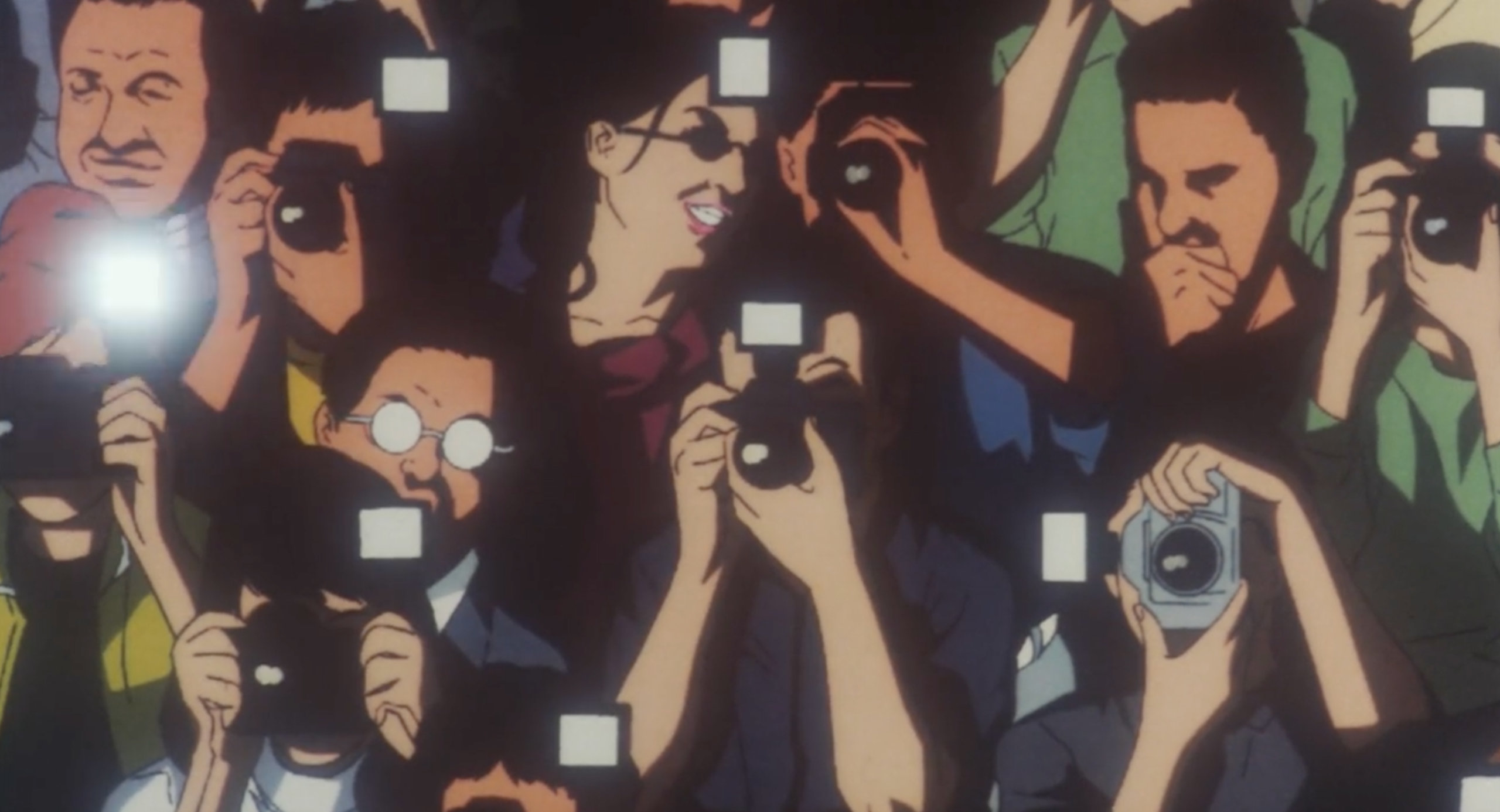
The next major scene is Double Bind’s assault scene. As the scene unfolds, it stresses out Rumi and Tadokoro with how realistic it is, and even Mima starts to space out. Her vision unfocuses from the men around her and instead scans the set lights glaring down upon her. The cuts come faster as it feels like Mima’s on the verge of fainting or being overwhelmed. Cut to the faces of the men. To the lights. To the people on set. To the lights. The men. The lights.
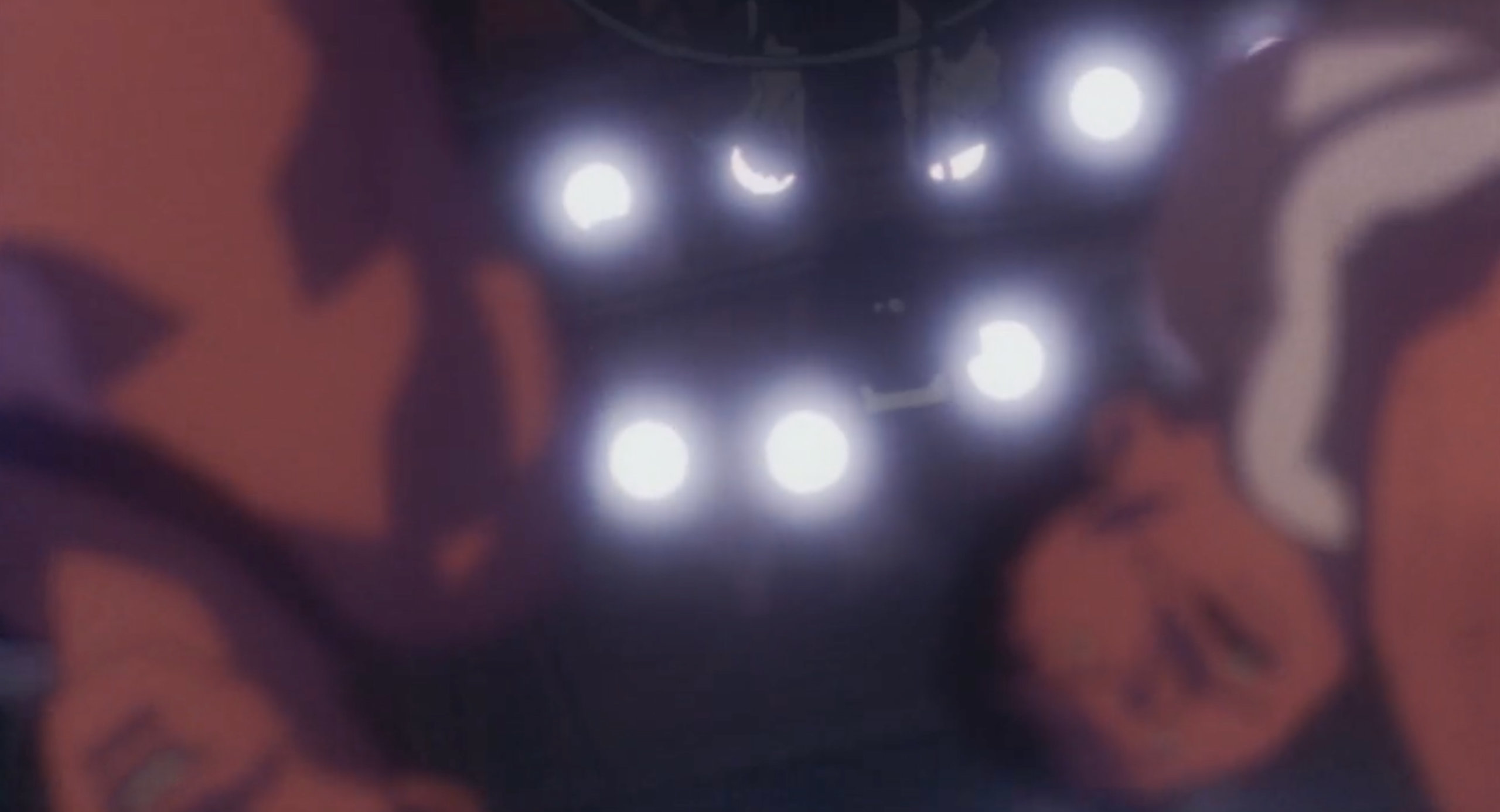
The last second is a flicker of extremely rapid cuts of Mima’s face and the biggest set light. It makes it look like Mima and the light are one and the same. Then suddenly we cut to a cheering crowd. And Idol Mima appears, waving to the crowd. She’s washed in that overwhelming bright light we talked about earlier, the light of fantasy. And then the transition happens with the total white out.
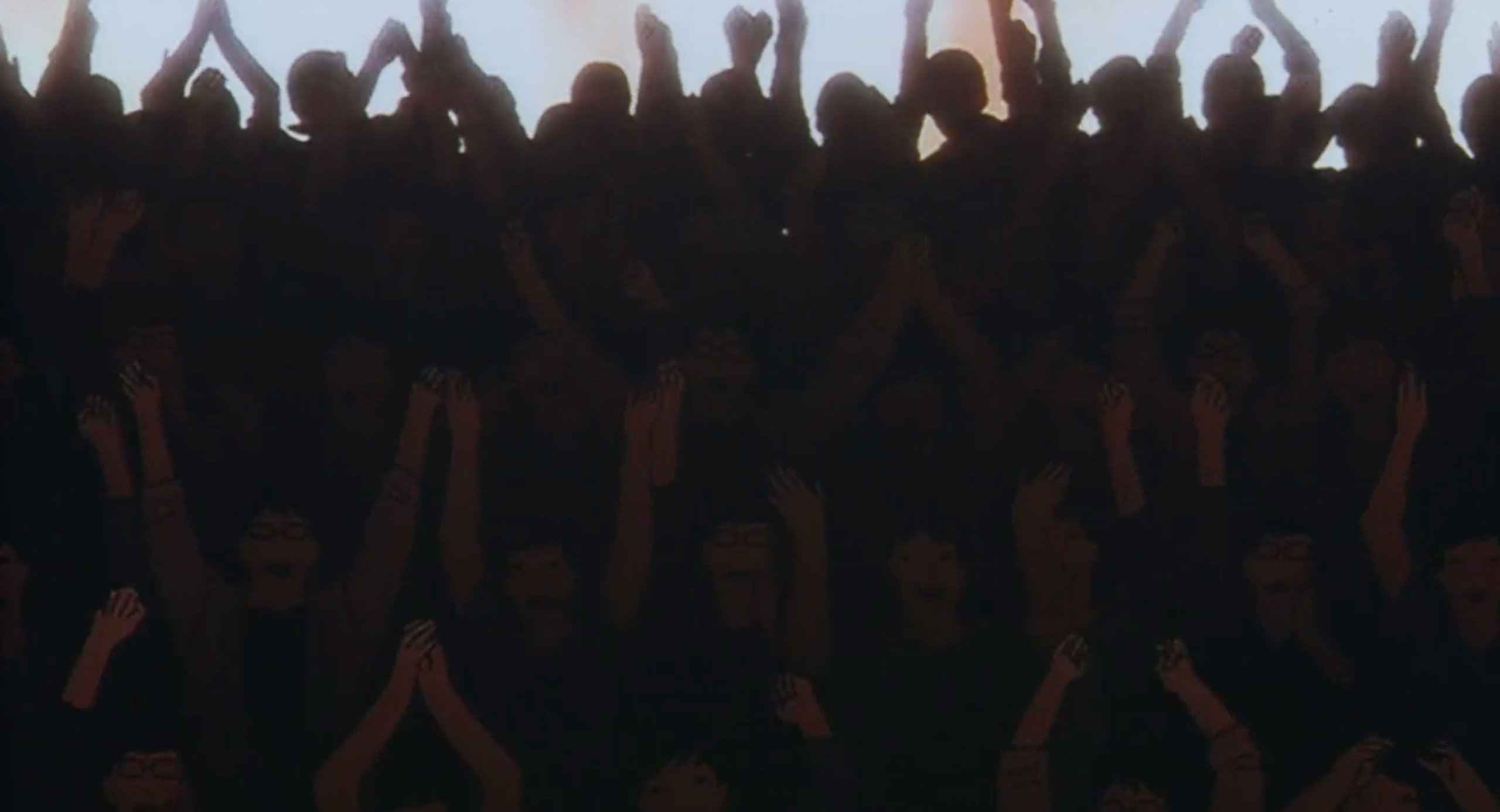
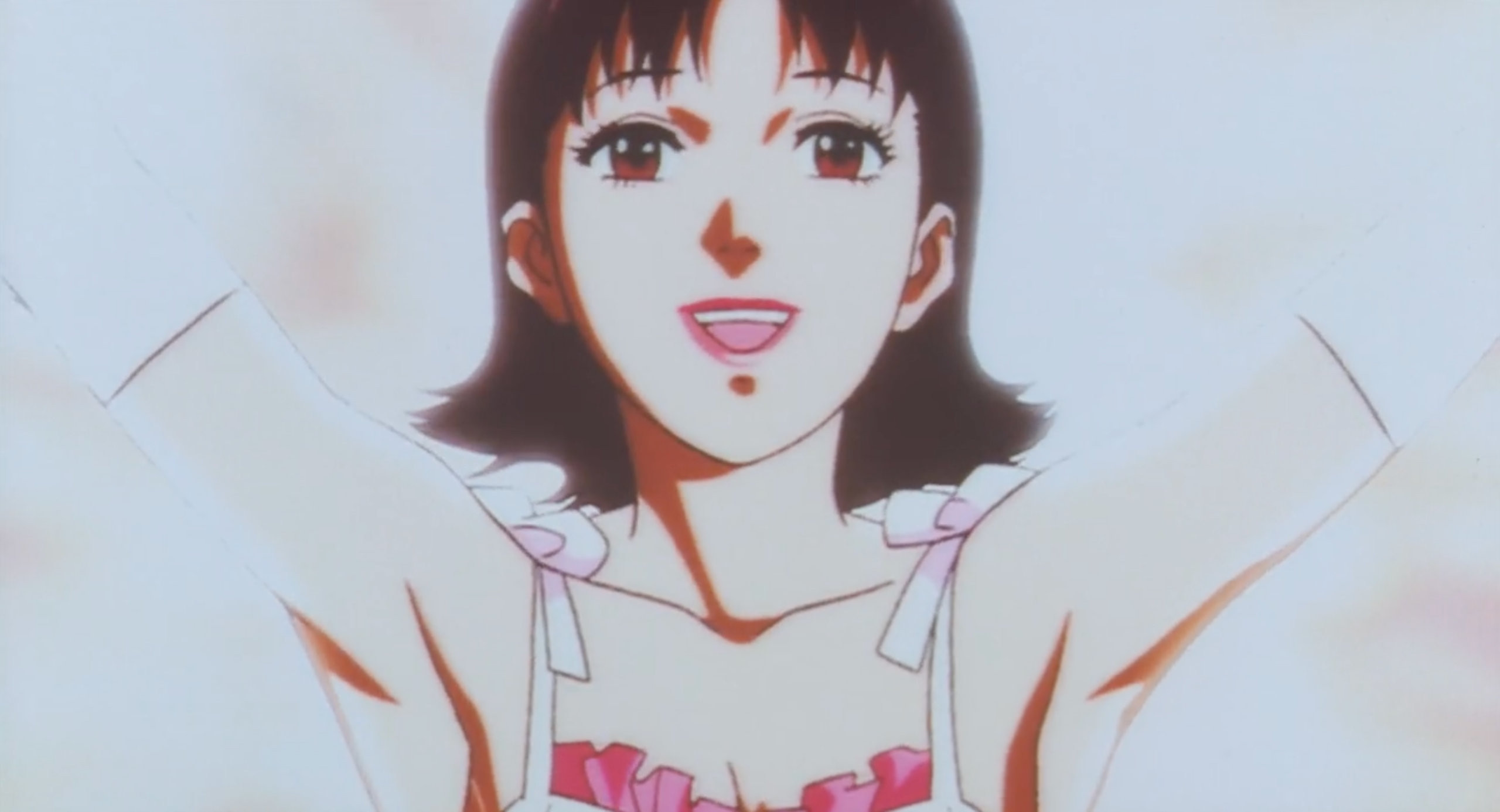
With these three scenes in mind, you can firmly make a case for the lights symbolizing identity, perception, and performance. And all the nuance of those things. Throughout the rest of Perfect Blue, lights play a major role.
One last instance I want to point out happens at the end of the final fight between Mima and Rumi. After Rumi stabs herself on the glass, the severity of the wound causes her to stagger aimlessly into the street. Putting on her wig, Rumi recovers as she once again assumes the identity of Idol Mima. A big box truck comes speeding on the street, in the same lane as Rumi. Instead of running away as a normal person would, Rumi sees the bright headlights of the truck and thinks she’s on stage, that this is a show. So she stands up, and opens her arms, basking in the light.
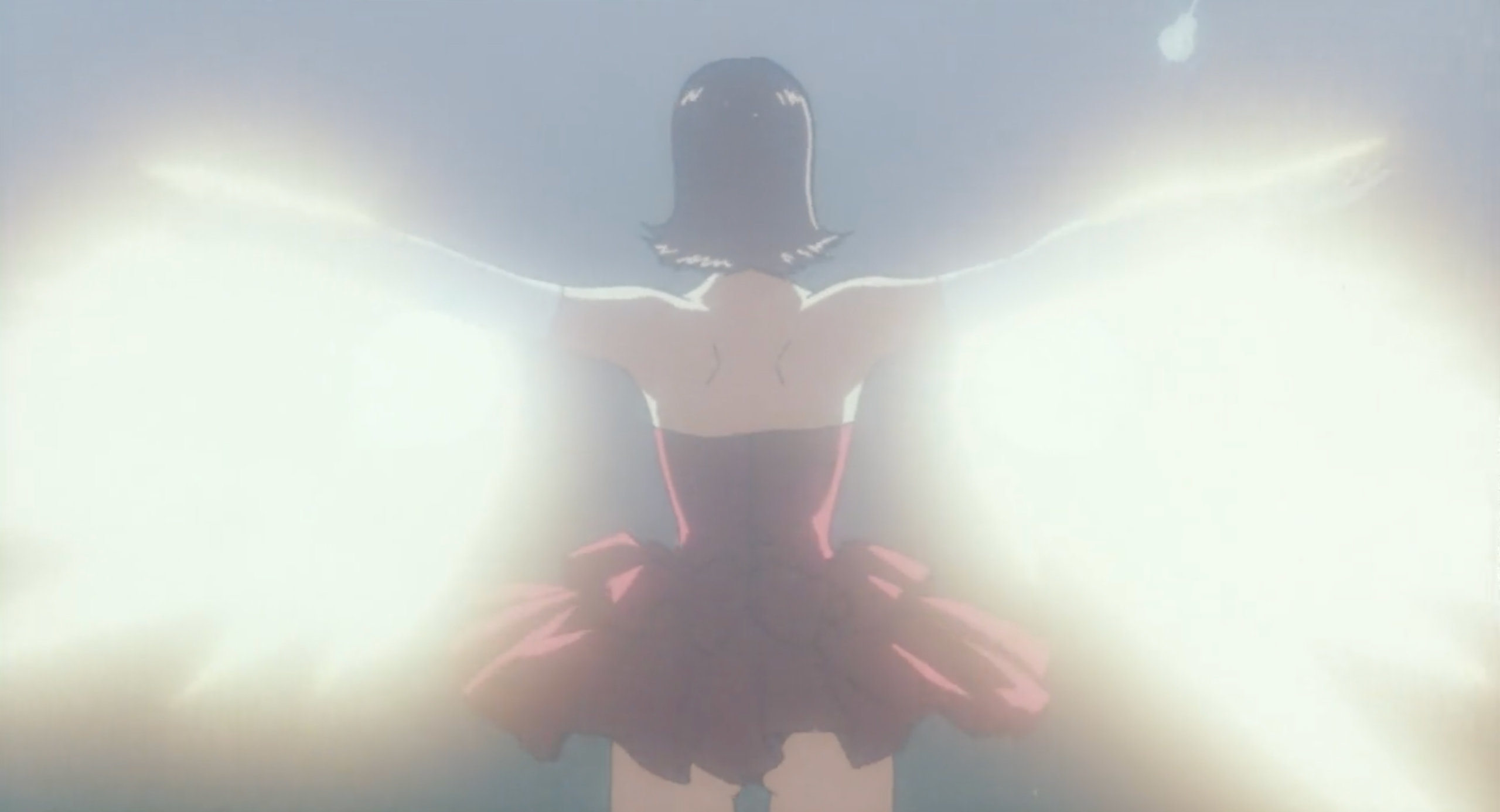
Mima has to run out and tackle Rumi to save her. Even though both are hurt, they survive. But you have this cool moment, right before the tackle, where the lights completely wash out the frame, but as Mima knocks Rumi out of the way the light dissolves, revealing the dangerous reality of the truck’s grill.
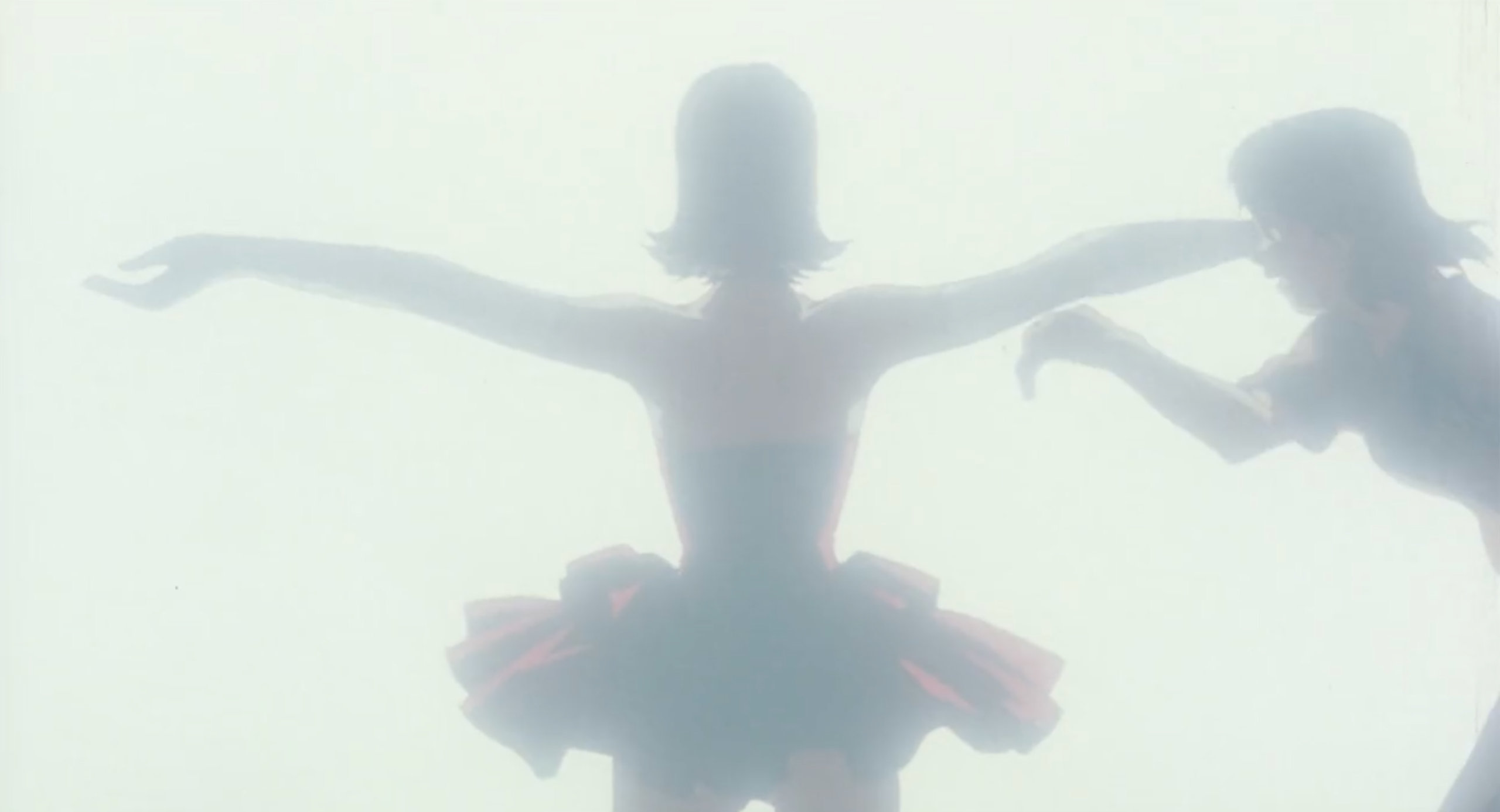
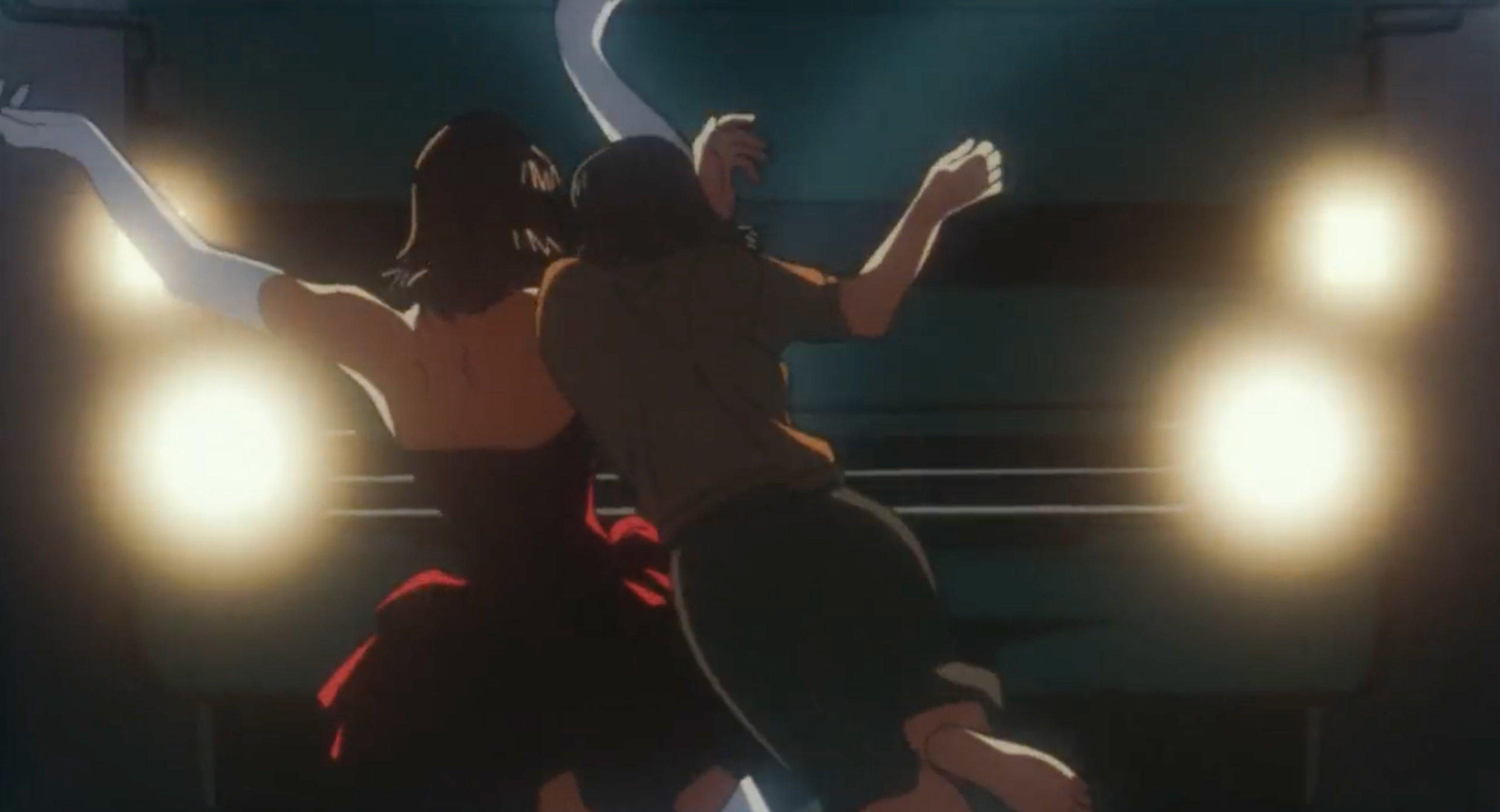
This is similar in meaning to what we talked about in the reflection section regarding the breaking of the store window that had contained the reflection of both Mima and Rumi. Rumi still sees a false reflection, Mima doesn’t. Rumi still gets blinded by the light, Mima doesn’t.
The main themes of Perfect Blue
As Satoshi Kon said, Perfect Blue is about perception. How others see us and how we see ourselves. And the tension that exists when there’s a gap between who we are and who we want to be. That gap widens or contracts based on reflection, reception, and transition.
Reflection in the sense of comparing past to present. Reception as in how people respond to you and what you’re doing. And transition means how we deal with change.
Mima and Rumi both struggle with all three aspects but in their own ways.
For Mima, she’s transitioning from idol to actor. That’s a scary prospect because you’re going from the known to the unknown, and she’s not sure if she’ll be good or not. The concern she feels about this career transition increases her sensitivity to how she’s received by peers and the public. There’s paranoia, fear, anxiety, and trying to please others even if you’re uncomfortable. All of the above can cause you to reflect on the previous chapters of your life, to start making comparisons between what was and what is.
For Rumi, she’s aged out of being an idol. It wasn’t a choice. She misses performing and the love of the fans and the feeling of being the center of the world. All she wants is to return to the past.
Rumi serves as a worse case scenario. Someone who is unable to come to terms with their present in a healthy way. Instead, she rejects who she’s become because she hates the fact that she’s grown up.
Mima represents a dramatized example of what most of us will go through. A maturation process that is full of highs and lows, progress and regression. Most of us won’t have the extreme afflictions Mima does. But we’ll have moments that completely stress us out, that challenge us, that leave us wondering if we’re making the right choice or not. We’ll be okay, though. The negatives will be our greatest teachers. By working through them, we feel strong and confident. They make us who we are, even if they were awful experiences to live through.
I think that makes Perfect Blue mostly about acceptance of reality. Accepting new directions in life. Accepting letting go of previous chapters and dreams. Accepting aging. Accepting loss. Accepting our inability to change a great many things. None of that is easy. Especially because every day is a new reality. But once you know who you are and you accept yourself and can be proud of yourself and love yourself: reality is something to smile at.
Bonus Features
Up until now, we’ve stayed focused on the narrative of the film itself. But here in the Bonus Features section, we’re going to dive into a few of the extraneous elements that will help us further understand Perfect Blue.
Perfect Blue’s connection to Black Swan and Requiem for a Dream
It turns out filmmaker Darren Aronofsky bought the American rights to Perfect Blue. He did this ahead of making Requiem for a Dream. Why? Because Aronofsky apparently loved Perfect Blue and wanted to recreate the scene where Mima puts her face into her bathwater and screams. In order to do that, he had to get permission or own the rights to Perfect Blue. I guess the rights were affordable enough.
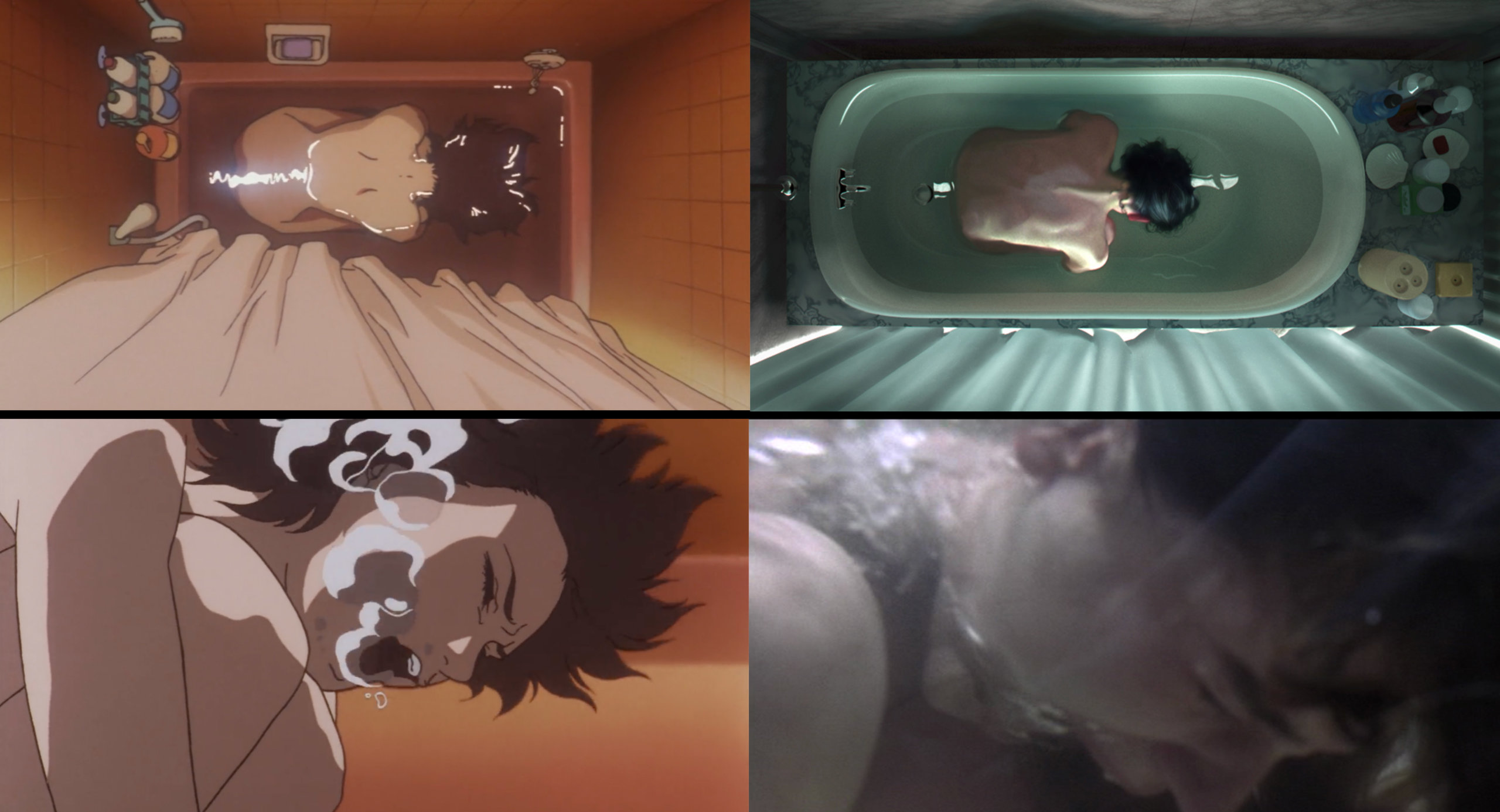
But this is also what allowed him to comfortably make Black Swan. Since Aronofsky owned the rights, he wouldn’t have to worry about a copyright lawsuit. Which meant Black Swan could be as derivative of Perfect Blue as the director wanted. Not to say Black Swan is derivative of Perfect Blue—it’s certainly its own film and one I love. But it’s hard to deny that Aronofsky borrowed a great many moments.
The most obvious connection is Black Swan’s main character Nina; that’s about as similar to “Mima” as you can get without being “Mima.”
Both protagonists take on roles as characters who have dual personalities. Nina is playing both the White Swan and Black Swan in Swan Lake. As Mima plays Double Bind’s Yoko Takakura, a woman suffering from a dissociative personality disorder. The result for both Nina and Mima is that they start to lose track of the difference between performance and reality. Nina’s life becomes like Swan Lake. Mima’s life becomes like Double Bind. Unable to cope with the dissolvement of the line between fantasy and reality, Nina and Mima suffer emotional breakdowns and false perceptions.
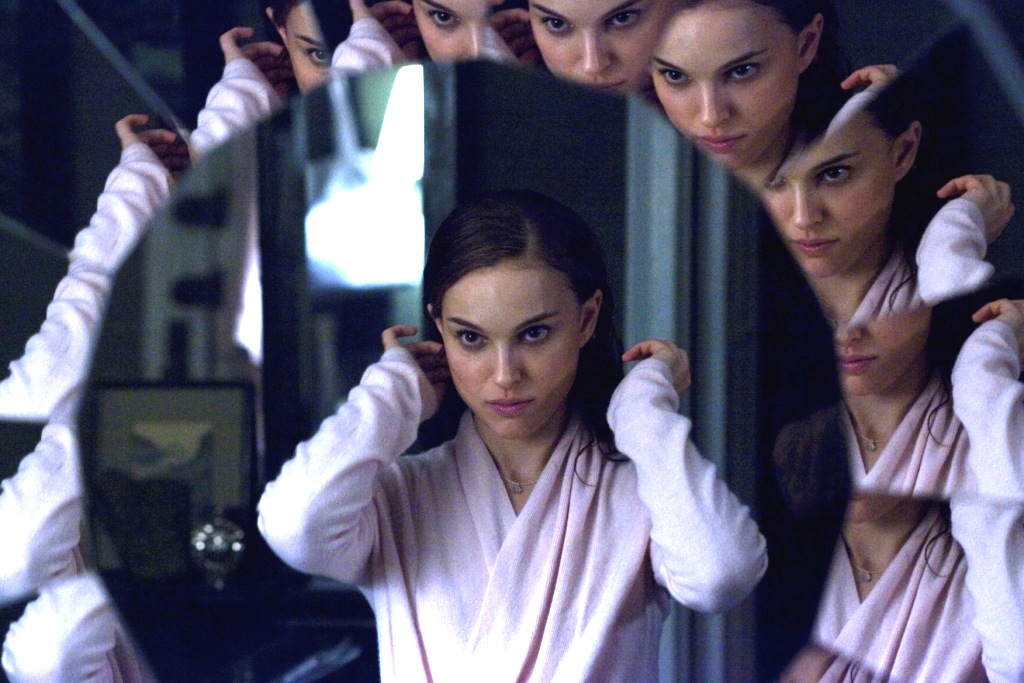
Aside from the major plot points, Black Swan recreates similar moments from Perfect Blue. Like the use of reflection and the other self appearing as a reflection. Both women have these alternative selves they chase and fight. Nina’s final fight also involves breaking a big pane of glass and stabbing herself, much like Rumi.
There are a lot of little moments that are obviously Aronofsky saying, “I want to do what Perfect Blue did but do it in my own way and make it my own.”
And I think he succeeds. Black Swan is original. It is cool. I love it. But we need to give Satoshi Kon’s work the recognition it deserves. Without it, Black Swan wouldn’t exist.
By the way: if you’re confused by Black Swan or would like to appreciate it a little more, check out our giant explanation.
How Perfect Blue reflects the story of Selena
Selena Quintanilla-Pérez—maybe you’ve heard of her. Or maybe you haven’t. Or maybe you’ve seen advertisements for the telenovela Selena on Netflix. Or perhaps you remember the movie Selena starring Jennifer Lopez playing on TBS when you were a kid.
Or maybe you’re one of those people who knows everything about Selena. Which wouldn’t be surprising, because she is one of the most celebrated Mexican-American entertainers of the 20th century. Billboard named her as the top-selling Latin artist of the 1990s. To date, Selena has sold a whopping 30 million records worldwide. Her fanbase is absolutely gigantic.
Which is why I find it surprising that…very few people have made a connection between Selena and Perfect Blue.
Seriously. I did a Google search and could only find a handful of links that compare the two. In Margaux Pangilinan’s article about Perfect Blue in The Philippine Star, they wrote about Selena in passing. On Twitter back in 2018, @CGEsperanza tweeted, “Ever want to watch an anime about Selena? Watch Perfect Blue by Satoshi Kahn.” (That post only got three likes.) And there was a Reddit post about it that got 17 upvotes.
And that’s about it.
Seriously. Nothing on Wikipedia. No articles on Variety or Vanity Fair or Film Comment. No posts about it on Crunchyroll.
And who knows. Maybe Satoshi Kon didn’t draw any inspiration from the Latin pop star’s tragic demise? But once you’ve heard the story, you’ll have a hard time believing that.
Like I said earlier, Selena Quintanilla-Pérez (who just goes by Selena) was incredibly popular. She was groomed to be a singer from birth by her father, Abraham Quintanilla Jr., who was a musician. At first, Selena performed on street corners and at weddings and quinceañeras with her family in the early 1980s.
The Quintanilla family was on the grind for several years after that—playing at various establishments and radio programs—before Selena was discovered by musician Rudy Trevino, who founded the Tejano Music Awards. Thanks to Trevino’s backing, Selena blew up almost immediately. By 1987, she had won the Female Vocalist of the Year award—and then continued to win that same award for nine consecutive years. From there, Selena’s fame grew and grew.
Which brings us to Yolanda Saldívar. Yolanda was a gigantic fan of Selena who wanted to start a fan club in San Antonio. She contacted Quintanilla Jr. about the idea, which eventually led to a close friendship between Yolanda and Selena’s family. The singer became very close with Yolanda, who took on a more active role in Selena’s professional life.
In 1994, the Quintanilla family had hired Yolanda to run Selena’s chain of boutiques. And less than a year after that, Selena had appointed Yolanda as her registered agent in San Antonio. Yolanda had become crucial to Selena’s day-to-day advancement as a professional singer, as a pop culture icon—as an idol.
Here’s the kicker that will connect Selena’s story with Mima’s in Perfect Blue: Yolanda was obsessed with Selena. She called Selena’s father 15 times about starting a fan club before he finally answered. She became Selena’s most trusted assistant because she did nothing else but help Selena. She moved from San Antonio to Corpus Christi to be closer to Selena. Yolanda’s room was covered with posters and pictures that featured Selena, and she had a library full of Selena videos. After she was interviewed by The Dallas Morning News in 1995, reporters from The Dallas Morning News said her devotion to Selena bordered on obsession.
Oh, one last thing: 1995 was also the year Yolanda murdered Selena.
Yup. And when you take a closer looks at Selena and Yolanda, you’ll notice that they look a lot like two of the characters in Perfect Blue…
Reports state that Yolanda had grown increasingly jealous of a man named Ricardo Martinez, who had taken a more active role in Selena’s professional life. As Yolanda was pushed out, her obsession with Selena only continued to grow. And it culminated in a moment where Selena confronted Yolanda about her erratic behavior—which is when Yolanda shot Selena dead.
As has been much discussed since Selena’s death, the relationship between Yolanda and Selena was the result of manic fandom that has consumed many pop culture idols since the late 20th century. Fans often idolize their favorite artists and entertainers. But some people take it to the extreme. Like Yolanda, who killed Selena. Or like Kevin James Loibl, who had an unhealthy obsession with The Voice star Christina Grimmie before shooting her dead at an autograph signing. The list of celebrities who were murdered by their fans goes on, from the famous guitarist Dimebag Darrell to the Lebanese singer Suzanne Tamim to perhaps the most famous musician ever, John Lennon.
Fandom often pushes people to weird places. And I’m guessing Satoshi Kon was well aware of this when making Perfect Blue—a movie that began production the very year Selena was murdered by Yolanda.
Perfect Blue is a movie about Mima’s internal battle with herself. She’s caught between the idol version of herself and the new movie star path she wishes to travel. That mental struggle is symbolized through Idol Mima, who constantly tries to persuade Mima to return to her glory days as an idol.
But when we bring Rumi into the mix? That adds a scary sense of reality to the struggle. Because on top of Mima questioning her decisions, we now have someone who’s obsessed with celebrity and fame that threatens Mima’s existence.
Obviously there are differences in Yolanda’s and Rumi’s stories. But the connection between the two is one of idolism (in theory, you could combine the characters of Rumi and Me-Mania to recreate Yolanda). Yolanda didn’t just want to be a fan of Selena’s—she wanted to be part of Selena’s life. Yolanda wanted a taste of the fame, to be a fixture in the Quintanilla household, to stand above all other fans of Selena. Rumi, on the other hand, desperately wants to drink from the fountain of fame once again. She becomes an agent and becomes heavily invested in the direction of Mima’s career. And the second Mima diverges from that path? Rumi starts to lose it.
In both instances, we have a case of someone who can’t help but see their own life through the prism of someone else’s. While Mima eventually overcame her battle with herself, Yolanda and Rumi had lost their senses of self by the end. They were broken individuals, and never managed to piece themselves back together again. Instead, they attached themselves to an idol like a parasite, hoping to leech away some life. The big, bright shining light of celebrity was too enticing. Who can find happiness in mundanity? In the ordinary? No. People like Selena and Mima had it made. And Yolanda and Rumi deserved to be part of it.
But the demise was inevitable. Obsession got the better of them. And when you’re pushed into a corner? When you finally realize that you weren’t destined to have the same success and comfort of your idols? Some people can’t handle that. Yolanda and Rumi certainly couldn’t.
Satoshi Kon’s lecture on Perfect Blue
On the special features for the Ultimate Edition Blu-ray of Perfect Blue, there’s a “lecture series” featuring Satoshi Kon. And, as I just found out…it’s on YouTube as well! You can watch the entire cut of it here.
It’s a really cool feature. The Perfect Blue director is very candid and open when it comes to explaining various elements of the film. He’s warm, he’s vulnerable, and he’s even open to other people’s theories about what’s happening in his movies. Watching this will open your eyes to not just some of the more confusing parts of the film, but also lend insight into Kon’s creative process.
Here’s the thing, though: it’s lengthy. The lecture series takes place over three parts and covers several different topics. So if you’re just looking for a quick summary of the lecture, we’ve got you covered.
The opening scene
The lecture series starts off strangely, to say the least. Because with all the confusing things that happen throughout the film, the last thing you’re probably thinking about is…the opening scene. You know, the part where three Power Rangers-like heroes fight an evil king. It’s such a random opening that seemingly has nothing to do with anything. But for Kon, it was an opportunity to set up an important motif: masks.
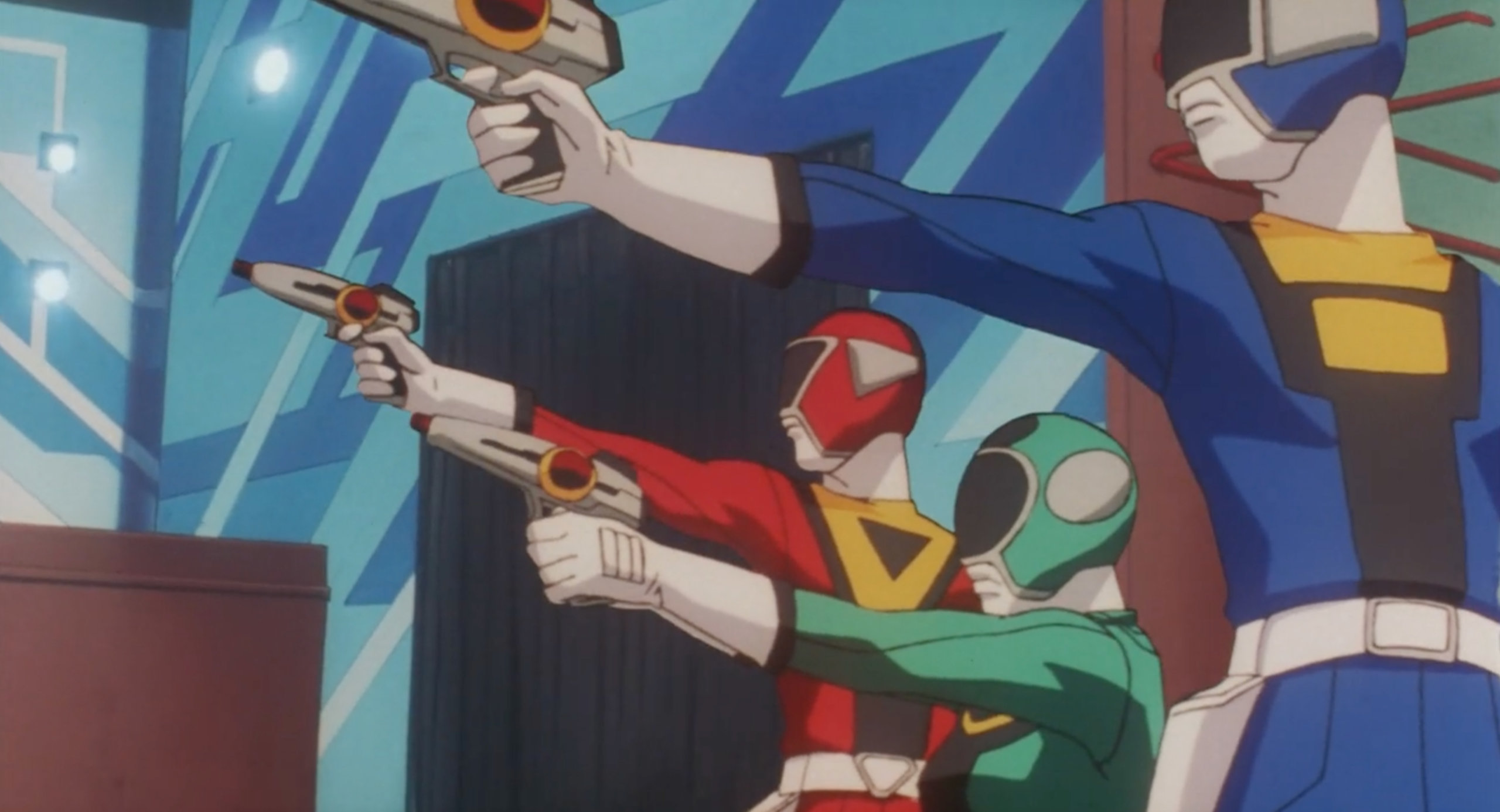
As you can see, the three fighters, which Kon calls the “Powertrons,” are dressed in red, green, and blue outfits. What’s key to Kon in this moment is that each of them are wearing masks—or “a front,” as Kon puts it. “Viewers might not notice until the second time through. And that’s fine,” says Kon, who seems fully aware that nobody in their right mind would pick up on this subtle nod to such an important motif throughout the film.
But, as Kon explains, it was important for him as a director to have this scene play first. While the viewer might not pick up that the Powertrons’s masks are supposed to signal something, it puts Kon the artist in the right frame of mind for the themes that are about to play out. To Kon, these Powertrons’s masks are no different than the “mask” Mima and Rumi wear throughout the film. “The movie is all about the personas people wear,” says Kon, who speaks quite a bit about the definition and latin origins of the word “persona.”
On top of that, the Powertrons are battling a villain named “Kingburg,” aka “the ruler of bugs.” Kon says that the Powertrons are battling to “protect the net,” which Kingburg is looking to disrupt. This echoes how Mima is beset by a “bug.” “She develops ‘bugs’ of her own in her humanity,” says Kon.
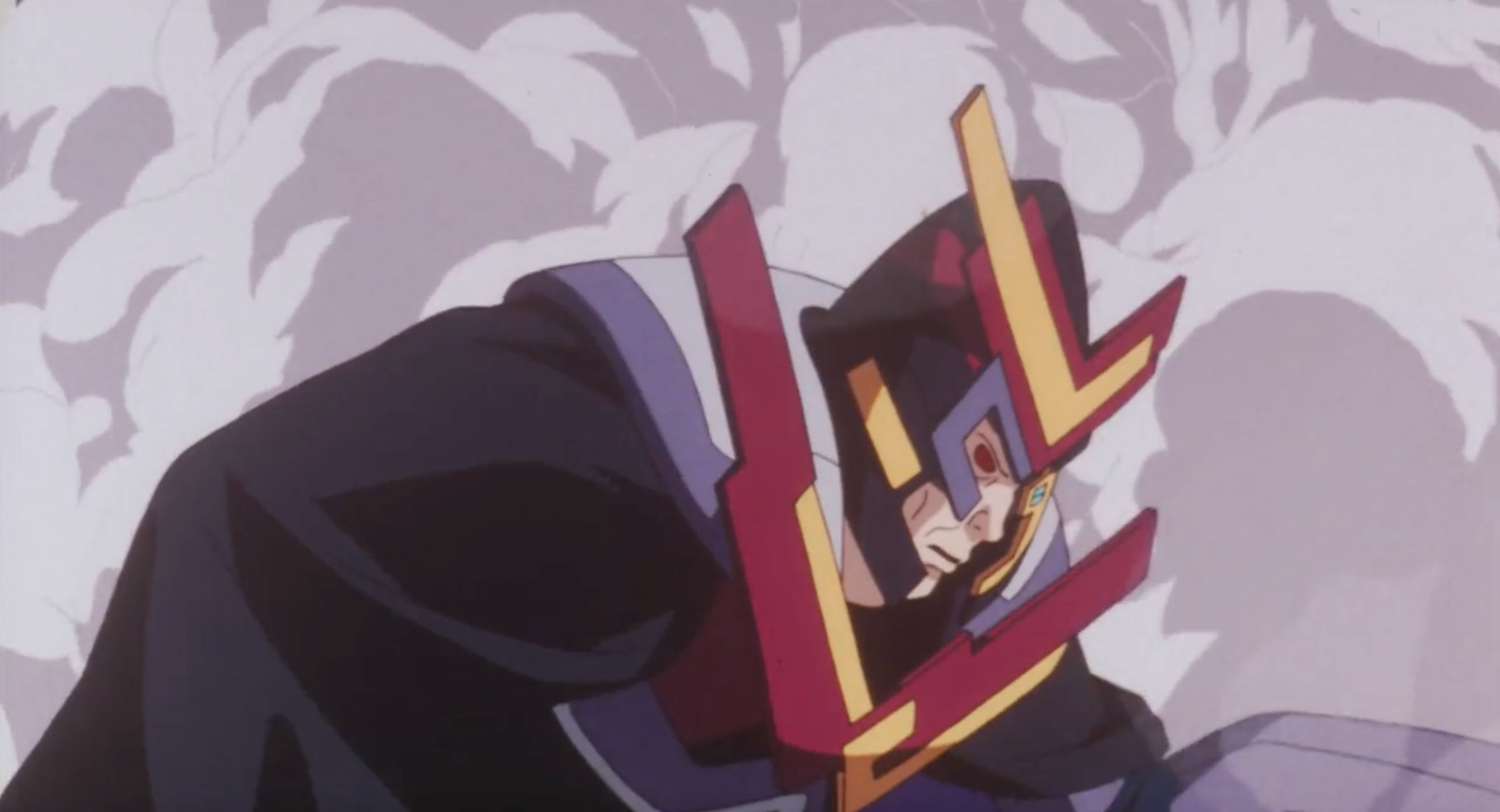
While, again, it seems crazy that anyone would ever make these connections (probably because the movie doesn’t give us any of these details?), it does serve as an interesting peek into the mind of Kon. As an artist, he feels it is necessary to immediately set up one of the major themes of his film. Not for everyone else—for himself.
But now you do know that information…so hopefully it helps you appreciate the movie a little bit more!
The birth of Virtual Mima
The r*pe scene in Perfect Blue is, of course, awful. In the lecture series, Kon himself admits that he went too far. In pre-production, he believed the film would be OVA (which stands for original video animation, meaning it would only be released on home video format) and not be seen by a wider audience. Because of this, he thought the r*pe scene would be raunchy and capture the attention of a smaller audience.
But still, this scene is a very important demarcation point in the film. At the end of the scene, the camera flashes around the movie set and ends with the big bright shining light hanging above Mima. As we discussed heavily in this article, lights serve as an important motif that symbolize various things like identity, perception, and performance. Each instance of lights marks an important moment that signals some major transition with Mima’s character.
And this scene might be the biggest moment of all. Afterwards, Mima is very desolate and removed. We see Mima in her dressing room, sitting in front of the mirror. Kon says that this moment specifically because of two key factors: Mima is wearing black, and she’s in a prayer position.
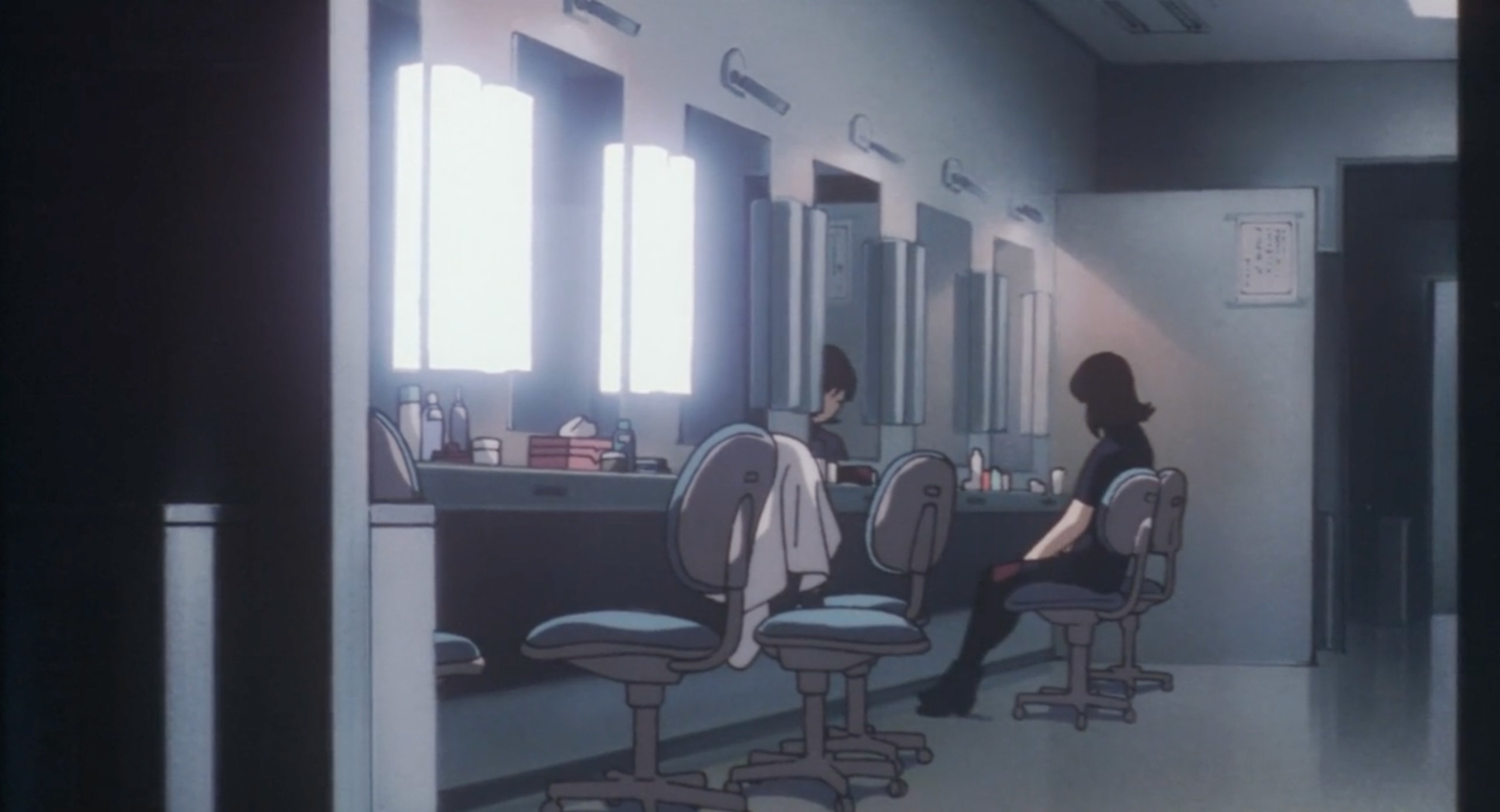
Once again, this might not be something you notice upon first glance. But in Kon’s mind, it was important for Mima to grieve in this moment—to grieve for the death of a part of herself.
In the assault scene, Kon points out that Mima is wearing an costume that closely resembles her CHAM! outfit. That’s because Kon wanted this scene to symbolize the death of Mima’s “idol” self. In her quest to become a movie star, Mima needed to abandon the idol persona and be born anew—and the r*pe scene is how Kon choose to do this.
The very next scene? Mima returns home to her apartment. And what has happened? Her fish have died. And all Mima can do is weep. Yes, she cries for her dead fish. But she also cries for the death of herself. Who had she become? How could she let this happen?
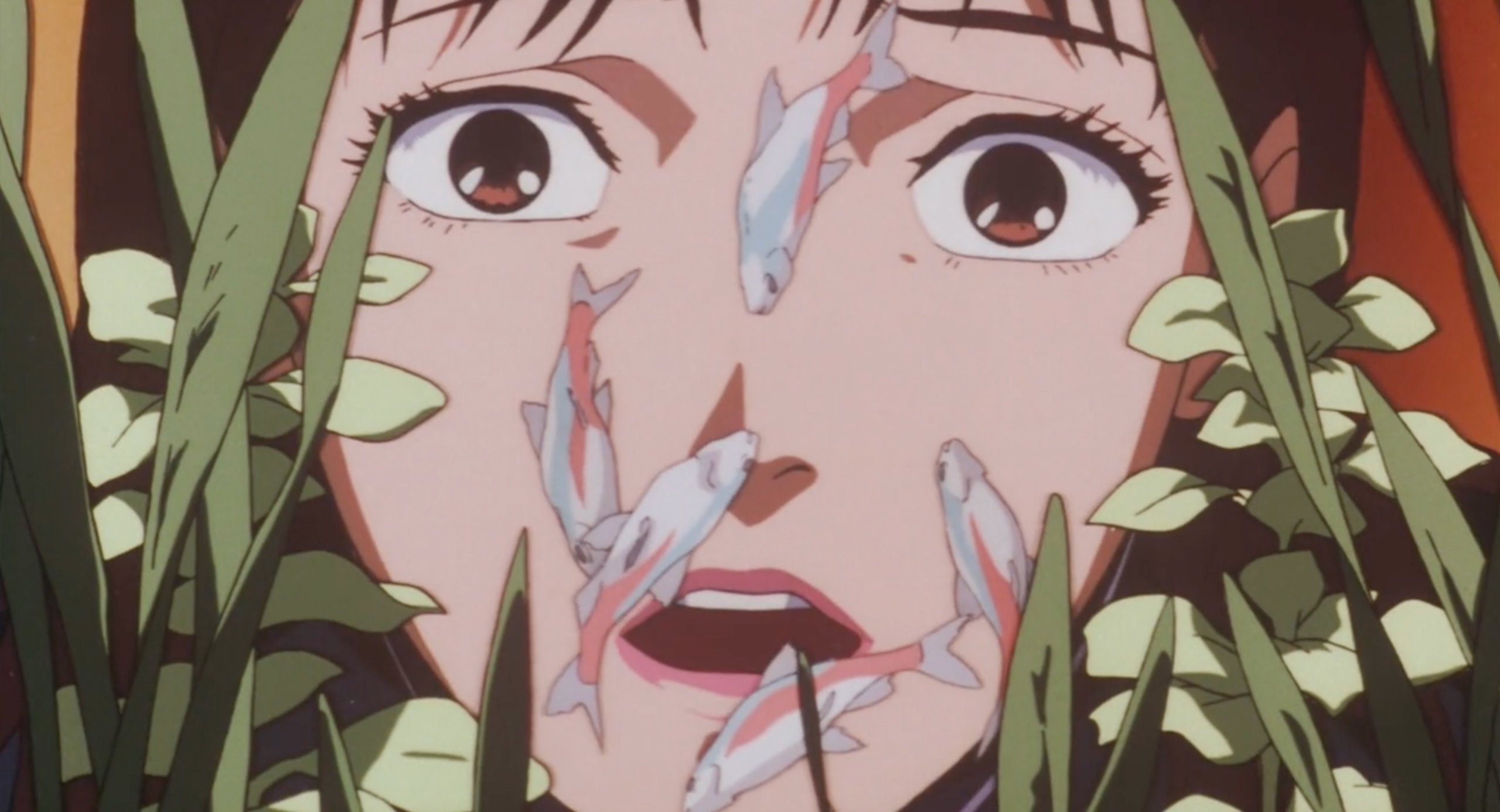
Signal Virtual Mima. In this moment, Mima sees the virtual version of her idol self in her computer screen. For the rest of the movie, Mima will be in a battle with this other part of herself that wants to be revived.

But wait, there’s one more important moment. As Mima sits in her room, we see that two of her fish have actually survived. It turns out, says Kon, that this is one of the most important shots in the movie. In fact, these two fish can be seen on the cover of the LaserDisc jacket for Perfect Blue floating in Mima’s chest.
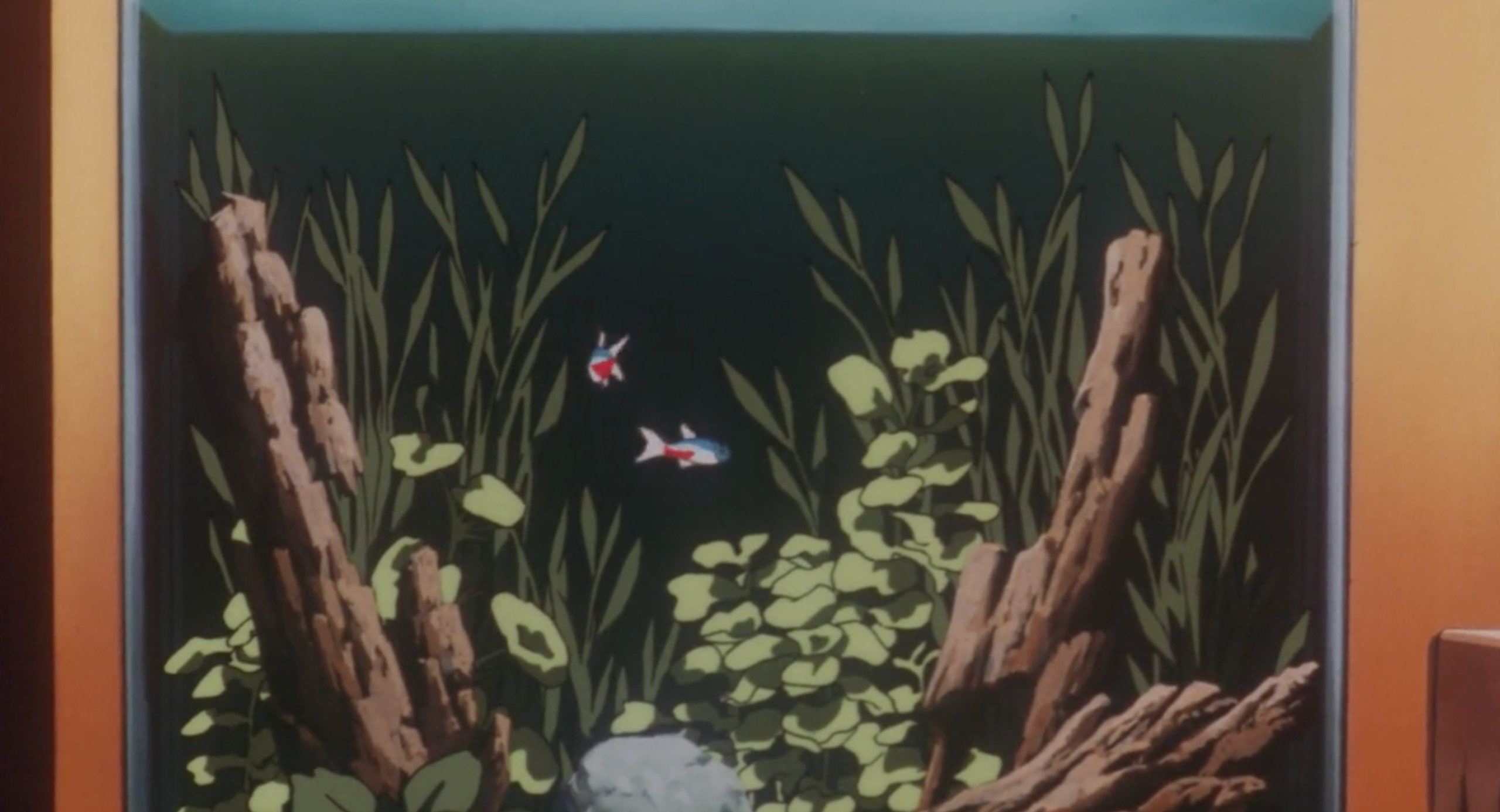
To Kon, these two fish represent Mima’s internal battle with herself. “There are two Mimas,” as Kon bluntly puts it. “The two remaining Mimas fight for survival within her.”
The Epilogue
Weirdly enough, Kon didn’t have much to say about the epilogue scene. In fact, we covered just about everything Kon says in our analysis above.
But there was one very interesting moment where Kon acknowledged that the final shot is open to interpretation. Several people, Kon says, believe that the moment where Mima looks into the rearview mirror of her car and shouts, “I’m real!” is a moment of delusion. That Mima actually did commit all of those murders, and that Mima is stuck in an alternate reality where she’s become a movie star.
I must admit: I thought this could have been a possibility upon first watch. After thinking about it for a while and reflecting on the movie…I don’t think this is true. But I could see how someone could think it is true. In fact, I could be convinced it’s true.
And maybe Kon feels that way as well. While he says this “twist” ending was never his intention, he does believe that the film is open to interpretation. In fact, he thinks that ending would technically work, because he “wanted to imply that it’s never over, that she hasn’t become her true self yet.” While Mima has evaded the murderous Rumi, there are always demons to battle within yourself. The process of growing up never truly ends.
Comparisons between Perfect Blue and Paprika
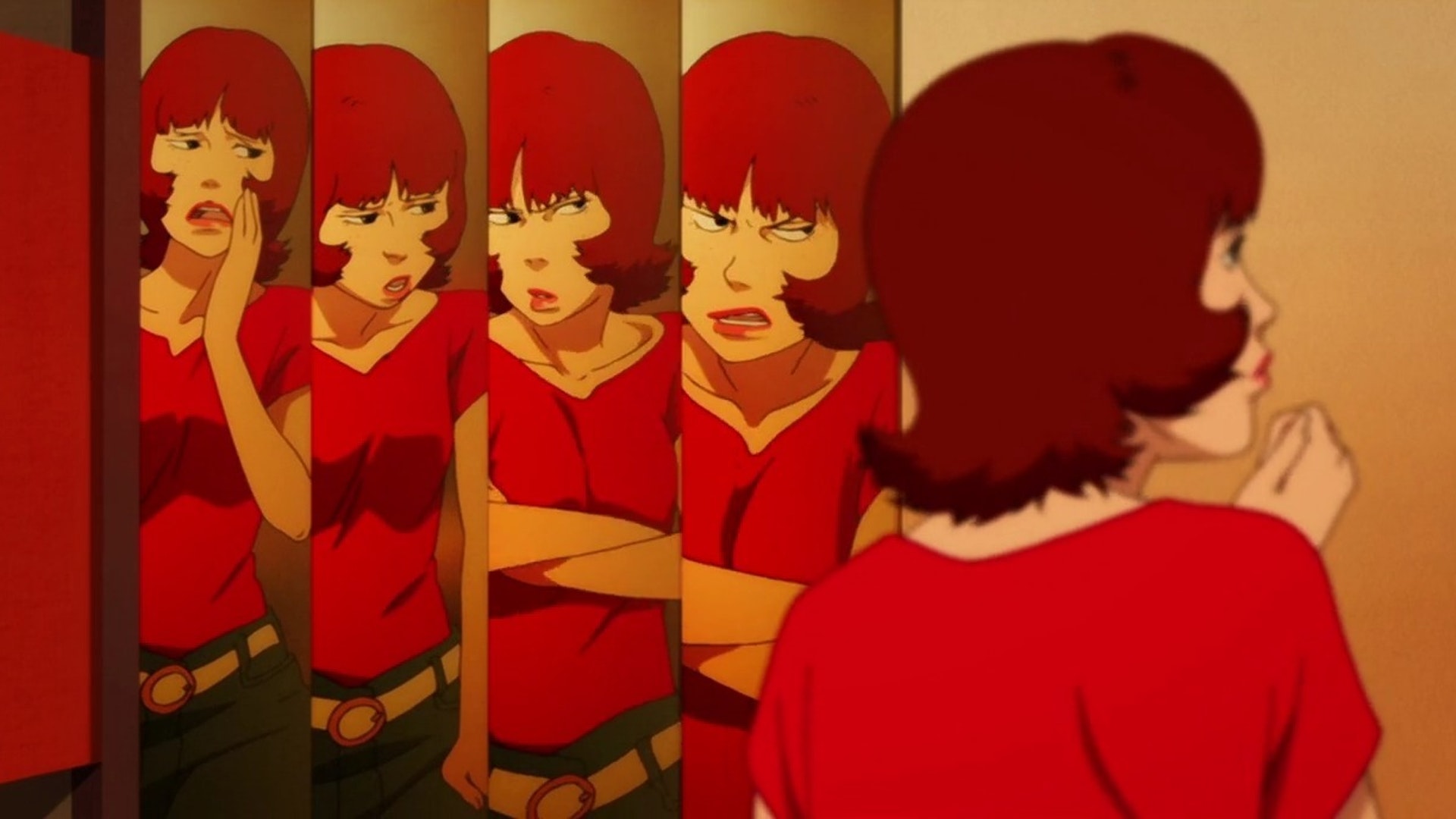
Perfect Blue has gained a cult following over the years. But Satoshi Kon’s most famous movie might have actually been his final one: Paprika. Personally, it’s my favorite Kon film. Actually, it’s one of my favorite movies ever. I love meta films, and Paprika in particular plays with this formula in such a fascinating, moving way. The movie is filled with people who don’t have a complete sense of self, and Kon blurs the line between dream and reality—between film and reality, you could say—to force his characters into confronting their personal struggles.
Here, you can immediately see a connection between Paprika and Perfect Blue. Both Rumi and Mima are fighting to piece themselves back together throughout the movie. While we actively witness Mima challenge herself, we don’t find out until the end that Rumi has been struggling the entire time as well. These are two people who are unsatisfied with their places in the world and feel pressured to achieve an idolized version of themselves.
Perfect Blue is very contained, and specifically concerns itself with celebrity and idolism. While Paprika is more universal, bringing in a dream world setting that consumes everything and everyone in its path. But either way, both movies get at similar ideas. The struggle to become whole, to be satisfied with the direction your life is heading—that’s tough. And when that fight becomes too mentally straining, many people react aggressively and involve others. When these things feel out of our control, we blame the world around us. And sometimes take it out on the world around us.
So if you’re truly looking to better understand Perfect Blue, then I’d recommend watching Paprika and thinking about the similarities they share. The most striking commonality is that Paprika is an alternate persona for the character Chiba. Where Paprika is light, fun, and optimistic, Chiba is often cold, detached, and practical. But by the end, Chiba learns to balance those two sides and allow herself to love Tokita.
Another connection: in Paprika, the internet is a heavy motif. While the internet was in its early days in Perfect Blue—ripe for obsessed fans to control the narrative about their favorite celebrities—the cyberworld is much more established by 2006 when Paprika was released. But in both cases, the internet is a place of escape. In Perfect Blue, the world wide web is a realm where Me-Mania can hole up and obsess over Mima, a place where Rumi can replicate Mima’s life as her own. And in Paprika, the internet is where Otsuka meets with Paprika, who forces him to confront his past. The only way he can learn to fix his reality is by escaping it first. “Don’t you think dreams and the Internet are similar?” Paprika asks Otsuka at one point. “They are both areas where the repressed conscious mind vents.”
That blurred line between dream and reality, between internet and reality? That’s no different than what we see in Perfect Blue. While this theme is heavily laid out in Paprika by the DC Mini, it’s very much a part of Perfect Blue as well. The internet becomes a place where we can escape, where our dreams can become a reality.
Except…it’s not a reality. It’s just a manufactured reality that replicates the promise of our dreams. Eventually we need to return home and perform some real work on ourselves.
The chairman in Paprika can’t handle this idea, so instead tries to make the rest of the world conform to his reality. Likewise, we see Me-Mania and Rumi do something similar by trying to kill Mima. If Mima won’t live up to the standards that they have set for her? Then she has to go. Nothing can stray from how they perceive the world, because those perceptions are crucial to their beings, to the kind of person they’d like to become, to the reality that’s conducive to those aspirations.
These are the main comparisons to draw when watching Paprika, then. How are Me-Mania and Rumi similar to the chairman and Osanai? And how does Mima compare with Chiba and Otsuka? I’ve laid out some broad comparisons here. But as you watch each of these characters’ stories unfold, you’ll start to notice the nuances that Kon transferred from project to project.
By the way. If you’re looking for an explanation to the ending of Paprika, then be sure to check out our article.

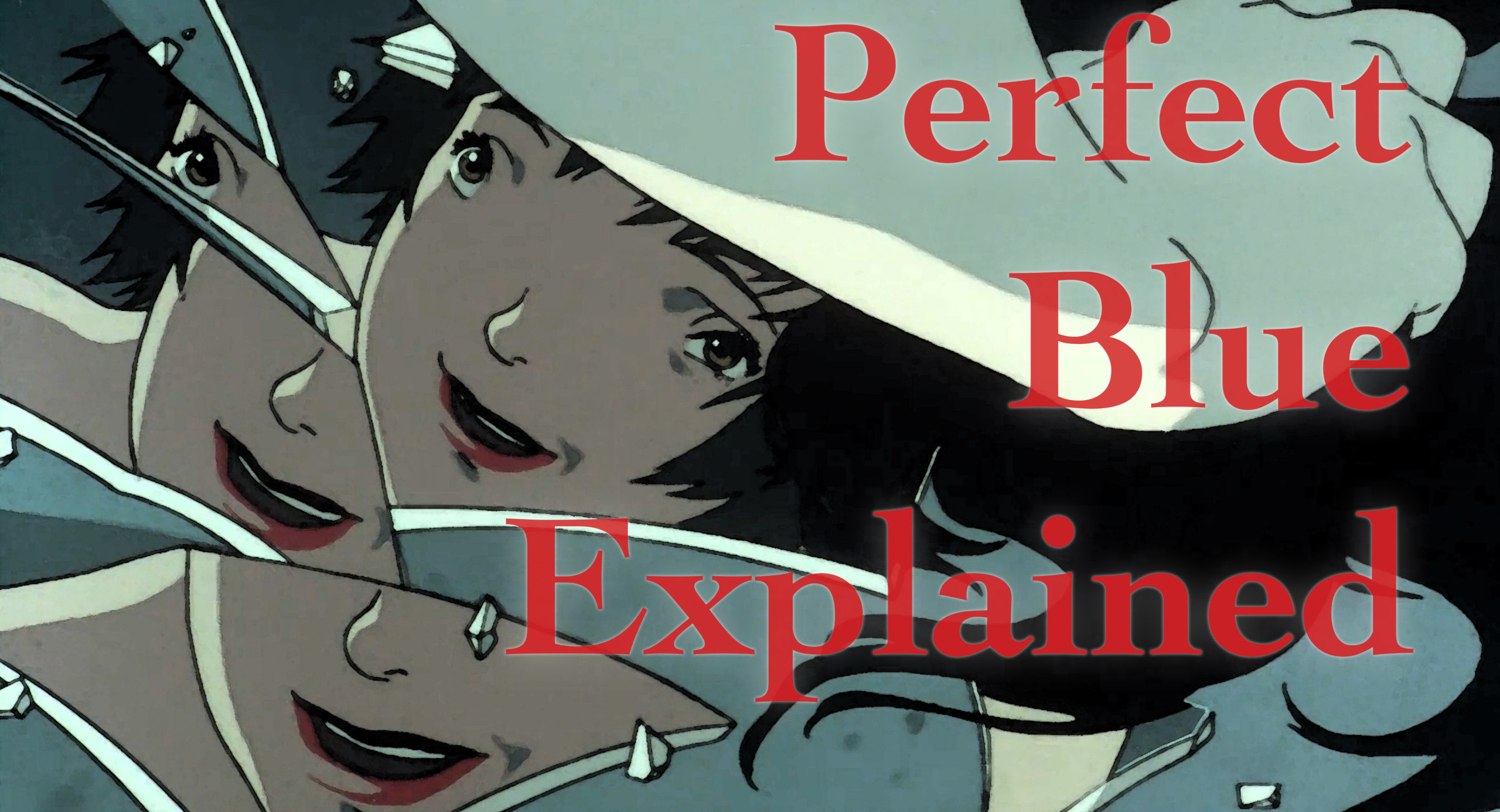
I find it hard to believe Mima did not kill the photographer. It’s the only detailed murder scene shown frame by frame. The movie follows one main character in detail and shows other scenes of characters for minimal time. She awoke from this “dream” in a panic. She thought previous real days of her life were also dreams but realized they were actual days she was losing track of. It is also the only time she has PTSD of one of the victims. You can say the bag she used earlier that day and the clothes she bought in the store (mentioned in Rumi’s blog) were planted but the chain was on the door. All of the clues point to her being the murderer of the photographer. It was left as a mystery for good reason… not to defame the idol.
Thanks for the in-depth analysis. I had someone recommend I watch this after we’d discussed the blurred line between one’s profession and personal life, and I feel like this movie was an experience I needed to have. Recommending this movie is like smelling something horrid and then offering someone else to take a sniff. It’s an offensive, disturbing, and unnerving piece of media, yet it gives a perspective on reality in a way something like Spirited Away can’t.
hahah what an accurate description. Has it impacted how you’ve been thinking about your relationship with your work? Have you made any changes since watching?
Thank you so much for the time and effort you have put into this explanation and all the extra tidbits I haven’t even thought about. This is a really good explanation and while watching perfect blue It did remind me of Black Swan and funnily enough Fight Club as well because of the constant waking up of Mima where we don’t know if she committed murder or not. Anyway you are an expert analyzer I applaud you
Thank you very much! Very nice of you to say!
One character who I wish would be explored more is Tadokoro. This agent of Mima’s is interesting in his ambivalent enthusiasm for making Mima into a “serious” actress, yet he sits there visibly cringing as he watches the fake r*pe scene with Mima unfold, and later offers to take the girl out to dinner for her hard work, which is more of an apology for what he knows he just put her through. He loves Mima as a friend and as an artist, and a part of him knows that he just put her through hell, failing to protect her.
You mention Mexican-American artist Selena becoming more collaborative with a male friend who her female agent, Yolanda, got jealous of. This again mirrors Perfect Blue in that Mima favours Tadokoro’s advice over Rumi’s, and begins to push Rumi aside in a grasp for independence, something that Rumi cannot stand. Tadokoro is in many ways Mima’s protector and guardian, and thus also a barrier to Rumi’s becoming of Mima, as he often treats Rumi like an annoying third wheel who should move on to other projects not involving Mima. It is Tadokoro who points out in the film (the only character who does) that he knows about Rumi’s past as a pop idol who failed to stay relevant in the 1980s. Tadokoro knows who Rumi used to be, and that drives Rumi nuts because Rumi wants to be Mima.
Tadokoro serves as a male divide between the two Mimas, a balancing force who can tell the two ladies apart and ground them both in reality. When he is gone, there’s nobody left to keep Mima or Rumi sane.
There are lots of cases of identity ambiguity in the media world. Selena, of course, or there’s Miley Cyrus, who went from cute Disney pop star to sex symbol swinging around on a giant constructed wrecking ball as a metaphor for… well, use your imagination. Or in Canada there’s Rebecca Maye Holiday, this fiction author who had a plagiarist use a misspelled variant of her birth name to release shoddy copies of her books through Kindle Direct Publishing to make money off them. If you look up Holiday’s most famous book, “Necromancy Cottage”, you’ll see the plagiarist name set as primary on the Google and Goodreads metadata, effectively burying Holiday’s real name and authorship, even though she’s the only one who actually has any documented copyright authority to her own books. What about Daniel Radcliffe? No matter what he does to gain more adult roles, even writing his own poetry, he will always be Harry Potter, and mostly just Harry Potter. The internet gets to decide who Cyrus, Holiday and Radcliffe are in terms of identity, and the internet can trap them if it wants. Sometimes with disastrous, damaging results. That power of the audience over the creator is mirrored in Perfect Blue, with Mima still whispered about asa pop idol and kept trapped as a pop idol due to the internet’s influence. Sure, Mima could hire a reputation defender or sue so that “Mima’s Room” gets taken down, but another might just pop up in its place. Her fans want her to be Mimarin the pop idol, not Mima the actress. She has no choice in how the world chooses to perceive her, only in how she chooses to perceive herself.
Very well said. Yeah, I think there’s a whole conversation about that character to be had. Especially as a lot of the victims in the movie are males in power. Writer, photographer, agent. Rumi and Tadokoro both become pseudo-parents to Mima and there’s all sorts of rabbit holes to go down with the symbolism of that and the Freudness of it all. But, as you point out, Perfect Blue becomes scarily representative of teen stars trying to move past their initial labels and they in which the audience or others want to restrain them or remake them in their own image. That sense of possession is very real.
Just wow
Really wrapped up the whole movie
I’ve been curious about Rumi’s motivations, so this was really helpful! However, I do wish you would have talked about the symbolism of color in the movie, specifically red/blue, as I’m still piecing that out myself. That being said, I notice you seem to want to stick to canon material, so I can understand why you’d leave that out.
I love this explanation. I’m always back and forth as to what I believe regarding the ending, because of the character Me-Mania’s name literally being “me mania.” I thought his character was actually completely imagined at times, Mima’s or Rumi’s mania personified.
Nothing less than absolute gratitude for your insightful analysis of this film. Very well written and articulate thesis.
this is one of the most detailed analyzations i’ve ever read. thank you for publishing this, i was desperately looking for an explanation to the movie and i finally understand the entirety of it now. THANK YOU!
Thank you for the explanation, it was a great read
Thank you so much for this!! 😀
agreed
Wow, that was the best explanation of the movie. I really felt jay dropping moments during your explanation.
Thanks for this
Thanks, Shaurin! What moments stood out to you the most?
I wandered around the Internet for different theories and I have to say this was the most detailed one that made sense!!!
An excellent explanation, probably the best I have read of any movie
agreed